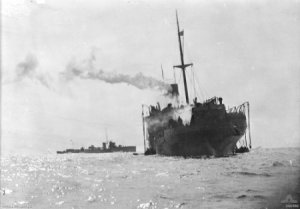There is something fascinating in those pre-dreadnought battleships...the way they look, the way they operate and their fate...13 May 1906 – Launch of Ioann Zlatoust (Russian: Иоанн Златоуст), an Evstafi-class pre-dreadnought battleship of the Imperial Russian Navy's Black Sea Fleet.
-

Win a Free Custom Engraved Brass Coin!!!
As a way to introduce our brass coins to the community, we will raffle off a free coin during the month of August. Follow link ABOVE for instructions for entering.
You are using an out of date browser. It may not display this or other websites correctly.
You should upgrade or use an alternative browser.
You should upgrade or use an alternative browser.
Naval/Maritime History 27th of August - Today in Naval History - Naval / Maritime Events in History
Today in Naval History - Naval / Maritime Events in History
14 May 1917 - The 1917 Battle of the Strait of Otranto was the result of an Austro-Hungarian raid on the Otranto Barrage, an Allied naval blockade of the Strait of Otranto.
The battle took place on 14–15 May 1917, and was the largest surface action in the Adriatic Sea during World War I
The 1917 Battle of the Strait of Otranto was the result of an Austro-Hungarian raid on the Otranto Barrage, an Allied naval blockade of the Strait of Otranto. The battle took place on 14–15 May 1917, and was the largest surface action in the Adriatic Sea during World War I. The Otranto Barrage was a fixed barrier, composed of lightly armed drifters with anti-submarine nets coupled with minefields and supported by Allied naval patrols.
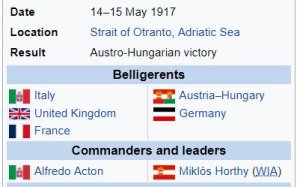

The Austro-Hungarian navy planned to raid the Otranto Barrage with a force of three light cruisers and two destroyers under the command of Commander (later Admiral) Miklós Horthy, in an attempt to break the barrier to allow U-boats freer access to the Mediterranean, and Allied shipping. An Allied force composed of ships from three navies responded to the raid and in the ensuing battle, heavily damaged the Austro-Hungarian cruiser SMS Novara. However, the rapid approach of the Austro-Hungarian relief force persuaded Rear Admiral Acton, the Allied commander, to retreat.

SMS Novara in action
Disposition of forces
Under the command of Horthy, three Austro-Hungarian cruisers (Novara, Saida, and Helgoland, modified to resemble large British destroyers) were ordered to attack the drifters on the night of 14 May and attempt to destroy as many as possible before daybreak. The destroyers Csepel and Balatonwere to mount a diversionary raid off the Albanian coast in order to confuse any Allied counter-attack. Two Austro-Hungarian U-boats—U-4 and U-27, along with the German U-boat UC-25—were to participate in the operation as well. A supporting force composed of the armored cruiser Sankt Georg, two destroyers, and four 250t-class torpedo boats was on standby if the raiders ran into trouble. The old pre-dreadnought battleship SMS Budapest and three more 250t-class torpedo boats were also available if necessary.
An Allied destroyer patrol was in the area on the night of 14 May, to the north of the Barrage. The Italian flotilla leader Mirabello was accompanied by the French destroyers Commandant Rivière, Bisson and Cimeterre. The Italian destroyer Borea was also in the area, escorting a small convoy to Valona. A support force was based in the port of Brindisi, consisting of the British cruisers Dartmouth and Bristol and several French and Italian destroyers.
Raid on the drifters
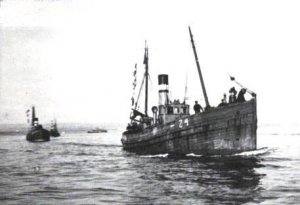
British drifters sailing from their base in the Adriatic to the Barrage
The Italian convoy escorted by Borea was attacked by the Austro-Hungarian destroyers Csepel and Balaton at approximately 03:24. The Austro-Hungarians sank Borea and a munitions ship, and a second was set on fire and abandoned.
The three cruisers were able to pass through the line of drifters, and at 03:30 began attacking the small barrage ships. The Austro-Hungarians frequently gave the drifter crews warning to abandon ship before opening fire. In some instances, the drifter crews chose to fight: Gowan Lee returned fire on the Austro-Hungarian ships. The ship was heavily damaged, but remained afloat; her captain—Joseph Watt—was later awarded the Victoria Cross for his actions during the battle.
There were 47 drifters in Barrage on the night of 14 May; the Austro-Hungarians managed to sink 14 drifters and damage four more. The lack of sufficient Allied escorts forced the withdrawal of the remaining blockading ships, although only for a short time.
Battle
By this time, the Allied naval forces in the area were aware of the raid, and were in a position to block the Austro-Hungarian retreat. Rear Admiral Alfredo Acton—the commanding officer of the Italian Scouting Division—ordered Mirabello's group southward at 04:35, while he embarked on the British light cruiser HMS Dartmouth. By 06:45, the cruisers Dartmouth and Bristol—along with the Italian destroyers Mosto, Pilo, Schiaffino, Acerbi, and Aquila—were sailing north in an attempt to cut off the Austro-Hungarian cruisers. The Italian light cruiser Marsala, the flotilla leader Racchia, and the destroyers Insidioso, Indomito, and Impavido were readying to sail in support as well.
The Mirabello group engaged the Austro-Hungarian cruisers at 07:00, but were heavily outgunned, and instead attempted to shadow the fleeing cruisers. At 07:45, Rear Admiral Acton's ships encountered the destroyers Csepel and Balaton. After 20 minutes, the Italian destroyers were able to close the distance to the Austro-Hungarian ships; the two groups engaged in a short artillery duel before a shot from Csepel struck Aquila and disabled the ship's boilers. By this time, the Austro-Hungarian destroyers were under the cover of the coastal batteries at Durazzo, and were able to make good their escape.
At 09:00, Bristol's lookouts spotted the smoke from the Austro-Hungarian cruisers to the south of her position. The Allied ships turned to engage the Austro-Hungarian ships; the British ships had a superiority both in numbers and in firepower; Dartmouth was armed with eight 6 in (150 mm) guns and Bristol had two 6 inch and ten 4 in (100 mm), compared to the nine 3.9 in (99 mm) guns on each of the Austro-Hungarian ships. Unfortunately for the Allies, their numerical superiority was quickly lost, as their destroyers were either occupied with mechanical problems, or protecting those destroyers suffering from breakdowns. The support forces of both sides—the Sankt Georg group for the Austro-Hungarians, and the Marsala group for the Allies—were quickly dispatched to the battle.
Italian FBA seaplanes from the seaplane carrier Europa shadowed the Austro-Hungarian cruisers and eventually dropped bombs on Helgoland, only scoring a near-miss that dislodged some rivets in her rudder.
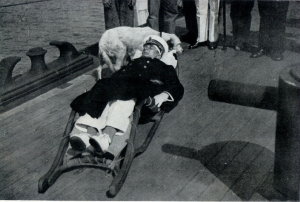
Horthy, seriously wounded, commanded the Austro-Hungarian fleet until falling unconscious.
Dartmouth—faster than Bristol—closed to effective engagement range with the Austro-Hungarian ships, and opened fire. A shell from Dartmouth struck Novara, at which point the Austro-Hungarian ships laid a smoke screen in order to close the distance. Dartmouth was struck several times, and by 11:00, Acton ordered the ship to reduce speed to allow Bristol to catch up. Novara was hit several more times, and her main feed pumps and starboard auxiliary steam pipe had been damaged, which caused the ship to begin losing speed. At 11:05, Acton turned away in an attempt to separate Saida from Novara and Helgoland. At this point, Sankt Georgwas approaching the scene, which prompted Acton to temporarily withdraw to consolidate his forces. This break in the action was enough time for the Austro-Hungarians to save the crippled Novara; Saida took the ship under tow while Helgoland covered them.
Unaware that Novara had been disabled, and fearing that his ships would be drawn too close to the Austrian naval base at Cattaro, Acton broke off the pursuit. The destroyer Acerbi misread the signal, and attempted to launch a torpedo attack, but was driven off by the combined fire of Novara, Saida, and Helgoland. At 12:05, Acton realized the dire situation Novara was in, but by this time, the Sankt Georg group was too close. The Sankt Georg group rendezvoused with Novara, Saida, and Helgoland, and Csepel and Balaton reached the scene as well. The entire group returned to Cattaro together.
At 13:30, the submarine UC-25 torpedoed Dartmouth, causing serious damage. The escorting destroyers forced UC-25 from the area, but Dartmouth had to be abandoned for a period of time, before it could be towed back to port. The French destroyer Boutefeu attempted to pursue the German submarine, but struck a mine laid by UC-25 that morning and sank rapidly.
Aftermath

Monument for "heroes of Otranto battle" on Prevlaka in today Croatia
As a result of the raid, it was decided by the British naval command that unless sufficient destroyers were available to protect the barrage, the drifters would have to be withdrawn at night. The drifters would only be operating for less than twelve hours a day, and would have to leave their positions by 15:00 every day. Despite the damage received by the Austro-Hungarian cruisers during the pursuit by Dartmouth and Bristol, the Austro-Hungarian forces inflicted more serious casualties on the Allied blockade. In addition to the sunk and damaged drifters, the cruiser Dartmouth was nearly sunk by the German submarine UC-25, the French destroyer Boutefeu was mined and sunk, and a munitions convoy to Valona was interdicted.
However, in a strategic sense, the battle had little impact on the war. The barrage was never particularly effective at preventing the U-boat operations of Germany and Austria-Hungary in the first place. The drifters could cover approximately .5 mi (0.80 km) apiece; of the 40 mi (64 km)-wide Strait, only slightly more than half was covered. The raid risked some of the most advanced units of the Austro-Hungarian fleet on an operation that offered minimal strategic returns.
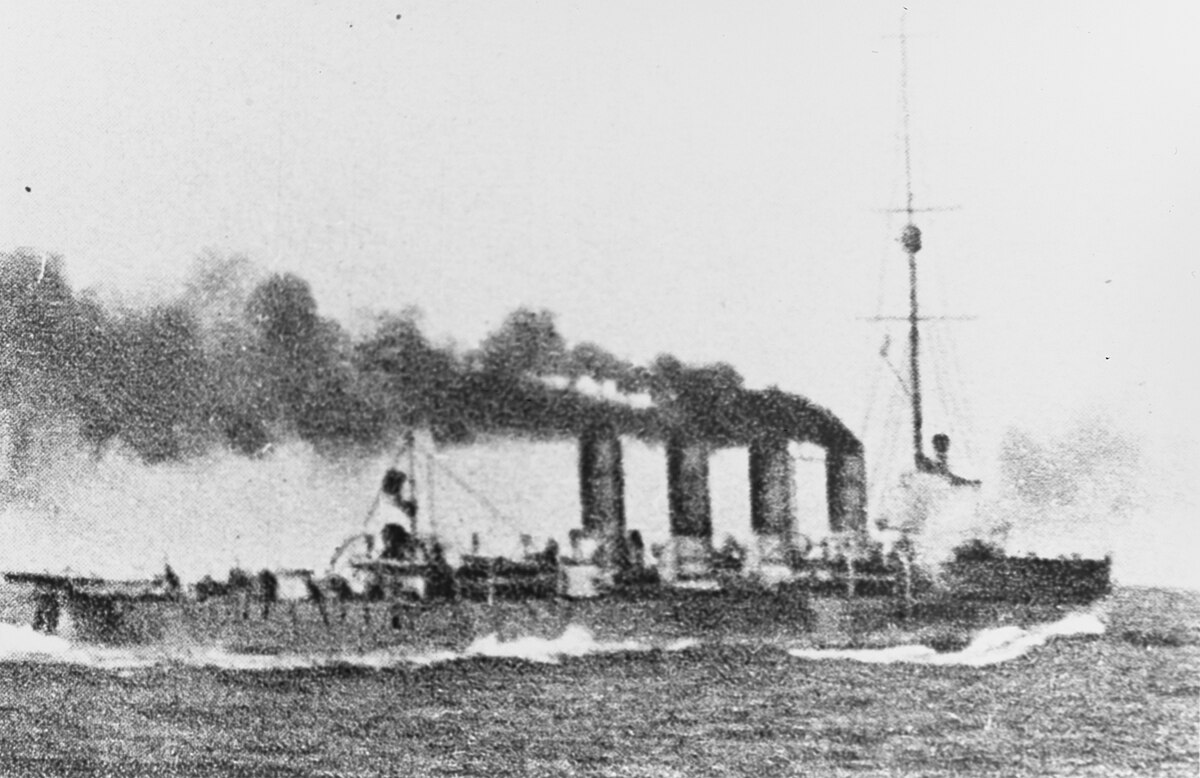
 en.wikipedia.org
en.wikipedia.org
14 May 1917 - The 1917 Battle of the Strait of Otranto was the result of an Austro-Hungarian raid on the Otranto Barrage, an Allied naval blockade of the Strait of Otranto.
The battle took place on 14–15 May 1917, and was the largest surface action in the Adriatic Sea during World War I
The 1917 Battle of the Strait of Otranto was the result of an Austro-Hungarian raid on the Otranto Barrage, an Allied naval blockade of the Strait of Otranto. The battle took place on 14–15 May 1917, and was the largest surface action in the Adriatic Sea during World War I. The Otranto Barrage was a fixed barrier, composed of lightly armed drifters with anti-submarine nets coupled with minefields and supported by Allied naval patrols.


The Austro-Hungarian navy planned to raid the Otranto Barrage with a force of three light cruisers and two destroyers under the command of Commander (later Admiral) Miklós Horthy, in an attempt to break the barrier to allow U-boats freer access to the Mediterranean, and Allied shipping. An Allied force composed of ships from three navies responded to the raid and in the ensuing battle, heavily damaged the Austro-Hungarian cruiser SMS Novara. However, the rapid approach of the Austro-Hungarian relief force persuaded Rear Admiral Acton, the Allied commander, to retreat.

SMS Novara in action
Disposition of forces
Under the command of Horthy, three Austro-Hungarian cruisers (Novara, Saida, and Helgoland, modified to resemble large British destroyers) were ordered to attack the drifters on the night of 14 May and attempt to destroy as many as possible before daybreak. The destroyers Csepel and Balatonwere to mount a diversionary raid off the Albanian coast in order to confuse any Allied counter-attack. Two Austro-Hungarian U-boats—U-4 and U-27, along with the German U-boat UC-25—were to participate in the operation as well. A supporting force composed of the armored cruiser Sankt Georg, two destroyers, and four 250t-class torpedo boats was on standby if the raiders ran into trouble. The old pre-dreadnought battleship SMS Budapest and three more 250t-class torpedo boats were also available if necessary.
An Allied destroyer patrol was in the area on the night of 14 May, to the north of the Barrage. The Italian flotilla leader Mirabello was accompanied by the French destroyers Commandant Rivière, Bisson and Cimeterre. The Italian destroyer Borea was also in the area, escorting a small convoy to Valona. A support force was based in the port of Brindisi, consisting of the British cruisers Dartmouth and Bristol and several French and Italian destroyers.
Raid on the drifters

British drifters sailing from their base in the Adriatic to the Barrage
The Italian convoy escorted by Borea was attacked by the Austro-Hungarian destroyers Csepel and Balaton at approximately 03:24. The Austro-Hungarians sank Borea and a munitions ship, and a second was set on fire and abandoned.
The three cruisers were able to pass through the line of drifters, and at 03:30 began attacking the small barrage ships. The Austro-Hungarians frequently gave the drifter crews warning to abandon ship before opening fire. In some instances, the drifter crews chose to fight: Gowan Lee returned fire on the Austro-Hungarian ships. The ship was heavily damaged, but remained afloat; her captain—Joseph Watt—was later awarded the Victoria Cross for his actions during the battle.
There were 47 drifters in Barrage on the night of 14 May; the Austro-Hungarians managed to sink 14 drifters and damage four more. The lack of sufficient Allied escorts forced the withdrawal of the remaining blockading ships, although only for a short time.
Battle
By this time, the Allied naval forces in the area were aware of the raid, and were in a position to block the Austro-Hungarian retreat. Rear Admiral Alfredo Acton—the commanding officer of the Italian Scouting Division—ordered Mirabello's group southward at 04:35, while he embarked on the British light cruiser HMS Dartmouth. By 06:45, the cruisers Dartmouth and Bristol—along with the Italian destroyers Mosto, Pilo, Schiaffino, Acerbi, and Aquila—were sailing north in an attempt to cut off the Austro-Hungarian cruisers. The Italian light cruiser Marsala, the flotilla leader Racchia, and the destroyers Insidioso, Indomito, and Impavido were readying to sail in support as well.
The Mirabello group engaged the Austro-Hungarian cruisers at 07:00, but were heavily outgunned, and instead attempted to shadow the fleeing cruisers. At 07:45, Rear Admiral Acton's ships encountered the destroyers Csepel and Balaton. After 20 minutes, the Italian destroyers were able to close the distance to the Austro-Hungarian ships; the two groups engaged in a short artillery duel before a shot from Csepel struck Aquila and disabled the ship's boilers. By this time, the Austro-Hungarian destroyers were under the cover of the coastal batteries at Durazzo, and were able to make good their escape.
At 09:00, Bristol's lookouts spotted the smoke from the Austro-Hungarian cruisers to the south of her position. The Allied ships turned to engage the Austro-Hungarian ships; the British ships had a superiority both in numbers and in firepower; Dartmouth was armed with eight 6 in (150 mm) guns and Bristol had two 6 inch and ten 4 in (100 mm), compared to the nine 3.9 in (99 mm) guns on each of the Austro-Hungarian ships. Unfortunately for the Allies, their numerical superiority was quickly lost, as their destroyers were either occupied with mechanical problems, or protecting those destroyers suffering from breakdowns. The support forces of both sides—the Sankt Georg group for the Austro-Hungarians, and the Marsala group for the Allies—were quickly dispatched to the battle.
Italian FBA seaplanes from the seaplane carrier Europa shadowed the Austro-Hungarian cruisers and eventually dropped bombs on Helgoland, only scoring a near-miss that dislodged some rivets in her rudder.

Horthy, seriously wounded, commanded the Austro-Hungarian fleet until falling unconscious.
Dartmouth—faster than Bristol—closed to effective engagement range with the Austro-Hungarian ships, and opened fire. A shell from Dartmouth struck Novara, at which point the Austro-Hungarian ships laid a smoke screen in order to close the distance. Dartmouth was struck several times, and by 11:00, Acton ordered the ship to reduce speed to allow Bristol to catch up. Novara was hit several more times, and her main feed pumps and starboard auxiliary steam pipe had been damaged, which caused the ship to begin losing speed. At 11:05, Acton turned away in an attempt to separate Saida from Novara and Helgoland. At this point, Sankt Georgwas approaching the scene, which prompted Acton to temporarily withdraw to consolidate his forces. This break in the action was enough time for the Austro-Hungarians to save the crippled Novara; Saida took the ship under tow while Helgoland covered them.
Unaware that Novara had been disabled, and fearing that his ships would be drawn too close to the Austrian naval base at Cattaro, Acton broke off the pursuit. The destroyer Acerbi misread the signal, and attempted to launch a torpedo attack, but was driven off by the combined fire of Novara, Saida, and Helgoland. At 12:05, Acton realized the dire situation Novara was in, but by this time, the Sankt Georg group was too close. The Sankt Georg group rendezvoused with Novara, Saida, and Helgoland, and Csepel and Balaton reached the scene as well. The entire group returned to Cattaro together.
At 13:30, the submarine UC-25 torpedoed Dartmouth, causing serious damage. The escorting destroyers forced UC-25 from the area, but Dartmouth had to be abandoned for a period of time, before it could be towed back to port. The French destroyer Boutefeu attempted to pursue the German submarine, but struck a mine laid by UC-25 that morning and sank rapidly.
Aftermath

Monument for "heroes of Otranto battle" on Prevlaka in today Croatia
As a result of the raid, it was decided by the British naval command that unless sufficient destroyers were available to protect the barrage, the drifters would have to be withdrawn at night. The drifters would only be operating for less than twelve hours a day, and would have to leave their positions by 15:00 every day. Despite the damage received by the Austro-Hungarian cruisers during the pursuit by Dartmouth and Bristol, the Austro-Hungarian forces inflicted more serious casualties on the Allied blockade. In addition to the sunk and damaged drifters, the cruiser Dartmouth was nearly sunk by the German submarine UC-25, the French destroyer Boutefeu was mined and sunk, and a munitions convoy to Valona was interdicted.
However, in a strategic sense, the battle had little impact on the war. The barrage was never particularly effective at preventing the U-boat operations of Germany and Austria-Hungary in the first place. The drifters could cover approximately .5 mi (0.80 km) apiece; of the 40 mi (64 km)-wide Strait, only slightly more than half was covered. The raid risked some of the most advanced units of the Austro-Hungarian fleet on an operation that offered minimal strategic returns.

Battle of the Strait of Otranto (1917) - Wikipedia
Today in Naval History - Naval / Maritime Events in History
14 May 1918 - 1918 - HMS Phoenix, an Acheron-class destroyer of the British Royal Navy, was the only British warship ever to be sunk by the Austro-Hungarian Navy.
HMS Phoenix was an Acheron-class destroyer of the British Royal Navy. She is named for the mythical bird, and was the fifteenth ship of the Royal Navy to bear the name. She was the only British warship ever to be sunk by the Austro-Hungarian Navy
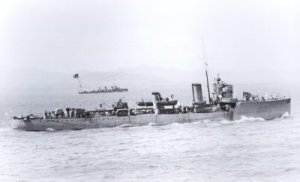
Design
The Acheron-class (redesignated the I-class in October 1913) was an improved version of the Acorn-class destroyer which had been built for the Royal Navy under the 1909–1910 shipbuilding programme. Fourteen destroyers were ordered for the Royal Navy to the standard Admiralty design, with six more as 'builder's specials', to the design of specialist destroyer shipyards, later followed by three more high-speed specials and six for Australia.
The Acherons were 246 ft (74.98 m) long overall, with a beam of 25 feet 8 inches (7.82 m) and a draught of 9 feet (2.7 m). Displacement was about 773 long tons (785 t) legend and 990 long tons (1,010 t)} deep load. Three Yarrow water-tube boilers fed steam to Parsons steam turbines which drove three shafts. The machinery was rated at 13,500 shaft horsepower (10,100 kW), giving a speed of 27 knots (31 mph; 50 km/h). Two funnels were fitted.
The ships were armed with two 4-inch (102 mm) BL Mk VIII on the centreline and two 12-pounder 12 cwt[a] guns on the ship's beam. Two single 21-inch (533 mm) torpedo tubes were fitted. The ships had a complement of 72 men.
Phoenix was laid down at Vickers' Barrow-in-Furness shipyard on 4 January 1911, was launched on 9 October 1911 and was completed in May 1912.
Career
At the beginning of the First World War, Phoenix was part of the First Destroyer Flotilla operating in the North Sea. She and her sisters were attached to the Grand Fleet as soon as the war started.
Action on 16 August 1914
On 16 August 1914, within days of the outbreak of war, the First Destroyer Flotilla engaged an enemy cruiser off the mouth of the Elbe, which is reported with great verve by an author writing under the pseudonym "Clinker Knocker" in 1938:
The Battle of Heligoland Bight
She was present with First Destroyer Flotilla on 28 August 1914 at the Battle of Heligoland Bight, led by the light cruiser Fearless.[9] Phoenix suffered one man wounded during the action
The Battle of Dogger Bank
On 24 January 1915 Phoenix took part in the Battle of Dogger Bank, and her crew shared in the Prize Money for the German armoured cruiser Blücher.
The Battle of Jutland
Phoenix was not present with her flotilla at the Battle of Jutland on 31 May 1916.
HMAT Ballarat
Phoenix was escorting the Australian troopship Ballarat when she was attacked by a German submarine on Anzac Day (25 April) 1917 in the English Channel. Although efforts were made to tow Ballarat to shallow water, she sank off The Lizard the following morning. No lives were lost of the 1,752 souls on board, a striking testament to the calmness and discipline of the troops.
Mediterranean Service
In September 1917, Phoenix transferred to the Fifth Destroyer Flotilla which was operating in the Mediterranean. This posting was to be her last.[13]
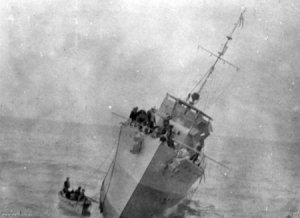
HMS Phoenix lists to port after being torpedoed, viewed from HMAS Warrego
Loss
At 9:18 on 14 May 1918, while patrolling the Otranto Barrage, the Phoenix was torpedoed amidships by the Austro-Hungarian submarine SM U-27, HMAS Warrego made an unsuccessful attempt to tow her to Valona (now Vlorë in Albania), but she sank within sight of the port at 13:10. The crew had been taken off before she capsized, and there were only two fatalities; a Leading Stoker and an Engine Room Artificer.
SM U-27 or U-XXVII was the lead boat of the U-27 class of U-boats or submarines for the Austro-Hungarian Navy. U-27 was built by the Austrian firm of Cantiere Navale Triestino (CNT) at the Pola Navy Yard and launched on 19 October 1916. She was commissioned on 24 February 1917.

She had a single hull and was just over 121 feet (37 m) in length. She displaced nearly 265 metric tons (261 long tons) when surfaced and over 300 metric tons (295 long tons) when submerged. Her two diesel engines moved her at up to 9 knots (17 km/h) on the surface, while her twin electric motorspropelled her at up to 7.5 knots (13.9 km/h) while underwater. She was armed with two bow torpedo tubes and could carry a load of up to four torpedoes. She was also equipped with a 75 mm (3.0 in) deck gun and a machine gun.
During her service career, U-27 sank the British destroyer Phoenix, damaged the Japanese destroyer Sakaki, and sank or captured 34 other ships totaling 14,386 GRT. U-27 was surrendered at Pola at war's end and handed over to Italy as a war reparation in 1919. She was broken up the following year. Conway's All the World's Fighting Ships, 1906–1921 calls U-27 Austria-Hungary's "most successful submarine".
https://en.wikipedia.org/wiki/HMS_Phoenix_(1911)

 en.wikipedia.org
en.wikipedia.org
14 May 1918 - 1918 - HMS Phoenix, an Acheron-class destroyer of the British Royal Navy, was the only British warship ever to be sunk by the Austro-Hungarian Navy.
HMS Phoenix was an Acheron-class destroyer of the British Royal Navy. She is named for the mythical bird, and was the fifteenth ship of the Royal Navy to bear the name. She was the only British warship ever to be sunk by the Austro-Hungarian Navy

Design
The Acheron-class (redesignated the I-class in October 1913) was an improved version of the Acorn-class destroyer which had been built for the Royal Navy under the 1909–1910 shipbuilding programme. Fourteen destroyers were ordered for the Royal Navy to the standard Admiralty design, with six more as 'builder's specials', to the design of specialist destroyer shipyards, later followed by three more high-speed specials and six for Australia.
The Acherons were 246 ft (74.98 m) long overall, with a beam of 25 feet 8 inches (7.82 m) and a draught of 9 feet (2.7 m). Displacement was about 773 long tons (785 t) legend and 990 long tons (1,010 t)} deep load. Three Yarrow water-tube boilers fed steam to Parsons steam turbines which drove three shafts. The machinery was rated at 13,500 shaft horsepower (10,100 kW), giving a speed of 27 knots (31 mph; 50 km/h). Two funnels were fitted.
The ships were armed with two 4-inch (102 mm) BL Mk VIII on the centreline and two 12-pounder 12 cwt[a] guns on the ship's beam. Two single 21-inch (533 mm) torpedo tubes were fitted. The ships had a complement of 72 men.
Phoenix was laid down at Vickers' Barrow-in-Furness shipyard on 4 January 1911, was launched on 9 October 1911 and was completed in May 1912.
Career
At the beginning of the First World War, Phoenix was part of the First Destroyer Flotilla operating in the North Sea. She and her sisters were attached to the Grand Fleet as soon as the war started.
Action on 16 August 1914
On 16 August 1914, within days of the outbreak of war, the First Destroyer Flotilla engaged an enemy cruiser off the mouth of the Elbe, which is reported with great verve by an author writing under the pseudonym "Clinker Knocker" in 1938:
| “ | On Aug 16th we had our first brush with the enemy, and our flotilla received a sample of German gunnery which our own gunners acknowledged was excellent. We were on our usual Dutch coast patrol, known as the 'broad fourteens' and were somewhere off the mouth of the river Elbe off the German coast. At daybreak we chased a German collier and made contact with a powerful armoured cruiser, which opened fire on us with 8.2 inch guns. Our heaviest gun was four-inch, so the enemy easily outranged us, and straddled us with her accurate salvo firing. The Goshawk and Phoenix were disabled, and shells were ricochetting over us. Fearless led us in a determined attack to close with torpedos, but the large German Cruiser foiled our intentions by running for home, and we did not blame her. We were very disappointed, however at not being able to equalise matters with the third flotilla, but the Yorch or Roon or whichever ship it may have been was too near home for us to follow, and we left the vicinity after the Goshawk and Phoenix had patched up their wounds. | ” |
| — Aye, Aye, Sir, a saga of the lower deck by Clinker Knocke |
The Battle of Heligoland Bight
She was present with First Destroyer Flotilla on 28 August 1914 at the Battle of Heligoland Bight, led by the light cruiser Fearless.[9] Phoenix suffered one man wounded during the action
The Battle of Dogger Bank
On 24 January 1915 Phoenix took part in the Battle of Dogger Bank, and her crew shared in the Prize Money for the German armoured cruiser Blücher.
The Battle of Jutland
Phoenix was not present with her flotilla at the Battle of Jutland on 31 May 1916.
HMAT Ballarat
Phoenix was escorting the Australian troopship Ballarat when she was attacked by a German submarine on Anzac Day (25 April) 1917 in the English Channel. Although efforts were made to tow Ballarat to shallow water, she sank off The Lizard the following morning. No lives were lost of the 1,752 souls on board, a striking testament to the calmness and discipline of the troops.
Mediterranean Service
In September 1917, Phoenix transferred to the Fifth Destroyer Flotilla which was operating in the Mediterranean. This posting was to be her last.[13]

HMS Phoenix lists to port after being torpedoed, viewed from HMAS Warrego
Loss
At 9:18 on 14 May 1918, while patrolling the Otranto Barrage, the Phoenix was torpedoed amidships by the Austro-Hungarian submarine SM U-27, HMAS Warrego made an unsuccessful attempt to tow her to Valona (now Vlorë in Albania), but she sank within sight of the port at 13:10. The crew had been taken off before she capsized, and there were only two fatalities; a Leading Stoker and an Engine Room Artificer.
SM U-27 or U-XXVII was the lead boat of the U-27 class of U-boats or submarines for the Austro-Hungarian Navy. U-27 was built by the Austrian firm of Cantiere Navale Triestino (CNT) at the Pola Navy Yard and launched on 19 October 1916. She was commissioned on 24 February 1917.

She had a single hull and was just over 121 feet (37 m) in length. She displaced nearly 265 metric tons (261 long tons) when surfaced and over 300 metric tons (295 long tons) when submerged. Her two diesel engines moved her at up to 9 knots (17 km/h) on the surface, while her twin electric motorspropelled her at up to 7.5 knots (13.9 km/h) while underwater. She was armed with two bow torpedo tubes and could carry a load of up to four torpedoes. She was also equipped with a 75 mm (3.0 in) deck gun and a machine gun.
During her service career, U-27 sank the British destroyer Phoenix, damaged the Japanese destroyer Sakaki, and sank or captured 34 other ships totaling 14,386 GRT. U-27 was surrendered at Pola at war's end and handed over to Italy as a war reparation in 1919. She was broken up the following year. Conway's All the World's Fighting Ships, 1906–1921 calls U-27 Austria-Hungary's "most successful submarine".
https://en.wikipedia.org/wiki/HMS_Phoenix_(1911)

SM U-27 (Austria-Hungary) - Wikipedia
Today in Naval History - Naval / Maritime Events in History
14 May 1943 – World War II: A Japanese submarine sinks AHS Centaur off the coast of Queensland.
Australian Hospital Ship (AHS) Centaur was a hospital ship which was attacked and sunk by a Japanese submarine off the coast of Queensland, Australia, on 14 May 1943. Of the 332 medical personnel and civilian crew aboard, 268 died, including 63 of the 65 army personnel.
The Scottish-built vessel was launched in 1924 as a combination passenger liner and refrigerated cargo ship and operated a trade route between Western Australia and Singapore via the Dutch East Indies (now Indonesia), carrying passengers, cargo, and livestock. At the start of World War II, Centaur (like all British Merchant Navy vessels) was placed under British Admiralty control, but after being fitted with defensive equipment, was allowed to continue normal operations. In November 1941, the ship rescued German survivors of the engagement between Kormoran and HMAS Sydney. Centaur was relocated to Australia's east coast in October 1942, and used to transport materiel to New Guinea.
In January 1943, Centaur was handed over to the Australian military for conversion into a hospital ship, as the ship's small size made her suitable for operating in Maritime Southeast Asia. The refit (including installation of medical facilities and repainting with Red Cross markings) was completed in March, and the ship undertook a trial voyage: transporting wounded from Townsville to Brisbane, then from Port Moresby to Brisbane. After replenishing in Sydney, Centaur embarked the 2/12th Field Ambulance for transport to New Guinea, and sailed on 12 May. Before dawn on 14 May 1943, during her second voyage, Centaur was torpedoed and sunk by a Japanese submarine off North Stradbroke Island, Queensland. The majority of the 332 aboard died in the attack; the 64 survivors were discovered 36 hours later. The incident resulted in public outrage as attacking a hospital ship is considered a war crime under the 1907 Hague Convention. Protests were made by the Australian and British governments to Japan and efforts were made to discover the people responsible so they could be tried at a war crimes tribunal. In the 1970s the probable identity of the attacking submarine, I-177, became public.
The reason for the attack is unknown, with theories that Centaur was in breach of the international conventions that should have protected her, that I-177's commander was unaware that Centaur was a hospital ship, or that the submarine commander knowingly attacked a protected vessel. The wreck of Centaur was found on 20 December 2009; a claimed discovery in 1995 had been proven to be a different shipwreck.

AHS Centaur following her conversion to a hospital ship. The Red Cross designation "47" can be seen on the bow.
Sinking
At approximately 4:10 am on 14 May 1943, while on her second run from Sydney to Port Moresby, Centaur was torpedoed by an unsighted submarine. The torpedo struck the portside oil fuel tank approximately 2 metres (6 ft 7 in) below the waterline, creating a hole 8 to 10 metres (26 to 33 ft) across, igniting the fuel, and setting the ship on fire from the bridge aft. Many of those on board were immediately killed by concussion or perished in the inferno. Centaur quickly took on water through the impact site, rolled to port, then sank bow-first, submerging completely in less than three minutes. The rapid sinking prevented the deployment of lifeboats, although two broke off from Centaur as she sank, along with several damaged liferafts.
According to the position extrapolated by Second Officer Gordon Rippon from the 4:00 am dead reckoning position, Centaur was attacked approximately 24 nautical miles (44 km; 28 mi) east-northeast of Point Lookout, North Stradbroke Island, Queensland. Doubts were initially cast on the accuracy of both the calculated point of sinking and the dead reckoning position, but the 2009 discovery of the wreck found both to be correct, with Centaur located within 1 nautical mile (1.9 km; 1.2 mi) of Rippon's coordinates.

The survivors spent 36 hours in the water, using barrels, wreckage, and the two damaged lifeboats for flotation. During this time, they drifted approximately 19.6 nautical miles (36.3 km; 22.6 mi) north east of Centaur's calculated point of sinking and spread out over an area of 2 nautical miles (3.7 km; 2.3 mi). The survivors saw at least four ships and several aircraft, but could not attract their attention.
At the time of rescue, the survivors were in two large and three small groups, with several more floating alone. Amongst those rescued were Sister Ellen Savage, the only surviving nurse from 12 aboard; Leslie Outridge, the only surviving doctor from 18 aboard; Gordon Rippon, second officer and most senior surviving crew member; and Richard Salt, the Torres Strait ship pilot. In 1944, Ellen Savage was presented with the George Medal for providing medical care, boosting morale, and displaying courage during the wait for rescue.
Rescue
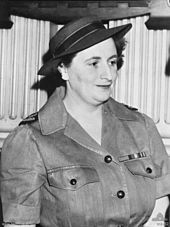
Sister Ellen Savage was the sole survivor of the 12 female nurses on board Centaur.
On the morning of 15 May 1943, the American destroyer USS Mugford departed Brisbane to escort the 11,063 ton New Zealand freighter Sussex on the first stage of the latter's trans-Tasman voyage. At 2:00 pm, a lookout aboard Mugford reported an object on the horizon. Around the same time, a Royal Australian Air Force Avro Ansonof No. 71 Squadron, flying ahead on anti-submarine watch, dived towards the object. The aircraft returned to the two ships and signalled that there were shipwreck survivors in the water requiring rescue. Mugford's commanding officer ordered Sussex to continue alone as Mugford collected the survivors. Marksmen were positioned around the ship to shoot sharks, and sailors stood ready to dive in and assist the wounded. Mugford's medics inspected each person as they came aboard and provided necessary medical care. The American crew learned from the first group of survivors that they were from the hospital ship Centaur.
At 2:14 pm, Mugford made contact with the Naval Officer-in-Charge in Brisbane, and announced that the ship was recovering survivors from Centaur at 27°03′S 154°12′E, the first that anyone in Australia had knowledge of the attack on the hospital ship. The rescue of the 64 survivors took an hour and twenty minutes, although Mugford remained in the area until dark, searching an area of approximately 7 by 14 nautical miles (13 by 26 km; 8 by 16 mi) for more survivors. After darkness fell, Mugford returned to Brisbane, arriving shortly before midnight. Further searches of the waters off North Stradbroke Island were made by USS Helm during the night of 15 May until 6:00 pm on 16 May, and by HMAS Lithgow and four motor torpedo boats from 16 to 21 May, with neither search finding more survivors.
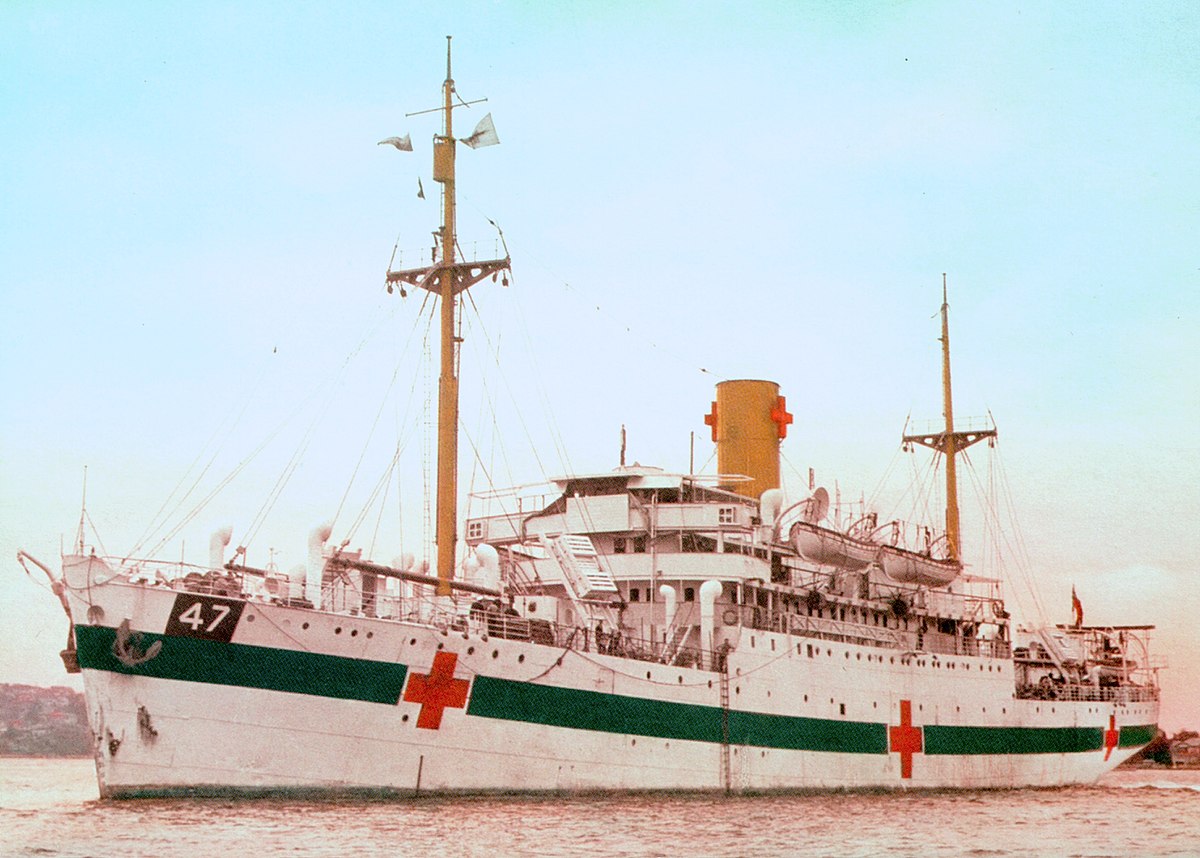
 en.wikipedia.org
en.wikipedia.org
14 May 1943 – World War II: A Japanese submarine sinks AHS Centaur off the coast of Queensland.
Australian Hospital Ship (AHS) Centaur was a hospital ship which was attacked and sunk by a Japanese submarine off the coast of Queensland, Australia, on 14 May 1943. Of the 332 medical personnel and civilian crew aboard, 268 died, including 63 of the 65 army personnel.
The Scottish-built vessel was launched in 1924 as a combination passenger liner and refrigerated cargo ship and operated a trade route between Western Australia and Singapore via the Dutch East Indies (now Indonesia), carrying passengers, cargo, and livestock. At the start of World War II, Centaur (like all British Merchant Navy vessels) was placed under British Admiralty control, but after being fitted with defensive equipment, was allowed to continue normal operations. In November 1941, the ship rescued German survivors of the engagement between Kormoran and HMAS Sydney. Centaur was relocated to Australia's east coast in October 1942, and used to transport materiel to New Guinea.
In January 1943, Centaur was handed over to the Australian military for conversion into a hospital ship, as the ship's small size made her suitable for operating in Maritime Southeast Asia. The refit (including installation of medical facilities and repainting with Red Cross markings) was completed in March, and the ship undertook a trial voyage: transporting wounded from Townsville to Brisbane, then from Port Moresby to Brisbane. After replenishing in Sydney, Centaur embarked the 2/12th Field Ambulance for transport to New Guinea, and sailed on 12 May. Before dawn on 14 May 1943, during her second voyage, Centaur was torpedoed and sunk by a Japanese submarine off North Stradbroke Island, Queensland. The majority of the 332 aboard died in the attack; the 64 survivors were discovered 36 hours later. The incident resulted in public outrage as attacking a hospital ship is considered a war crime under the 1907 Hague Convention. Protests were made by the Australian and British governments to Japan and efforts were made to discover the people responsible so they could be tried at a war crimes tribunal. In the 1970s the probable identity of the attacking submarine, I-177, became public.
The reason for the attack is unknown, with theories that Centaur was in breach of the international conventions that should have protected her, that I-177's commander was unaware that Centaur was a hospital ship, or that the submarine commander knowingly attacked a protected vessel. The wreck of Centaur was found on 20 December 2009; a claimed discovery in 1995 had been proven to be a different shipwreck.

AHS Centaur following her conversion to a hospital ship. The Red Cross designation "47" can be seen on the bow.
Sinking
At approximately 4:10 am on 14 May 1943, while on her second run from Sydney to Port Moresby, Centaur was torpedoed by an unsighted submarine. The torpedo struck the portside oil fuel tank approximately 2 metres (6 ft 7 in) below the waterline, creating a hole 8 to 10 metres (26 to 33 ft) across, igniting the fuel, and setting the ship on fire from the bridge aft. Many of those on board were immediately killed by concussion or perished in the inferno. Centaur quickly took on water through the impact site, rolled to port, then sank bow-first, submerging completely in less than three minutes. The rapid sinking prevented the deployment of lifeboats, although two broke off from Centaur as she sank, along with several damaged liferafts.
According to the position extrapolated by Second Officer Gordon Rippon from the 4:00 am dead reckoning position, Centaur was attacked approximately 24 nautical miles (44 km; 28 mi) east-northeast of Point Lookout, North Stradbroke Island, Queensland. Doubts were initially cast on the accuracy of both the calculated point of sinking and the dead reckoning position, but the 2009 discovery of the wreck found both to be correct, with Centaur located within 1 nautical mile (1.9 km; 1.2 mi) of Rippon's coordinates.

The survivors spent 36 hours in the water, using barrels, wreckage, and the two damaged lifeboats for flotation. During this time, they drifted approximately 19.6 nautical miles (36.3 km; 22.6 mi) north east of Centaur's calculated point of sinking and spread out over an area of 2 nautical miles (3.7 km; 2.3 mi). The survivors saw at least four ships and several aircraft, but could not attract their attention.
At the time of rescue, the survivors were in two large and three small groups, with several more floating alone. Amongst those rescued were Sister Ellen Savage, the only surviving nurse from 12 aboard; Leslie Outridge, the only surviving doctor from 18 aboard; Gordon Rippon, second officer and most senior surviving crew member; and Richard Salt, the Torres Strait ship pilot. In 1944, Ellen Savage was presented with the George Medal for providing medical care, boosting morale, and displaying courage during the wait for rescue.
Rescue

Sister Ellen Savage was the sole survivor of the 12 female nurses on board Centaur.
On the morning of 15 May 1943, the American destroyer USS Mugford departed Brisbane to escort the 11,063 ton New Zealand freighter Sussex on the first stage of the latter's trans-Tasman voyage. At 2:00 pm, a lookout aboard Mugford reported an object on the horizon. Around the same time, a Royal Australian Air Force Avro Ansonof No. 71 Squadron, flying ahead on anti-submarine watch, dived towards the object. The aircraft returned to the two ships and signalled that there were shipwreck survivors in the water requiring rescue. Mugford's commanding officer ordered Sussex to continue alone as Mugford collected the survivors. Marksmen were positioned around the ship to shoot sharks, and sailors stood ready to dive in and assist the wounded. Mugford's medics inspected each person as they came aboard and provided necessary medical care. The American crew learned from the first group of survivors that they were from the hospital ship Centaur.
At 2:14 pm, Mugford made contact with the Naval Officer-in-Charge in Brisbane, and announced that the ship was recovering survivors from Centaur at 27°03′S 154°12′E, the first that anyone in Australia had knowledge of the attack on the hospital ship. The rescue of the 64 survivors took an hour and twenty minutes, although Mugford remained in the area until dark, searching an area of approximately 7 by 14 nautical miles (13 by 26 km; 8 by 16 mi) for more survivors. After darkness fell, Mugford returned to Brisbane, arriving shortly before midnight. Further searches of the waters off North Stradbroke Island were made by USS Helm during the night of 15 May until 6:00 pm on 16 May, and by HMAS Lithgow and four motor torpedo boats from 16 to 21 May, with neither search finding more survivors.

AHS Centaur - Wikipedia
Today in Naval History - Naval / Maritime Events in History
Other Events on 14 May
1695 - Launch of french Fougueux 50 guns (designed and built by Blaise Pangalo, launched 14 May 1695 at Brest) – captured by the English in 1696, sank 1696
1717 - May 14 or 15 - Danish attack on Göteborg is defeated
1757 HMS Antelope (54), Cptn. Alexander Arthur Hood, drove ashore and wrecked Aquilon (50) in Audierne Bay.
HMS Antelope was a 50-gun fourth rate ship of the line of the Royal Navy, launched at Rotherhithe on 13 March 1703. She was rebuilt once during her career, and served in the Seven Years' War and the American Revolutionary War.
Orders were issued on 9 January 1738 for Antelope to be taken to pieces and rebuilt according to the 1733 proposals of the 1719 Establishment at Woolwich, from where she was relaunched on 27 January 1741.
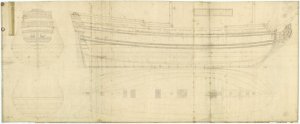
Scale: 1:48. Plan showing the body plan from midships to bow, body plan from midships to stern with stern board decoration, sheer lines with some inboard detail and figurehead, and longitudinal half-breadth with some lower deck detail for Antelope (1703), a 50-gun Fourth Rate two-decker. This may be the ship as she was when in Plymouth Dockyard in 1713. An attached letter (not scanned) lays out the dimensions of the ship, as taken at Plymouth on 7 March 1713
 en.wikipedia.org
en.wikipedia.org
1757 - Aquilon 42, later 48 guns (launched 16 March 1741 at Toulon, designed and built by Jean-Armand Levasseur) – wrecked 14 May 1757.
1776 – Launch of HMS Romulus, a Roebuck-class ship was a class of twenty 44-gun sailing two-decker warships of the Royal Navy.

 en.wikipedia.org
en.wikipedia.org
1778 – Launch of HMS Janus was a 44-gun Roebuck-class fifth rate of the Royal Navy.
HMS Janus was a 44-gun Roebuck-class fifth rate of the Royal Navy.
From May 1780 she was under the command of Captain Horatio Nelson, though he was superseded by September that year.
In 1793 she was under the command of Captain Sandford Tatham
Loss
HMS Dromedary was wrecked on the Parasol Rocks, Trinidad on 10 August 1800. Her entire complement survived.
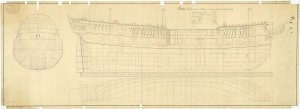
Scale: 1:48. Plan showing the body plan with stern board outline, sheer lines with inboard detail, and longitudinal half-breadth for Janus (1778), a 44-gun Fifth Rate, two-decker, as built at Limehouse by Mr Batson. The plan was possibly draughted at Deptford Dockyard as Janus was completed there between May and August 1778
https://en.wikipedia.org/wiki/HMS_Janus_(1778)
1781 HMS Nonsuch (64), Cptn. Sir James Wallace, engaged Actif (74).
On 14 May 1781, on the homeward voyage, while scouting ahead, Nonsuch chased and brought to action the French 74-gun Actif, hoping to detain her until some others of the fleet came up. However, Actif was able to repulse Nonsuch, causing her to suffer 26 men killed and 64 wounded, and continued on to Brest.

Scale: 1:48. Plan showing the body plan, sheer lines, and longitudinal half-breadth for Ruby (1776) and Nonsuch (1774), and later for Vigilant (1774), Eagle (1774), and America (1777), all 64-gun Third Rate, two-deckers. Signed by John Williams [Surveyor of the Navy, 1765-1784]
 en.wikipedia.org
en.wikipedia.org
1801 - Tripoli declares war on the United States for not increasing the annual tribute paid as protection money to prevent raids on its ships. Within a week, a squadron with USS President, USS Philadelphia and USS Essex sets sail to protect American interests.
In May, Commodore Richard Dale selected President as his flagship for the assignment in the Mediterranean. Dale's orders were to present a show of force off Algiers, Tripoli, and Tunis and maintain peace with promises of tribute. Dale was authorized to commence hostilities at his discretion if any Barbary State had declared war by the time of his arrival. Dale's squadron consisted of President, Philadelphia, Essex, and Enterprise. The squadron arrived at Gibraltar on 1 July; President and Enterprise quickly continued to Algiers, where their presence convinced the regent to withdraw threats he had made against American merchant ships. President and Enterprise subsequently made appearances at Tunis and Tripoli before President arrived at Malta on 16 August to replenish drinking water supplies.
Blockading the harbor of Tripoli on 24 August, President captured a Greek vessel with Tripolitan soldiers aboard. Dale negotiated an exchange of prisoners that resulted in the release of several Americans held captive in Tripoli.[27][28] President arrived at Gibraltar on 3 September. Near Mahón in early December, President struck a large rock while traveling at 6 knots (11 km/h; 6.9 mph). The impact brought Dale on deck and he successfully navigated President out of danger. An inspection revealed that the impact had twisted off a short section of her keel. President remained in the Mediterranean until March 1802; she departed for the United States and arrived on 14 April.

 en.wikipedia.org
en.wikipedia.org

 en.wikipedia.org
en.wikipedia.org
1807 Boats of HMS Spartan (38), Cptn. Jahleel Brenton, repulsed by a polacca off Nice.
HMS Spartan was a Royal Navy 38-gun fifth-rate frigate, launched at Rochester in 1806. During the Napoleonic Wars she was active in the Adriatic and in the Ionian Islands. She then moved to the American coast during the War of 1812, where she captured a number of small vessels, including a US Revenue Cutter and a privateer, the Dart. She then returned to the Mediterranean, where she remained for a few years. She went on to serve off the American coast again, and in the Caribbean, before being broken up in 1822.
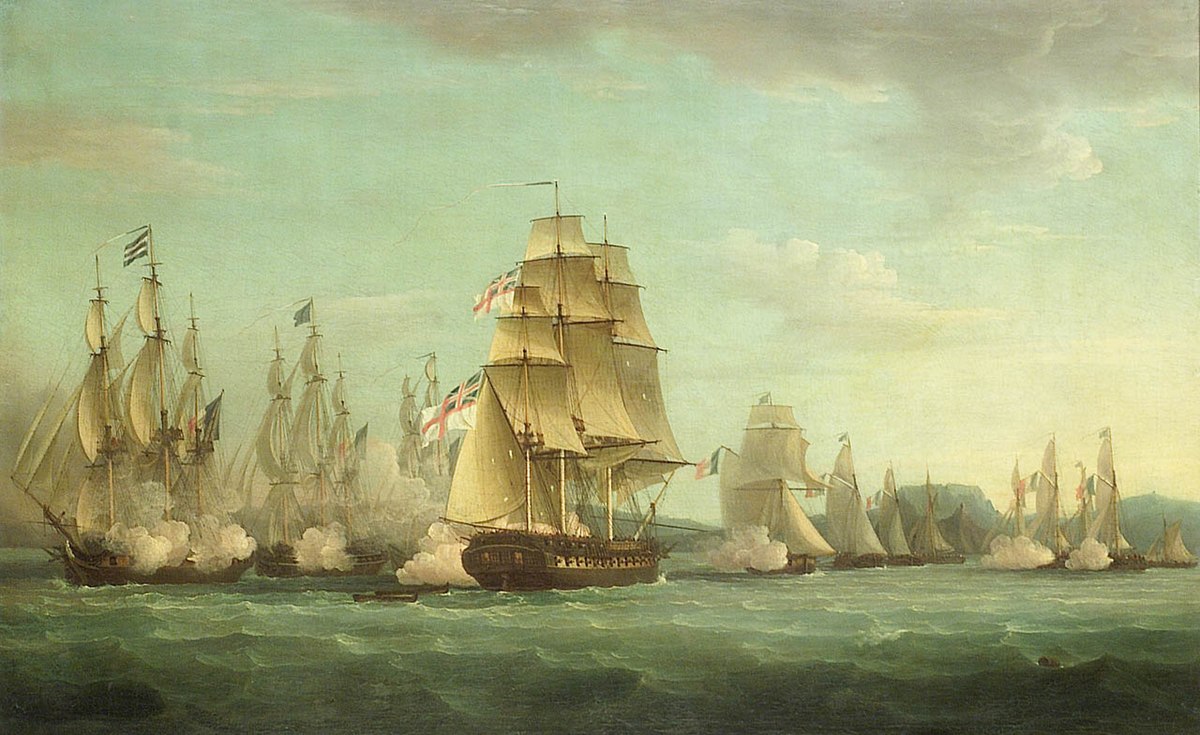
 en.wikipedia.org
en.wikipedia.org
1812 HMS Thames (32), Cptn. Charles Napier, and HMS Pilot (18), Cptn. John Toup Nicholas took 29 vessels at Port Sapri, Calabria. Most were destroyed by a gale during the night.
HMS Thames (1805) was another 32-gun fifth rate, launched in 1805 and broken up in 1816.
HMS Pilot (1807) was an 18-gun Cruizer-class brig-sloop launched in 1807 and sold in 1828. She became a whaler, making five whale fishing voyages between 1830 and 1842; she was last listed in 1844.
1832 – Launch of HMS Cockatrice was a six-gun schooner, the name ship of her class, built for the Royal Navy during the 1830s.
HMS Cockatrice was a six-gun schooner, the name ship of her class, built for the Royal Navy during the 1830s. She was sold for scrap in 1858.
Description
Cockatrice had a length at the gundeck of 80 feet (24.4 m) and 64 feet 2 inches (19.6 m) at the keel. She had a beam of 23 feet 4 inches (7.1 m), a draught of about 9 feet 5 inches (2.9 m) and a depth of hold of 9 feet 10 inches (3.0 m). The ship's tonnage was 181 78/94 tons burthen. The Cockatrice class was armed with two 6-pounder cannon and four 12-pounder carronades. The ships had a crew of 33–42 officers and ratings.

Construction and career
Cockatrice, the second ship of her name to serve in the Royal Navy, was ordered on 11 September 1828, laid down in July 1831 at Pembroke Dockyard, Wales, and launched on 14 May 1832. She was completed on 15 September 1832 at Plymouth Dockyard.
https://en.wikipedia.org/wiki/HMS_Cockatrice_(1832)
1836 - Congress authorizes the U.S. Exploring Expedition to conduct an exploration of the Pacific Ocean and South Seas, making the first major US scientific expedition overseas. Lt. Charles Wilkes leads the expedition to survey South America, Antarctica, the Far East, and the North Pacific in his flagship USS Vincennes.
The United States Exploring Expedition of 1838–1842 was an exploring and surveying expedition of the Pacific Ocean and surrounding lands conducted by the United States. The original appointed commanding officer was Commodore Thomas ap Catesby Jones. Funding for the original expedition was requested by President John Quincy Adams in 1828, however, Congress would not implement funding until eight years later. In May 1836, the oceanic exploration voyage was finally authorized by Congress and created by President Andrew Jackson.
The expedition is sometimes called the "U.S. Ex. Ex." for short, or the "Wilkes Expedition" in honor of its next appointed commanding officer, United States Navy Lieutenant Charles Wilkes. The expedition was of major importance to the growth of science in the United States, in particular the then-young field of oceanography. During the event, armed conflict between Pacific islanders and the expedition was common and dozens of natives were killed in action, as well as a few Americans.
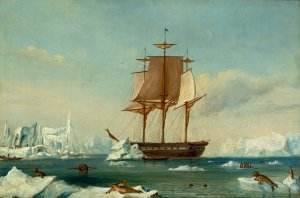
Vincennes at Disappointment Bay, Antarctica, early 1840
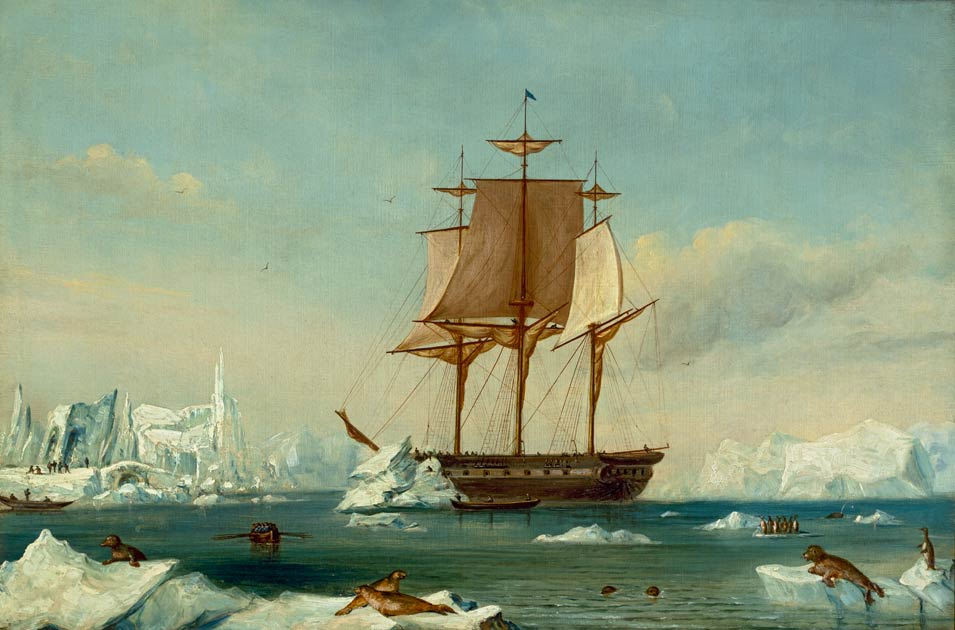
 en.wikipedia.org
en.wikipedia.org
1845 - SS Spitfire, of New Orleans, captured on the coast of Africa, under American flag and the captain indicted in Boston
1919 - The Marine detachment from USS Arizona (BB 39) guards the U.S. consulate at Constantinople, Turkey, during the Greek occupation of the city.
1927 – Launch of Cap Arcona, named after Cape Arkona on the island of Rügen, was a large German ocean liner and the flagship of the Hamburg Südamerikanische Dampfschifffahrts-Gesellschaft ("Hamburg-South America Line").
Cap Arcona, named after Cape Arkona on the island of Rügen, was a large German ocean liner and the flagship of the Hamburg Südamerikanische Dampfschifffahrts-Gesellschaft ("Hamburg-South America Line"). She took her maiden voyage on 29 October 1927, carrying passengers and cargo between Germany and the east coast of South America, and in her time was the largest and quickest ship on the route.
In 1940 the Kriegsmarine requisitioned her as an accommodation ship. In 1942 she served as the set for the German propaganda feature film Titanic. In 1945 she evacuated almost 26,000 German soldiers and civilians from East Prussia before the advance of the Red Army.
Cap Arcona's final use was as a prison ship. In May 1945 she was heavily laden with prisoners from Nazi concentration camps when the Royal Air Force sank her, killing about 5,000 people; with more than 2,000 further casualties in the sinkings of the accompanying vessels of the prison fleet; Deutschland and Thielbek. This was one of the biggest single-incident maritime losses of life in the Second World War, the largest being the wartime sinking of the German evacuation liner Wilhelm Gustloff in January 1945 in World War II by a Soviet Navy submarine, with an estimated loss of about 9,400 people


 en.wikipedia.org
en.wikipedia.org
1944 - USS Bonefish (SS 223) attacks a Japanese convoy bound for Sibitu Passage, Borneo, and sinks Japanese destroyer Inazuma near TawiTawi, east of Borneo and survives counter-attacks by Japanese destroyer Hibiki. Also on this date, USS Aspro (SS 309) and USS Bowfin (SS 287) attack a Japanese convoy and sinks cargo ship BisanMaru.

 en.wikipedia.org
en.wikipedia.org
1945 - German submarine (U 858) arrives at Cape May, Del., after surrendering at sea four days earlier. USS bury (DE 133) and USS Pope (DE 134) arrive later that day, take over the boat, place U.S. Navy crew on board, and remove 1/2 of her German crew, including three of her four officers. (U 858) is later scuttled off the coast of New England during torpedo trials.
bury (DE 133) and USS Pope (DE 134) arrive later that day, take over the boat, place U.S. Navy crew on board, and remove 1/2 of her German crew, including three of her four officers. (U 858) is later scuttled off the coast of New England during torpedo trials.
German submarine U-858 was a Type IXC/40 U-boat of Nazi Germany's Kriegsmarine during World War II. She was ordered on 5 June 1941, laid downon 11 December 1942 and launched on 30 September 1943. She had one commander for her three patrols, Kapitänleutnant Thilo Bode.

U-858 after her surrender in May 1945

 en.wikipedia.org
en.wikipedia.org
Other Events on 14 May
1695 - Launch of french Fougueux 50 guns (designed and built by Blaise Pangalo, launched 14 May 1695 at Brest) – captured by the English in 1696, sank 1696
1717 - May 14 or 15 - Danish attack on Göteborg is defeated
1757 HMS Antelope (54), Cptn. Alexander Arthur Hood, drove ashore and wrecked Aquilon (50) in Audierne Bay.
HMS Antelope was a 50-gun fourth rate ship of the line of the Royal Navy, launched at Rotherhithe on 13 March 1703. She was rebuilt once during her career, and served in the Seven Years' War and the American Revolutionary War.
Orders were issued on 9 January 1738 for Antelope to be taken to pieces and rebuilt according to the 1733 proposals of the 1719 Establishment at Woolwich, from where she was relaunched on 27 January 1741.

Scale: 1:48. Plan showing the body plan from midships to bow, body plan from midships to stern with stern board decoration, sheer lines with some inboard detail and figurehead, and longitudinal half-breadth with some lower deck detail for Antelope (1703), a 50-gun Fourth Rate two-decker. This may be the ship as she was when in Plymouth Dockyard in 1713. An attached letter (not scanned) lays out the dimensions of the ship, as taken at Plymouth on 7 March 1713
HMS Antelope (1703) - Wikipedia
1757 - Aquilon 42, later 48 guns (launched 16 March 1741 at Toulon, designed and built by Jean-Armand Levasseur) – wrecked 14 May 1757.
1776 – Launch of HMS Romulus, a Roebuck-class ship was a class of twenty 44-gun sailing two-decker warships of the Royal Navy.

Roebuck-class ship - Wikipedia
1778 – Launch of HMS Janus was a 44-gun Roebuck-class fifth rate of the Royal Navy.
HMS Janus was a 44-gun Roebuck-class fifth rate of the Royal Navy.
From May 1780 she was under the command of Captain Horatio Nelson, though he was superseded by September that year.
In 1793 she was under the command of Captain Sandford Tatham
Loss
HMS Dromedary was wrecked on the Parasol Rocks, Trinidad on 10 August 1800. Her entire complement survived.

Scale: 1:48. Plan showing the body plan with stern board outline, sheer lines with inboard detail, and longitudinal half-breadth for Janus (1778), a 44-gun Fifth Rate, two-decker, as built at Limehouse by Mr Batson. The plan was possibly draughted at Deptford Dockyard as Janus was completed there between May and August 1778
https://en.wikipedia.org/wiki/HMS_Janus_(1778)
1781 HMS Nonsuch (64), Cptn. Sir James Wallace, engaged Actif (74).
On 14 May 1781, on the homeward voyage, while scouting ahead, Nonsuch chased and brought to action the French 74-gun Actif, hoping to detain her until some others of the fleet came up. However, Actif was able to repulse Nonsuch, causing her to suffer 26 men killed and 64 wounded, and continued on to Brest.

Scale: 1:48. Plan showing the body plan, sheer lines, and longitudinal half-breadth for Ruby (1776) and Nonsuch (1774), and later for Vigilant (1774), Eagle (1774), and America (1777), all 64-gun Third Rate, two-deckers. Signed by John Williams [Surveyor of the Navy, 1765-1784]
HMS Nonsuch (1774) - Wikipedia
1801 - Tripoli declares war on the United States for not increasing the annual tribute paid as protection money to prevent raids on its ships. Within a week, a squadron with USS President, USS Philadelphia and USS Essex sets sail to protect American interests.
In May, Commodore Richard Dale selected President as his flagship for the assignment in the Mediterranean. Dale's orders were to present a show of force off Algiers, Tripoli, and Tunis and maintain peace with promises of tribute. Dale was authorized to commence hostilities at his discretion if any Barbary State had declared war by the time of his arrival. Dale's squadron consisted of President, Philadelphia, Essex, and Enterprise. The squadron arrived at Gibraltar on 1 July; President and Enterprise quickly continued to Algiers, where their presence convinced the regent to withdraw threats he had made against American merchant ships. President and Enterprise subsequently made appearances at Tunis and Tripoli before President arrived at Malta on 16 August to replenish drinking water supplies.
Blockading the harbor of Tripoli on 24 August, President captured a Greek vessel with Tripolitan soldiers aboard. Dale negotiated an exchange of prisoners that resulted in the release of several Americans held captive in Tripoli.[27][28] President arrived at Gibraltar on 3 September. Near Mahón in early December, President struck a large rock while traveling at 6 knots (11 km/h; 6.9 mph). The impact brought Dale on deck and he successfully navigated President out of danger. An inspection revealed that the impact had twisted off a short section of her keel. President remained in the Mediterranean until March 1802; she departed for the United States and arrived on 14 April.

USS President (1800) - Wikipedia

First Barbary War - Wikipedia
1807 Boats of HMS Spartan (38), Cptn. Jahleel Brenton, repulsed by a polacca off Nice.
HMS Spartan was a Royal Navy 38-gun fifth-rate frigate, launched at Rochester in 1806. During the Napoleonic Wars she was active in the Adriatic and in the Ionian Islands. She then moved to the American coast during the War of 1812, where she captured a number of small vessels, including a US Revenue Cutter and a privateer, the Dart. She then returned to the Mediterranean, where she remained for a few years. She went on to serve off the American coast again, and in the Caribbean, before being broken up in 1822.

HMS Spartan (1806) - Wikipedia
1812 HMS Thames (32), Cptn. Charles Napier, and HMS Pilot (18), Cptn. John Toup Nicholas took 29 vessels at Port Sapri, Calabria. Most were destroyed by a gale during the night.
HMS Thames (1805) was another 32-gun fifth rate, launched in 1805 and broken up in 1816.
HMS Pilot (1807) was an 18-gun Cruizer-class brig-sloop launched in 1807 and sold in 1828. She became a whaler, making five whale fishing voyages between 1830 and 1842; she was last listed in 1844.
1832 – Launch of HMS Cockatrice was a six-gun schooner, the name ship of her class, built for the Royal Navy during the 1830s.
HMS Cockatrice was a six-gun schooner, the name ship of her class, built for the Royal Navy during the 1830s. She was sold for scrap in 1858.
Description
Cockatrice had a length at the gundeck of 80 feet (24.4 m) and 64 feet 2 inches (19.6 m) at the keel. She had a beam of 23 feet 4 inches (7.1 m), a draught of about 9 feet 5 inches (2.9 m) and a depth of hold of 9 feet 10 inches (3.0 m). The ship's tonnage was 181 78/94 tons burthen. The Cockatrice class was armed with two 6-pounder cannon and four 12-pounder carronades. The ships had a crew of 33–42 officers and ratings.

Construction and career
Cockatrice, the second ship of her name to serve in the Royal Navy, was ordered on 11 September 1828, laid down in July 1831 at Pembroke Dockyard, Wales, and launched on 14 May 1832. She was completed on 15 September 1832 at Plymouth Dockyard.
https://en.wikipedia.org/wiki/HMS_Cockatrice_(1832)
Naval/Maritime History - 27th of August - Today in Naval History - Naval / Maritime Events in History
Today in Naval History - Naval / Maritime Events in History 12 May 1808 - HMS Tartar (32), Cptn. G. E. B. Bettesworth (Killed in Action), and boats engaged at Bergen. HMS Tartar left Leith roads on 10 May 1807 and arrived off Bergen on the 12th, but heavy fog prevented her from getting closer...
shipsofscale.com
1836 - Congress authorizes the U.S. Exploring Expedition to conduct an exploration of the Pacific Ocean and South Seas, making the first major US scientific expedition overseas. Lt. Charles Wilkes leads the expedition to survey South America, Antarctica, the Far East, and the North Pacific in his flagship USS Vincennes.
The United States Exploring Expedition of 1838–1842 was an exploring and surveying expedition of the Pacific Ocean and surrounding lands conducted by the United States. The original appointed commanding officer was Commodore Thomas ap Catesby Jones. Funding for the original expedition was requested by President John Quincy Adams in 1828, however, Congress would not implement funding until eight years later. In May 1836, the oceanic exploration voyage was finally authorized by Congress and created by President Andrew Jackson.
The expedition is sometimes called the "U.S. Ex. Ex." for short, or the "Wilkes Expedition" in honor of its next appointed commanding officer, United States Navy Lieutenant Charles Wilkes. The expedition was of major importance to the growth of science in the United States, in particular the then-young field of oceanography. During the event, armed conflict between Pacific islanders and the expedition was common and dozens of natives were killed in action, as well as a few Americans.

Vincennes at Disappointment Bay, Antarctica, early 1840

United States Exploring Expedition - Wikipedia
1845 - SS Spitfire, of New Orleans, captured on the coast of Africa, under American flag and the captain indicted in Boston
1919 - The Marine detachment from USS Arizona (BB 39) guards the U.S. consulate at Constantinople, Turkey, during the Greek occupation of the city.
1927 – Launch of Cap Arcona, named after Cape Arkona on the island of Rügen, was a large German ocean liner and the flagship of the Hamburg Südamerikanische Dampfschifffahrts-Gesellschaft ("Hamburg-South America Line").
Cap Arcona, named after Cape Arkona on the island of Rügen, was a large German ocean liner and the flagship of the Hamburg Südamerikanische Dampfschifffahrts-Gesellschaft ("Hamburg-South America Line"). She took her maiden voyage on 29 October 1927, carrying passengers and cargo between Germany and the east coast of South America, and in her time was the largest and quickest ship on the route.
In 1940 the Kriegsmarine requisitioned her as an accommodation ship. In 1942 she served as the set for the German propaganda feature film Titanic. In 1945 she evacuated almost 26,000 German soldiers and civilians from East Prussia before the advance of the Red Army.
Cap Arcona's final use was as a prison ship. In May 1945 she was heavily laden with prisoners from Nazi concentration camps when the Royal Air Force sank her, killing about 5,000 people; with more than 2,000 further casualties in the sinkings of the accompanying vessels of the prison fleet; Deutschland and Thielbek. This was one of the biggest single-incident maritime losses of life in the Second World War, the largest being the wartime sinking of the German evacuation liner Wilhelm Gustloff in January 1945 in World War II by a Soviet Navy submarine, with an estimated loss of about 9,400 people


SS Cap Arcona - Wikipedia
1944 - USS Bonefish (SS 223) attacks a Japanese convoy bound for Sibitu Passage, Borneo, and sinks Japanese destroyer Inazuma near TawiTawi, east of Borneo and survives counter-attacks by Japanese destroyer Hibiki. Also on this date, USS Aspro (SS 309) and USS Bowfin (SS 287) attack a Japanese convoy and sinks cargo ship BisanMaru.

USS Bonefish (SS-223) - Wikipedia
1945 - German submarine (U 858) arrives at Cape May, Del., after surrendering at sea four days earlier. USS
 bury (DE 133) and USS Pope (DE 134) arrive later that day, take over the boat, place U.S. Navy crew on board, and remove 1/2 of her German crew, including three of her four officers. (U 858) is later scuttled off the coast of New England during torpedo trials.
bury (DE 133) and USS Pope (DE 134) arrive later that day, take over the boat, place U.S. Navy crew on board, and remove 1/2 of her German crew, including three of her four officers. (U 858) is later scuttled off the coast of New England during torpedo trials.German submarine U-858 was a Type IXC/40 U-boat of Nazi Germany's Kriegsmarine during World War II. She was ordered on 5 June 1941, laid downon 11 December 1942 and launched on 30 September 1943. She had one commander for her three patrols, Kapitänleutnant Thilo Bode.

U-858 after her surrender in May 1945

German submarine U-858 - Wikipedia
Today in Naval History - Naval / Maritime Events in History
15 May 1812 – Launch of French Aréthuse, a 46-gun 18-pounder frigate of the French Navy.
The Aréthuse was a 46-gun 18-pounder frigate of the French Navy. She served during the Napoleonic Wars, taking part in a major single-ship action. Much later she took part in the conquest of Algeria, and ended her days as a coal depot in Brest.



A depiction of the battle between the French frigate Aréthuse and the H.M.S. Amelia off the shores of Guinea, 7 February 1813.
Construction
Aréthuse was laid down at Nantes in 1807 and launched on 15 May 1812.
Career
Cruise off West Africa, 1812-1813
Main article: Action of 7 February 1813
On 25 November 1812 the frigates Aréthuse (Captain Pierre Bouvet) and Rubis sailed from Nantes to intercept British trade off West Africa. In January, having captured a Portuguese ship, La Serra, they reached Cap-Vert. They also captured Little Belt, J. Wilson, master, sailing from Altea to London, Friends, Houston, master, sailing from Teneriffe to Belfast, and a Spanish brig sailing from Majorca to Puerto Rico. The French put the masters and crews on Delphina, a Portuguese they had captured and plundered. Delphina arrived at Pernambuco on 31 January.
On 27 January 1813, Aréthuse intercepted the brig HMS Daring (Lieutenant Pascoe) off Tamara (one of the Iles de Los off Guinea). Pascoe ran Daring aground and set fire to her to avoid her capture. The French managed to take part of her crew prisoner but released them against their parole and put them in a boat. Pascoe and those of his men who had escaped capture sailed to the Sierra Leone River, where they arrived the next day. There they reported the presence of the French frigates to HMS Amelia (Captain Frederick Paul Irby).
In the night of 5 February, a storm threw Rubis ashore, wrecking her. The same storm damaged Aréthuse' rudder. Rubis was abandoned and set afire, while Aréthuse effect her repairs.

HMS Amelia in action with the French Frigate Aréthuse, 1813, by John Christian Schetky, 1852
On 6 February, HMS Amelia, guided and reinforced by sailors from Daring, attacked Aréthuse. A furious, 4-hour night battle followed. Aréthuse and Amelia disabled each other by shooting at their sails and rigging. Eventually the ships parted, neither able to gain the upper hand, and both with heavy casualties: Amelia had 46 killed and 51 wounded; Aréthuse suffered over 20 killed and 88 wounded, and 30 round shot had struck her hull on the starboard side below the quarter deck.
Aréthuse returned to the wreck of Rubis to gather her crew, and returned to France. Soon afterwards Aréthuse captured the British privateer Cerberus, and arrived back in St Malo on 19 April having taken 15 prizes.
Later life and disposal
She took part in the Invasion of Algiers in 1830 as a transport. In 1833, she was razeed into a corvette. She was decommissioned in 1861 and used as a coal depot in Brest.

A dramatic night scene depiciting the battle between the French 'Arethuse', in the left foreground, and the British 'Amelia' near Guinea. The battle resulted in a stalemate, but both ships returned to port claiming victory. Inscription reads: 'Engagement between His Majesty's Ship Amelia carrying 48 Guns and 300 Men - and L'Arethuse, (French Frigate) carrying 48 Guns, and 380 Men, Off the Isle de Loss, on the Coast of Africa, On the Night of The 7th of February 1813 - The Rubus (Arethuse's Consort) carrying 48 Guns & 375 Men, having been in sight previous to the Action.' In 'The Royal Navy - a history' (Vol. 5, p521), William Laird Clowes lists 'Amelia's' guns as 24 and crew as 319 "men and boys" and 'Arethuse's' guns as 22 and crew as "about 340 men"
Model of a Pallas-class frigate

The Pallas class constituted the standard design of 40-gun frigates of the French Navy during the Napoleonic Empire period. Jacques-Noël Sanédesigned them in 1805, as a development of his seven-ship Hortense class of 1802, and over the next eight years the Napoléonic government ordered in total 62 frigates to be built to this new design. Of these some 54 were completed, although ten of them were begun for the French Navy in shipyards within the French-occupied Netherlands or Italy, which were then under French occupation; these latter ships were completed for the Netherlands or Austrian navies after 1813.


 en.wikipedia.org
en.wikipedia.org

 en.wikipedia.org
en.wikipedia.org
15 May 1812 – Launch of French Aréthuse, a 46-gun 18-pounder frigate of the French Navy.
The Aréthuse was a 46-gun 18-pounder frigate of the French Navy. She served during the Napoleonic Wars, taking part in a major single-ship action. Much later she took part in the conquest of Algeria, and ended her days as a coal depot in Brest.



A depiction of the battle between the French frigate Aréthuse and the H.M.S. Amelia off the shores of Guinea, 7 February 1813.
Construction
Aréthuse was laid down at Nantes in 1807 and launched on 15 May 1812.
Career
Cruise off West Africa, 1812-1813
Main article: Action of 7 February 1813
On 25 November 1812 the frigates Aréthuse (Captain Pierre Bouvet) and Rubis sailed from Nantes to intercept British trade off West Africa. In January, having captured a Portuguese ship, La Serra, they reached Cap-Vert. They also captured Little Belt, J. Wilson, master, sailing from Altea to London, Friends, Houston, master, sailing from Teneriffe to Belfast, and a Spanish brig sailing from Majorca to Puerto Rico. The French put the masters and crews on Delphina, a Portuguese they had captured and plundered. Delphina arrived at Pernambuco on 31 January.
On 27 January 1813, Aréthuse intercepted the brig HMS Daring (Lieutenant Pascoe) off Tamara (one of the Iles de Los off Guinea). Pascoe ran Daring aground and set fire to her to avoid her capture. The French managed to take part of her crew prisoner but released them against their parole and put them in a boat. Pascoe and those of his men who had escaped capture sailed to the Sierra Leone River, where they arrived the next day. There they reported the presence of the French frigates to HMS Amelia (Captain Frederick Paul Irby).
In the night of 5 February, a storm threw Rubis ashore, wrecking her. The same storm damaged Aréthuse' rudder. Rubis was abandoned and set afire, while Aréthuse effect her repairs.

HMS Amelia in action with the French Frigate Aréthuse, 1813, by John Christian Schetky, 1852
On 6 February, HMS Amelia, guided and reinforced by sailors from Daring, attacked Aréthuse. A furious, 4-hour night battle followed. Aréthuse and Amelia disabled each other by shooting at their sails and rigging. Eventually the ships parted, neither able to gain the upper hand, and both with heavy casualties: Amelia had 46 killed and 51 wounded; Aréthuse suffered over 20 killed and 88 wounded, and 30 round shot had struck her hull on the starboard side below the quarter deck.
Aréthuse returned to the wreck of Rubis to gather her crew, and returned to France. Soon afterwards Aréthuse captured the British privateer Cerberus, and arrived back in St Malo on 19 April having taken 15 prizes.
Later life and disposal
She took part in the Invasion of Algiers in 1830 as a transport. In 1833, she was razeed into a corvette. She was decommissioned in 1861 and used as a coal depot in Brest.

A dramatic night scene depiciting the battle between the French 'Arethuse', in the left foreground, and the British 'Amelia' near Guinea. The battle resulted in a stalemate, but both ships returned to port claiming victory. Inscription reads: 'Engagement between His Majesty's Ship Amelia carrying 48 Guns and 300 Men - and L'Arethuse, (French Frigate) carrying 48 Guns, and 380 Men, Off the Isle de Loss, on the Coast of Africa, On the Night of The 7th of February 1813 - The Rubus (Arethuse's Consort) carrying 48 Guns & 375 Men, having been in sight previous to the Action.' In 'The Royal Navy - a history' (Vol. 5, p521), William Laird Clowes lists 'Amelia's' guns as 24 and crew as 319 "men and boys" and 'Arethuse's' guns as 22 and crew as "about 340 men"
Model of a Pallas-class frigate

The Pallas class constituted the standard design of 40-gun frigates of the French Navy during the Napoleonic Empire period. Jacques-Noël Sanédesigned them in 1805, as a development of his seven-ship Hortense class of 1802, and over the next eight years the Napoléonic government ordered in total 62 frigates to be built to this new design. Of these some 54 were completed, although ten of them were begun for the French Navy in shipyards within the French-occupied Netherlands or Italy, which were then under French occupation; these latter ships were completed for the Netherlands or Austrian navies after 1813.


French frigate Aréthuse (1812) - Wikipedia

Pallas-class frigate (1808) - Wikipedia
Today in Naval History - Naval / Maritime Events in History
15 May 1839 – Launch of HMS Queen, a 110-gun first-rate ship of the line of the Royal Navy, at Portsmouth.
HMS Queen was a 110-gun first-rate ship of the line of the Royal Navy, launched on 15 May 1839 at Portsmouth. She was the last purely sailing battleship to be completed - subsequent ones had steam engines as well although all British battleships were constructed with sailing rig until the 1870s.



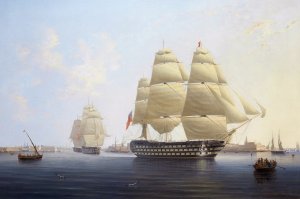
HMS Queen, Flagship of Vice Admiral Sir Edward Rich Owen, Commander-in-Chief of the Mediterranean fleet, leaving Malta (Robert Strickland Thomas, 1842)

Ordered
She was ordered in 1827 under the name Royal Frederick, but renamed on 12 April 1839 while still on the stocks in honour of the recently enthroned Queen Victoria. She was originally ordered as the final ship of the broadened Caledonia class, but on 3 September 1833 she was re-ordered to a new design by Sir William Symonds.
This was the only ship completed to this Symonds draught, although three other sister ships were originally ordered to the same design; of these a ship originally ordered at Portsmouth Dockyard on 12 September 1833 as Royal Sovereign took over the name Royal Frederick on 12 April 1839, and was eventually completed as a screw battleship under the name of Frederick William. Of the remaining two intended sister ships, both ordered from Pembroke Dockyard on 3 October 1833, Algiers was eventually completed as a 90-gun screw battleship, while Victoria was eventually completed as a 90-gun screw battleship under the name Windsor Castle.
In 1842 she was visited by Queen Victoria.
Crimean War
In 1854, she participated in the bombardment of Sevastopol during the Crimean War. She was set on fire three times and eventually forced to withdraw from the action. The famous Timothy the tortoise, who was about 160 years old when she died in 2004, was the ship's mascot during this time.
Refitted
Between August 1858 and April 1859 Queen had an auxiliary steam engine fitted, and at the same time was cut down from three decks to two gundecks, and re-armed as an 86-gun ship. She was fitted with a Maudslay, Sons and Field 500 nhp engine and single screw propulsion. Now, being able to cruise at 10.5 knots (12.1 mph; 19.4 km/h), she was commissioned into the Mediterranean Fleet until 1864.
Broken up
The ship was broken up in 1871 at Surrey Canal Wharf in Rotherhithe, on the River Thames.

Breaking up of the ship
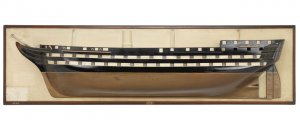
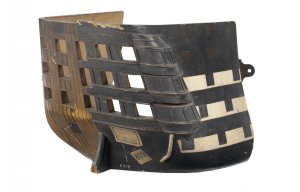

Scale: Unknown. A sectional model depicting the stern of HMS 'Queen' (1839), a first rate 110-gun warship. The port stern quarter has been depicted in frame and the starboard stern quarter has been depicted fully planked and painted in realistic colours and with its gallery. The model has been carved in wood and painted in realistic colours. The inside of the model has been painted in yellow ochre throughout. The port quarter frames have been painted in two shades of brown and detailed to resemble wood, and the spaces between the frames, together with the gun port apertures and doorways, have been painted black. The starboard quarter has been painted black with three white bands along the gun decks. There two brackets fixed to the model for wall-mounting. There are two paper labels applied to the starboard quarter, one of which reads "879"
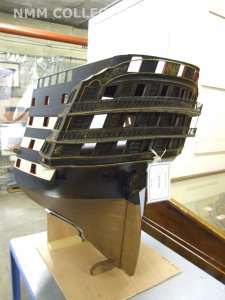

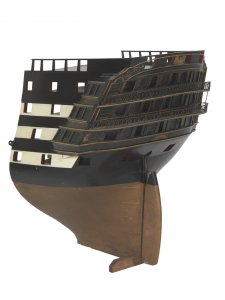
Scale: 1:24. A model of the stern of HMS Queen (1839) made almost entirely in wood with some metal fittings. The hull is painted copper below the waterline to indicate sheathing whilst above the bulwarks are black with the three main gun decks highlighted with a horizontal white stripe. The inside face of the gun ports have been painted bright red with the interior of the hull between decks painted a creamy brown and a dark bottle green on the poop deck. The quarter galleries include a number of glazed windows as well as false windows, some of which have omitted or are missing together with two layers of stern galleries complete with metal balustrades. There is carved decoration above the taffrail on the stern consisting of the Royal coat of arms, a pair of garter stars on the lower portion of the quarter galleries together with the name 'Queen' painted on a cartouche on the lower transom. The rudder is complete with its metal fittings such as gudgeons and pintles, with the upper portion of the rudder stock missing


Scale: 1:24. A midship sectional model of the 110-gun first rate ship HMS Queen (1839) made entirely in wood with metal fittings and painted in realistic colours. The model is made to show the four gundecks, their layout amidships, type of guns used and various items of equipment. The orlop is also shown with a large area walled-off in the centre of the deck, possibly a magazine. The deck above the orlop has two walled-off areas on the port and starboard sides. The external hull is painted a copper effect below the waterline, black above, with broad white stripes along the three lower gundecks. The gunport lids are painted black externally and the inner faces of the lids and gunports themselves are painted red. The inner hull is planked and the fore and aft faces of the section show the framing, keel, keelson, hammock stowage, gunwales and other structural details. Fittings and equipment includes a stump mast painted white, guns on sea service carriages, reamers and other gun equipment, mess tables suspended from the deck ceilings, racks with white plates stowed in rows, turned pillar supports for the decks and at least one anchor. The model is displayed on a pair of wooden chock supports




Scale: 1:48. A contemporary full hull model of 'Queen' (1839), a 110-gun, three-decker ship of the line. It is complete with stump masts and bowsprit, channels together with deadeyes, and the whole model mounted on its original turned wooden pillars fixed to the baseboard. The hull and rudder have been painted copper below the waterline to illustrate sheathing. The upper works are finished in the standard black and white format, interspersed with hinged gunport lids, covering blank solid gunports. The closed stern includes two tiers of pierced gallery rails as well as decorated quarter galleries either side. On deck, there are a number of fittings including a double wheel, skylights, gratings, whilst the hammock nettings on the bulwarks are left empty. The `Queen’ was the first of the large sailing warships designed by Sir William Symonds. It was laid down in Portsmouth in 1833 under the name `Royal Frederick’, and originally rated as a 120-gun ship. Measuring 204 feet along the gundeck by 60 feet in the beam, it had a tonnage of 3104 burden. Symonds introduced iron riders (diagonal bracing of the hold) instead of the heavy and bulky wooden riders used in the earlier vessels, which allowed larger and stronger ships to be built increasing the space internally. The `Queen’ was said to have been a very sea-worthy ship with many of the senior officers writing to Symonds praising it very highly in all weathers. When all the principal sails were set, it gave a coverage of 30,000 square feet, equivalent to two thirds of an acre. Serving as the flagship in the Mediterranean and the Black Sea, the `Queen’ took part in the Crimean War and was set on fire by a shell during the bombardment of Sebastopol on 11 October 1854. Cut down to two decks, it was converted to a screw battleship of 86 guns in 1859 and eventually in 1871, withdrawn from service and sold for breaking at Castles Yard, Charlton

 en.wikipedia.org
en.wikipedia.org
15 May 1839 – Launch of HMS Queen, a 110-gun first-rate ship of the line of the Royal Navy, at Portsmouth.
HMS Queen was a 110-gun first-rate ship of the line of the Royal Navy, launched on 15 May 1839 at Portsmouth. She was the last purely sailing battleship to be completed - subsequent ones had steam engines as well although all British battleships were constructed with sailing rig until the 1870s.




HMS Queen, Flagship of Vice Admiral Sir Edward Rich Owen, Commander-in-Chief of the Mediterranean fleet, leaving Malta (Robert Strickland Thomas, 1842)

Ordered
She was ordered in 1827 under the name Royal Frederick, but renamed on 12 April 1839 while still on the stocks in honour of the recently enthroned Queen Victoria. She was originally ordered as the final ship of the broadened Caledonia class, but on 3 September 1833 she was re-ordered to a new design by Sir William Symonds.
This was the only ship completed to this Symonds draught, although three other sister ships were originally ordered to the same design; of these a ship originally ordered at Portsmouth Dockyard on 12 September 1833 as Royal Sovereign took over the name Royal Frederick on 12 April 1839, and was eventually completed as a screw battleship under the name of Frederick William. Of the remaining two intended sister ships, both ordered from Pembroke Dockyard on 3 October 1833, Algiers was eventually completed as a 90-gun screw battleship, while Victoria was eventually completed as a 90-gun screw battleship under the name Windsor Castle.
In 1842 she was visited by Queen Victoria.
Crimean War
In 1854, she participated in the bombardment of Sevastopol during the Crimean War. She was set on fire three times and eventually forced to withdraw from the action. The famous Timothy the tortoise, who was about 160 years old when she died in 2004, was the ship's mascot during this time.
Refitted
Between August 1858 and April 1859 Queen had an auxiliary steam engine fitted, and at the same time was cut down from three decks to two gundecks, and re-armed as an 86-gun ship. She was fitted with a Maudslay, Sons and Field 500 nhp engine and single screw propulsion. Now, being able to cruise at 10.5 knots (12.1 mph; 19.4 km/h), she was commissioned into the Mediterranean Fleet until 1864.
Broken up
The ship was broken up in 1871 at Surrey Canal Wharf in Rotherhithe, on the River Thames.

Breaking up of the ship



Scale: Unknown. A sectional model depicting the stern of HMS 'Queen' (1839), a first rate 110-gun warship. The port stern quarter has been depicted in frame and the starboard stern quarter has been depicted fully planked and painted in realistic colours and with its gallery. The model has been carved in wood and painted in realistic colours. The inside of the model has been painted in yellow ochre throughout. The port quarter frames have been painted in two shades of brown and detailed to resemble wood, and the spaces between the frames, together with the gun port apertures and doorways, have been painted black. The starboard quarter has been painted black with three white bands along the gun decks. There two brackets fixed to the model for wall-mounting. There are two paper labels applied to the starboard quarter, one of which reads "879"



Scale: 1:24. A model of the stern of HMS Queen (1839) made almost entirely in wood with some metal fittings. The hull is painted copper below the waterline to indicate sheathing whilst above the bulwarks are black with the three main gun decks highlighted with a horizontal white stripe. The inside face of the gun ports have been painted bright red with the interior of the hull between decks painted a creamy brown and a dark bottle green on the poop deck. The quarter galleries include a number of glazed windows as well as false windows, some of which have omitted or are missing together with two layers of stern galleries complete with metal balustrades. There is carved decoration above the taffrail on the stern consisting of the Royal coat of arms, a pair of garter stars on the lower portion of the quarter galleries together with the name 'Queen' painted on a cartouche on the lower transom. The rudder is complete with its metal fittings such as gudgeons and pintles, with the upper portion of the rudder stock missing


Scale: 1:24. A midship sectional model of the 110-gun first rate ship HMS Queen (1839) made entirely in wood with metal fittings and painted in realistic colours. The model is made to show the four gundecks, their layout amidships, type of guns used and various items of equipment. The orlop is also shown with a large area walled-off in the centre of the deck, possibly a magazine. The deck above the orlop has two walled-off areas on the port and starboard sides. The external hull is painted a copper effect below the waterline, black above, with broad white stripes along the three lower gundecks. The gunport lids are painted black externally and the inner faces of the lids and gunports themselves are painted red. The inner hull is planked and the fore and aft faces of the section show the framing, keel, keelson, hammock stowage, gunwales and other structural details. Fittings and equipment includes a stump mast painted white, guns on sea service carriages, reamers and other gun equipment, mess tables suspended from the deck ceilings, racks with white plates stowed in rows, turned pillar supports for the decks and at least one anchor. The model is displayed on a pair of wooden chock supports




Scale: 1:48. A contemporary full hull model of 'Queen' (1839), a 110-gun, three-decker ship of the line. It is complete with stump masts and bowsprit, channels together with deadeyes, and the whole model mounted on its original turned wooden pillars fixed to the baseboard. The hull and rudder have been painted copper below the waterline to illustrate sheathing. The upper works are finished in the standard black and white format, interspersed with hinged gunport lids, covering blank solid gunports. The closed stern includes two tiers of pierced gallery rails as well as decorated quarter galleries either side. On deck, there are a number of fittings including a double wheel, skylights, gratings, whilst the hammock nettings on the bulwarks are left empty. The `Queen’ was the first of the large sailing warships designed by Sir William Symonds. It was laid down in Portsmouth in 1833 under the name `Royal Frederick’, and originally rated as a 120-gun ship. Measuring 204 feet along the gundeck by 60 feet in the beam, it had a tonnage of 3104 burden. Symonds introduced iron riders (diagonal bracing of the hold) instead of the heavy and bulky wooden riders used in the earlier vessels, which allowed larger and stronger ships to be built increasing the space internally. The `Queen’ was said to have been a very sea-worthy ship with many of the senior officers writing to Symonds praising it very highly in all weathers. When all the principal sails were set, it gave a coverage of 30,000 square feet, equivalent to two thirds of an acre. Serving as the flagship in the Mediterranean and the Black Sea, the `Queen’ took part in the Crimean War and was set on fire by a shell during the bombardment of Sebastopol on 11 October 1854. Cut down to two decks, it was converted to a screw battleship of 86 guns in 1859 and eventually in 1871, withdrawn from service and sold for breaking at Castles Yard, Charlton

HMS Queen (1839) - Wikipedia
Today in Naval History - Naval / Maritime Events in History
15 May 1854 – Launch of HMS Cossack, a wooden 20-gun corvette, built at Northfleet. She was originally laid down for the Imperial Russian Navy as the corvette Witjas, however was confiscated during the Crimean War in 1854.
HMS Cossack was a wooden 20-gun corvette, built at Northfleet and launched on 15 May 1854. She was originally laid down for the Imperial Russian Navy as the corvette Witjas, however was confiscated during the Crimean War in 1854.

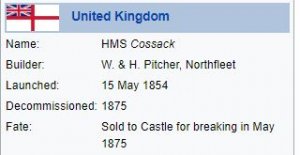
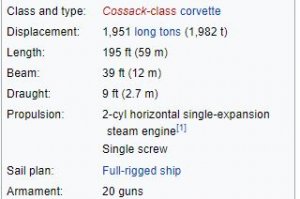

Both these ships were being built for the Russians in 1854 by Pitcher of Northfleet, on the Thames, when they were confiscated and instead commissioned for the Navy as a consequence of the Crimean War. They are of the same design, both were wooden screw corvettes of 1296 tons, 195 x 39 ft, but have different armament. The 'Cossack' (ex-'Witjas) mounted twenty 8-inch guns: the 'Tartar' (ex-'Wojn') mounted two 110-pdrs, four 40-pdrs and fourteen 8-inch. They were launched within two days of each other on 15 and 17 May 1854 and were eventually broken up by Castle's at Charlton, also on the Thames, 'Tartar' in 1866 and 'Cossack' in 1875. Some of 'Cossack's' Baltic service is visually recorded in the Baltic album of Captain (late Admiral Sir) Edward Gennys Fanshawe who commanded her there in 1855-56 (PAI4673 and following)
She was commissioned and sailed for the Baltic Sea. During the Crimean War, four vessels of the Royal Navy—Arrogant, Cossack, Magicienne, and Ruby—silenced the Russian batteries at a fort on Gogland on 21 July 1855. Cossack also participated in the blockade of the Courland coast, in July 1855 helped in the capture of Kotka's Island and in August was part of the bombardment of Sveaborg.
Her next posting was on Cape of Good Hope Station, she transported Sir George Grey to his posting as Governor of New Zealand in 1861. She was later sent to China Station before joining the Australia Station in September 1871. She left the Australia Station in 1873 and sailed for England.
She was sold to Castle for breaking up at Charlton in May 1875.

Port side view of the screw corvette HMS Cossack.
Sistership HMS Tartar (1854), ordered as the Russian screw corvette Wojn from a shipyard on the Thames, but seized by Britain while under construction, launched in 1854 and scrapped in 1866
https://en.wikipedia.org/wiki/HMS_Cossack_(1854)
15 May 1854 – Launch of HMS Cossack, a wooden 20-gun corvette, built at Northfleet. She was originally laid down for the Imperial Russian Navy as the corvette Witjas, however was confiscated during the Crimean War in 1854.
HMS Cossack was a wooden 20-gun corvette, built at Northfleet and launched on 15 May 1854. She was originally laid down for the Imperial Russian Navy as the corvette Witjas, however was confiscated during the Crimean War in 1854.




Both these ships were being built for the Russians in 1854 by Pitcher of Northfleet, on the Thames, when they were confiscated and instead commissioned for the Navy as a consequence of the Crimean War. They are of the same design, both were wooden screw corvettes of 1296 tons, 195 x 39 ft, but have different armament. The 'Cossack' (ex-'Witjas) mounted twenty 8-inch guns: the 'Tartar' (ex-'Wojn') mounted two 110-pdrs, four 40-pdrs and fourteen 8-inch. They were launched within two days of each other on 15 and 17 May 1854 and were eventually broken up by Castle's at Charlton, also on the Thames, 'Tartar' in 1866 and 'Cossack' in 1875. Some of 'Cossack's' Baltic service is visually recorded in the Baltic album of Captain (late Admiral Sir) Edward Gennys Fanshawe who commanded her there in 1855-56 (PAI4673 and following)
She was commissioned and sailed for the Baltic Sea. During the Crimean War, four vessels of the Royal Navy—Arrogant, Cossack, Magicienne, and Ruby—silenced the Russian batteries at a fort on Gogland on 21 July 1855. Cossack also participated in the blockade of the Courland coast, in July 1855 helped in the capture of Kotka's Island and in August was part of the bombardment of Sveaborg.
Her next posting was on Cape of Good Hope Station, she transported Sir George Grey to his posting as Governor of New Zealand in 1861. She was later sent to China Station before joining the Australia Station in September 1871. She left the Australia Station in 1873 and sailed for England.
She was sold to Castle for breaking up at Charlton in May 1875.

Port side view of the screw corvette HMS Cossack.
Sistership HMS Tartar (1854), ordered as the Russian screw corvette Wojn from a shipyard on the Thames, but seized by Britain while under construction, launched in 1854 and scrapped in 1866
https://en.wikipedia.org/wiki/HMS_Cossack_(1854)
Today in Naval History - Naval / Maritime Events in History
15 May 1864 - SS Tristram Shandy, an iron-hulled sidewheel steamer completed in 1864 at Greenock, Scotland, used as a blockade runner, was captured by the USS Kansas.
USS Tristram Shandy (1864) was a 444-ton steamer and blockade runner captured by the Union Navy during the American Civil War.
With her Parrott rifle installed, she was used by the Navy as a gunboat to patrol navigable waterways of the Confederate States of America to prevent the South from trading with other countries.

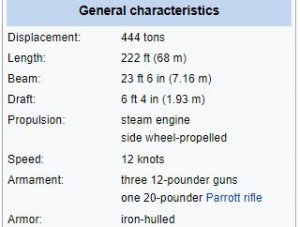
Confederate Navy
Tristram Shandy took her name from the hero—and the shortened title—of the novel, The Life and Opinions of Tristram Shandy, Gentleman, which was written by Laurence Sterne between the years 1759 and 1767. She was a schooner-rigged, iron-hulled sidewheel steamer completed in 1864 at Greenock, Scotland. She was originally owned by Matthew Isaac Wilson, a Liverpool, England, merchant. The ship subsequently sailed for the Bahamas, whence she took part in British efforts to continue trade with Southern states during the American Civil War.
On her first attempt to run the Federal blockade, Tristram Shandy outdistanced a Union pursuer by dumping cargo overboard to gain a few more knots of speed. After reaching Wilmington, North Carolina, she returned to Nassau, Bahamas, to pick up another cargo earmarked for the Confederate States of America.
Taken as a prize
Successfully slipping through the blockade, she unloaded at Wilmington and took on board a valuable cargo of cotton, turpentine, and tobacco. In addition, $50,000 in Confederate specie reposed in the ship's safe.
On 15 May 1864, the steamer attempted to slip to sea under the protective covering of a rain squall. The ship was darkened to avoid detection by roving Union patrols, but her funnels suddenly commenced throwing highly visible flames. Union gunboat USS Kansasspotted the telltale light and gave chase. For two hours, Kansas pursued and slowly gained on the fleeing blockade runner.
Meanwhile, Tristram Shandy's master frantically called down for more steam. The fugitive steamer's engineer zealously carried out the orders from the bridge until a valve failure stopped her engine. Slowly, the blockade runner lost way and lay dead in the water, an easy prey for Union sailors.
A boarding party from Kansas rigged a towline to the prize, and the blockader towed her to Beaufort, North Carolina. The erstwhile blockade runner was then taken to Massachusetts where the Navy purchased her from the Boston, Massachusetts, Prize Court.
Union Navy ship
Converted to a gunboat
Repaired and converted to a gunboat at the Boston Navy Yard, the ship proceeded to Hampton Roads, Virginia, where she was commissioned on 12 August 1864, Acting Vol. Lt. Edward F. Devens in command. Eleven days later, the ship arrived off Wilmington on 23 August and began duty as a blockader.
On 7 September, her lookout sighted a strange ship. However, the distance between the two ships was too great, and the quarry slipped away. Her next chance came on 31 October when she joined USS Santiago de Cuba and USS Mount Vernon in pursuing a blockade runner which escaped after a three-hour chase.
Destroying a blockade runner
On 3 December 1864, a blockade runner, whose name could not be determined, ran aground off the western bar at Wilmington, at Marshall Shoals. Although within range of Fort Fisher's guns, Tristram Shandy closed the disabled blockade runner to destroy her before she could be salvaged by Southern forces. Commencing fire with her Parrott rifle and her 3-pounders, the Union gunboat soon reduced the grounded runner to a blazing wreck, down by the bow and sinking from numerous hits.
Meanwhile, Confederate batteries opened fire on the gunboat, and several Southern shells splashed close alongside. Through skillful maneuvering by her commanding officer, Tristram Shandy emerged unscathed, as she kept behind the clouds of smoke from her own guns and thus confused the Confederate lookouts spotting for the fort's heavy rifles.
Attack on Fort Fisher
On Christmas Eve, in an attempt to take Fort Fisher and thus close the Confederacy's last major seaport, Rear Admiral David D. Porter deployed a large fleet of gunboats, ironclads, and transports off the fort and commenced laying down a heavy shore bombardment. Army forces slated to take part in the operation, under General Benjamin Franklin Butler, arrived from northward too late to commence operations on the first day. Ill feeling resulted between Butler and Porter, with the former officer returning to Washington, D.C., and the operation temporarily shelved.
After participating in the initial December bombardments of Fort Fisher, Tristram Shandy took part in the second assault which commenced on Friday, 13 January 1865. A frontal assault by sailors and marines drawn from landing forces in the Fleet suffered disastrously as fusillades of gunfire from Confederate sharpshooters and cannoneers swept them down as wheat before a scythe. Meanwhile, Union Army forces attacked from the landward side, storming the fort's relatively undefended rear. By 15 January, Fisher was secured in Union hands, and the last barrier to Wilmington was removed, enabling the Union to stop the flow of supplies through the Confederacy's last seaport.
Tristram Shandy resumed patrol operations off Wilmington; and, on 25 January 1865, she captured blockade runner Blenheim. The runner's captain and crew had not received the news of the fall of Fort Fisher and anchored off Mound Battery. He thus fell prey to Union sailors from the gunboat, who boarded Blenheim, and captured her easily.
East Gulf blockade
On 31 January, Tristram Shandy joined the East Gulf Blockading Squadron and remained with that group into the spring. Returning north, she served as a dispatch vessel with Union forces operating in Hampton Roads, Virginia. Admiral Porter embarked in Tristram Shandy on 14 April, after the admiral had previously escorted President Abraham Lincoln on a tour of the devastated fallen Confederate capital of Richmond, Virginia.
Two days later, the ship moored at Baltimore, Maryland, where the admiral was greeted with the sad news that the President had been assassinated the previous night in Washington.
End of hostilities
On 26 April, the ship returned to Hampton Roads to continue her duties as a dispatch vessel, operating off the Virginia Capes, concurrently serving as a lookout and keeping watch for the Confederate ram CSS Stonewall, believed to be still at sea and unaware that hostilities had ceased.
Tristram Shandy then conveyed Confederate prisoners of war to Fort Pulaski, Georgia, in late May and returned to Hampton Roads on 2 June. Upon arrival, she was assigned to duty as a roving vessel operating under the direct orders of the Commander of the North Atlantic Squadron, for his use in inspecting the various ships and stations under his command.
Sale, and civilian career
For other ships with the same name, see USS Boxer.
On 12 June 1865, her name was changed to Boxer. Her service as a warship finished, Tristram Shandy was laid up at Philadelphia, Pennsylvania, in the late summer of 1865. She remained in reserve until sold on 1 September 1868 to J. N. Middleton, of Philadelphia, who renamed her Firefly.
The erstwhile blockade runner and gunboat operated subsequently in mercantile service under a succession of owners until she ran aground off Havana, Cuba, and was declared a total loss in 1874.
USS Kansas (1863) was a gunboat constructed for the Union Navy during the middle of the American Civil War. She was outfitted with heavy guns and assigned to the Union blockade of the waterways of the Confederate States of America. She was the first U.S. Navy ship to be named Kansas and was the first of a class of 836-ton screw steam gunboats, At war's end, she continued serving her country by performing survey work and defending American interests in Cuba until sold in 1883.
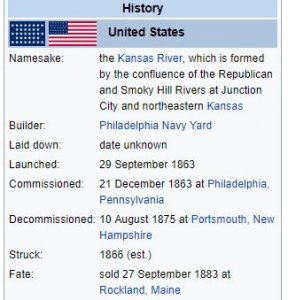


USS Kansas on the James River, Virginia, circa February–April 1865. Note her white smokestack, and three officers seated on shore.
 en.wikipedia.org
https://en.wikipedia.org/wiki/USS_Kansas_(1863)
en.wikipedia.org
https://en.wikipedia.org/wiki/USS_Kansas_(1863)
15 May 1864 - SS Tristram Shandy, an iron-hulled sidewheel steamer completed in 1864 at Greenock, Scotland, used as a blockade runner, was captured by the USS Kansas.
USS Tristram Shandy (1864) was a 444-ton steamer and blockade runner captured by the Union Navy during the American Civil War.
With her Parrott rifle installed, she was used by the Navy as a gunboat to patrol navigable waterways of the Confederate States of America to prevent the South from trading with other countries.


Confederate Navy
Tristram Shandy took her name from the hero—and the shortened title—of the novel, The Life and Opinions of Tristram Shandy, Gentleman, which was written by Laurence Sterne between the years 1759 and 1767. She was a schooner-rigged, iron-hulled sidewheel steamer completed in 1864 at Greenock, Scotland. She was originally owned by Matthew Isaac Wilson, a Liverpool, England, merchant. The ship subsequently sailed for the Bahamas, whence she took part in British efforts to continue trade with Southern states during the American Civil War.
On her first attempt to run the Federal blockade, Tristram Shandy outdistanced a Union pursuer by dumping cargo overboard to gain a few more knots of speed. After reaching Wilmington, North Carolina, she returned to Nassau, Bahamas, to pick up another cargo earmarked for the Confederate States of America.
Taken as a prize
Successfully slipping through the blockade, she unloaded at Wilmington and took on board a valuable cargo of cotton, turpentine, and tobacco. In addition, $50,000 in Confederate specie reposed in the ship's safe.
On 15 May 1864, the steamer attempted to slip to sea under the protective covering of a rain squall. The ship was darkened to avoid detection by roving Union patrols, but her funnels suddenly commenced throwing highly visible flames. Union gunboat USS Kansasspotted the telltale light and gave chase. For two hours, Kansas pursued and slowly gained on the fleeing blockade runner.
Meanwhile, Tristram Shandy's master frantically called down for more steam. The fugitive steamer's engineer zealously carried out the orders from the bridge until a valve failure stopped her engine. Slowly, the blockade runner lost way and lay dead in the water, an easy prey for Union sailors.
A boarding party from Kansas rigged a towline to the prize, and the blockader towed her to Beaufort, North Carolina. The erstwhile blockade runner was then taken to Massachusetts where the Navy purchased her from the Boston, Massachusetts, Prize Court.
Union Navy ship
Converted to a gunboat
Repaired and converted to a gunboat at the Boston Navy Yard, the ship proceeded to Hampton Roads, Virginia, where she was commissioned on 12 August 1864, Acting Vol. Lt. Edward F. Devens in command. Eleven days later, the ship arrived off Wilmington on 23 August and began duty as a blockader.
On 7 September, her lookout sighted a strange ship. However, the distance between the two ships was too great, and the quarry slipped away. Her next chance came on 31 October when she joined USS Santiago de Cuba and USS Mount Vernon in pursuing a blockade runner which escaped after a three-hour chase.
Destroying a blockade runner
On 3 December 1864, a blockade runner, whose name could not be determined, ran aground off the western bar at Wilmington, at Marshall Shoals. Although within range of Fort Fisher's guns, Tristram Shandy closed the disabled blockade runner to destroy her before she could be salvaged by Southern forces. Commencing fire with her Parrott rifle and her 3-pounders, the Union gunboat soon reduced the grounded runner to a blazing wreck, down by the bow and sinking from numerous hits.
Meanwhile, Confederate batteries opened fire on the gunboat, and several Southern shells splashed close alongside. Through skillful maneuvering by her commanding officer, Tristram Shandy emerged unscathed, as she kept behind the clouds of smoke from her own guns and thus confused the Confederate lookouts spotting for the fort's heavy rifles.
Attack on Fort Fisher
On Christmas Eve, in an attempt to take Fort Fisher and thus close the Confederacy's last major seaport, Rear Admiral David D. Porter deployed a large fleet of gunboats, ironclads, and transports off the fort and commenced laying down a heavy shore bombardment. Army forces slated to take part in the operation, under General Benjamin Franklin Butler, arrived from northward too late to commence operations on the first day. Ill feeling resulted between Butler and Porter, with the former officer returning to Washington, D.C., and the operation temporarily shelved.
After participating in the initial December bombardments of Fort Fisher, Tristram Shandy took part in the second assault which commenced on Friday, 13 January 1865. A frontal assault by sailors and marines drawn from landing forces in the Fleet suffered disastrously as fusillades of gunfire from Confederate sharpshooters and cannoneers swept them down as wheat before a scythe. Meanwhile, Union Army forces attacked from the landward side, storming the fort's relatively undefended rear. By 15 January, Fisher was secured in Union hands, and the last barrier to Wilmington was removed, enabling the Union to stop the flow of supplies through the Confederacy's last seaport.
Tristram Shandy resumed patrol operations off Wilmington; and, on 25 January 1865, she captured blockade runner Blenheim. The runner's captain and crew had not received the news of the fall of Fort Fisher and anchored off Mound Battery. He thus fell prey to Union sailors from the gunboat, who boarded Blenheim, and captured her easily.
East Gulf blockade
On 31 January, Tristram Shandy joined the East Gulf Blockading Squadron and remained with that group into the spring. Returning north, she served as a dispatch vessel with Union forces operating in Hampton Roads, Virginia. Admiral Porter embarked in Tristram Shandy on 14 April, after the admiral had previously escorted President Abraham Lincoln on a tour of the devastated fallen Confederate capital of Richmond, Virginia.
Two days later, the ship moored at Baltimore, Maryland, where the admiral was greeted with the sad news that the President had been assassinated the previous night in Washington.
End of hostilities
On 26 April, the ship returned to Hampton Roads to continue her duties as a dispatch vessel, operating off the Virginia Capes, concurrently serving as a lookout and keeping watch for the Confederate ram CSS Stonewall, believed to be still at sea and unaware that hostilities had ceased.
Tristram Shandy then conveyed Confederate prisoners of war to Fort Pulaski, Georgia, in late May and returned to Hampton Roads on 2 June. Upon arrival, she was assigned to duty as a roving vessel operating under the direct orders of the Commander of the North Atlantic Squadron, for his use in inspecting the various ships and stations under his command.
Sale, and civilian career
For other ships with the same name, see USS Boxer.
On 12 June 1865, her name was changed to Boxer. Her service as a warship finished, Tristram Shandy was laid up at Philadelphia, Pennsylvania, in the late summer of 1865. She remained in reserve until sold on 1 September 1868 to J. N. Middleton, of Philadelphia, who renamed her Firefly.
The erstwhile blockade runner and gunboat operated subsequently in mercantile service under a succession of owners until she ran aground off Havana, Cuba, and was declared a total loss in 1874.
USS Kansas (1863) was a gunboat constructed for the Union Navy during the middle of the American Civil War. She was outfitted with heavy guns and assigned to the Union blockade of the waterways of the Confederate States of America. She was the first U.S. Navy ship to be named Kansas and was the first of a class of 836-ton screw steam gunboats, At war's end, she continued serving her country by performing survey work and defending American interests in Cuba until sold in 1883.



USS Kansas on the James River, Virginia, circa February–April 1865. Note her white smokestack, and three officers seated on shore.
USS Tristram Shandy - Wikipedia
Today in Naval History - Naval / Maritime Events in History
15 May 1897 – Launch of HMS Pyramus was a Pelorus-class protected cruiser of the Royal Navy.
There were eleven "Third class"" protected cruisers in the class, which was designed by Sir William White.
While well armed for their size, they were primarily workhorses for the overseas fleet on "police" duties and did not serve with the main battlefleet.
HMS Pyramus was a Pelorus-class protected cruiser of the Royal Navy. There were eleven ""Third class"" protected cruisers in the class, which was designed by Sir William White. While well armed for their size, they were primarily workhorses for the overseas fleet on "police" duties and did not serve with the main battlefleet.

They displaced 2,135 tons, had a crew complement of 224 men and were armed with eight QF 4 inch (102 mm) (25 pounder) guns, eight 3-pounder guns, three machine guns, and two 18 inch (457 mm) torpedo tubes. With reciprocating triple expansion engines and a variety of boilers, the top speed was 20 knots (37 km/h).
HMS Pyramus was laid down at Palmers Shipbuilding and Iron Company, Jarrow in May 1896, and launched on 15 May 1897.
She served in various colonial posts, including in the Mediterranean Fleet in 1901-02. Commander Alfred Ernest Albert Grant was appointed in command on 2 August 1901. In October 1902 she was reported to be visiting Suda Bay at Crete.
In 1914 she formed part of the escort for the New Zealand Force which occupied German Samoa (now Samoa). In July 1915 she was present at the Rufiji river delta action when the monitors HMS Severn and HMS Mersey destroyed the German cruiser SMS Königsberg.
She was sold for scrap on 21 April 1920.

HMS Pyramus in 1914
The Pelorus-class cruiser was a "third-class" protected cruiser class of eleven Royal Navy warships designed by Sir William White (Director of Naval Construction 1885 – 1902), based on the earlier Pearl-class cruisers. They were ordered in 1893 under the Spencer Programme, and laid down 1896–1900. The first, HMS Pelorus, was commissioned in 1896.

Development and design
The Pelorus class ships displaced 2,135 tons and had a top speed of 20 knots (37 km/h; 23 mph). Most served in minor roles on overseas or colonial patrol work, not with the main battlefleets. They carried a complement of 224 and were armed with eight QF 4-inch (25 pounder) guns, eight 3 pounder guns, three machine guns, and two 18-inch (450-mm) torpedo tubes.
They had reciprocating triple expansion steam engines and were equipped with different types of boiler which were trialled in these cruisers. Some had Normand water-tube boilers which could give 7,000 horsepower (5,200 kW) for limited periods of time with forced draught and 5,000 horsepower (3,700 kW) under natural draught.

HMAS Psyche in Hong Kong in 1916
Ships in the class

Service
In an era of naval innovation, the class was almost outdated before they were launched. They were fitted with a variety of different boilers as a trial but most were not particularly satisfactory; so HMS Pandora was scrapped in 1913, HMS Perseus and HMS Prometheus in 1914. They had all been condemned in 1904 but had been reprieved. The remainder were to be scrapped in 1915, but were kept in service through the First World War. HMS Pegasus was sunk in combat in 1914, the rest - except for HMS Pioneer - were scrapped between 1919 and 1922. HMS Pactolus and HMS Pomone had Blechynden boilers which were particularly unreliable, they were removed from active service several years before others in the class.
Rear Admiral Cresswell, the 1st Naval Member of the Australian Naval Board described Psyche and Pyramus in 1914 as "the unspeakably useless P. class."
https://en.wikipedia.org/wiki/HMS_Pyramus_(1897)
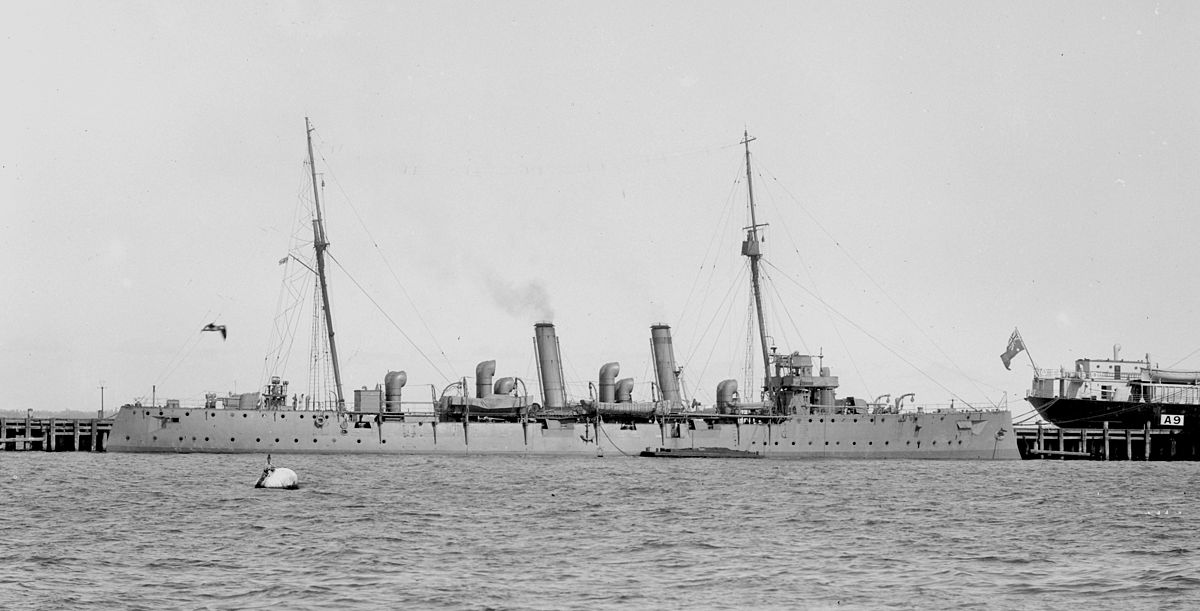
 en.wikipedia.org
en.wikipedia.org
15 May 1897 – Launch of HMS Pyramus was a Pelorus-class protected cruiser of the Royal Navy.
There were eleven "Third class"" protected cruisers in the class, which was designed by Sir William White.
While well armed for their size, they were primarily workhorses for the overseas fleet on "police" duties and did not serve with the main battlefleet.
HMS Pyramus was a Pelorus-class protected cruiser of the Royal Navy. There were eleven ""Third class"" protected cruisers in the class, which was designed by Sir William White. While well armed for their size, they were primarily workhorses for the overseas fleet on "police" duties and did not serve with the main battlefleet.

They displaced 2,135 tons, had a crew complement of 224 men and were armed with eight QF 4 inch (102 mm) (25 pounder) guns, eight 3-pounder guns, three machine guns, and two 18 inch (457 mm) torpedo tubes. With reciprocating triple expansion engines and a variety of boilers, the top speed was 20 knots (37 km/h).
HMS Pyramus was laid down at Palmers Shipbuilding and Iron Company, Jarrow in May 1896, and launched on 15 May 1897.
She served in various colonial posts, including in the Mediterranean Fleet in 1901-02. Commander Alfred Ernest Albert Grant was appointed in command on 2 August 1901. In October 1902 she was reported to be visiting Suda Bay at Crete.
In 1914 she formed part of the escort for the New Zealand Force which occupied German Samoa (now Samoa). In July 1915 she was present at the Rufiji river delta action when the monitors HMS Severn and HMS Mersey destroyed the German cruiser SMS Königsberg.
She was sold for scrap on 21 April 1920.

HMS Pyramus in 1914
The Pelorus-class cruiser was a "third-class" protected cruiser class of eleven Royal Navy warships designed by Sir William White (Director of Naval Construction 1885 – 1902), based on the earlier Pearl-class cruisers. They were ordered in 1893 under the Spencer Programme, and laid down 1896–1900. The first, HMS Pelorus, was commissioned in 1896.

Development and design
The Pelorus class ships displaced 2,135 tons and had a top speed of 20 knots (37 km/h; 23 mph). Most served in minor roles on overseas or colonial patrol work, not with the main battlefleets. They carried a complement of 224 and were armed with eight QF 4-inch (25 pounder) guns, eight 3 pounder guns, three machine guns, and two 18-inch (450-mm) torpedo tubes.
They had reciprocating triple expansion steam engines and were equipped with different types of boiler which were trialled in these cruisers. Some had Normand water-tube boilers which could give 7,000 horsepower (5,200 kW) for limited periods of time with forced draught and 5,000 horsepower (3,700 kW) under natural draught.

HMAS Psyche in Hong Kong in 1916
Ships in the class

Service
In an era of naval innovation, the class was almost outdated before they were launched. They were fitted with a variety of different boilers as a trial but most were not particularly satisfactory; so HMS Pandora was scrapped in 1913, HMS Perseus and HMS Prometheus in 1914. They had all been condemned in 1904 but had been reprieved. The remainder were to be scrapped in 1915, but were kept in service through the First World War. HMS Pegasus was sunk in combat in 1914, the rest - except for HMS Pioneer - were scrapped between 1919 and 1922. HMS Pactolus and HMS Pomone had Blechynden boilers which were particularly unreliable, they were removed from active service several years before others in the class.
Rear Admiral Cresswell, the 1st Naval Member of the Australian Naval Board described Psyche and Pyramus in 1914 as "the unspeakably useless P. class."
https://en.wikipedia.org/wiki/HMS_Pyramus_(1897)

Pelorus-class cruiser - Wikipedia
Today in Naval History - Naval / Maritime Events in History
15 May 1945 - The Battle of the Malacca Strait, sometimes called the Sinking of Haguro, and in Japanese sources as the Battle off Penang (ペナン沖海戦),
The Battle of the Malacca Strait, sometimes called the Sinking of Haguro, and in Japanese sources as the Battle off Penang (ペナン沖海戦), was a naval battle that resulted from the British search and destroy operation in May 1945, called Operation Dukedom, that resulted in the sinking of the Japanese cruiser Haguro. Haguro had been operating as a supply ship for Japanese garrisons in the Dutch East Indies and the Bay of Bengal since 1 May 1945.
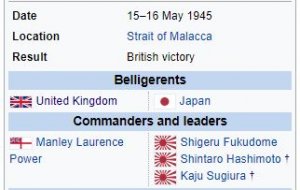


Japanese cruiser Haguro.
Background
On 9 May, Haguro left Singapore, escorted by the destroyer Kamikaze, to re-supply the Port Blair garrison on the Andaman Islands and to evacuate the troops in Port Blair back to Singapore. The Royal Navy was alerted to this by a decrypted Japanese naval signal, subsequently confirmed by a sighting by the submarines HMS Statesman and Subtle. Force 61 of the Eastern Fleet set sail on 10 May from Trincomalee, Ceylon to intercept the Japanese flotilla. The Japanese were unwilling to risk any battle and, on receipt of an air reconnaissance warning, they returned to Singapore.
On 14 May, Haguro and Kamikaze tried again and left Singapore. The next day, they were spotted by aircraft from Force 61. The subsequent bombing attack by Grumman Avenger IIs of 851 Naval Air Squadron caused only minor damage to Haguro, for the loss of an aircraft whose crew was taken prisoner by the Japanese.
Battle
Information was relayed to the Japanese that two British destroyer squadrons had been sighted heading towards them. Again, they reversed course to return to the Malacca Strait. This change had been anticipated, however, and the 26th Destroyer Flotilla (HMS Saumarez, Verulam, Venus, Vigilant, and Virago), commanded by Captain Manley Laurence Power (in Saumarez) steamed to intercept.
In heavy rain squalls with lightning, Venus made radar contact at 34 nmi (39 mi; 63 km). The British destroyers arranged themselves in a crescent cordon and allowed the Japanese ships to sail into the trap.

S class destroyer HMS Saumarez
At 01:05, Venus, parallel to Haguro as she raced past the north-westernmost ship in Power's force, found herself in a perfect attacking position. But the Torpedo Control Officer aboard Venus had made the wrong angle settings on her eight tubes, the opportunity was lost and Venus heeled hard over to port to clear the target area but still maintain the encirclement. Haguro, thinking Venus had launched torpedoes, altered course away to comb the tracks. In so doing, she turned south and deeper into the trap.
Saumarez and Verulam were now well positioned to make their attacks. Haguro appeared fine off Saumarez's port bow at a range of 6,000 yards (3.4 miles), each ship closing at 30 knots. At the same time, the Japanese destroyer Kamikaze appeared off the starboard bow, crossing from starboard to port, only 3,000 yards away and on a collision course. Saumarez's second salvo from her two forward, radar-controlled 4.7in guns struck Kamikaze and 40mm Bofors shells from the British ship's aft twin-mounting ripped the 320ft length of the Japanese destroyer as Saumarez heeled to starboard. Haguro now fired her first broadside of ten 8in and four 5in guns at Saumarez. Tremendous waterspouts thrown up alongside swamped the British flotilla leader's upper decks as Haguro was seen clearly three miles away in the light of both sides' star-shells.
At 01:11, just as she was about to fire torpedoes, Saumarez was hit. The top of her funnel disappeared over the side and a 5in shell penetrated No. 1 Boiler Room, severed a steam main and lodged inside the boiler. Five men were scalded, two of whom died, but as with the 8in shell hits, this shell failed to explode at such close range and was later thrown overboard.
At 01:15, Haguro was hit by three torpedoes from Saumarez and Verulam. As Saumarez limped northward from the immediate battle area, a violent explosion created confusion. Power thought it was Kamikaze blowing up and men on Virago and Vigilant thought it was Saumarez, but it was probably two torpedoes colliding. Venus hit Haguro with one torpedo at 01:25, and Virago stopped Haguro with two more torpedo hits two minutes later. The Japanese cruiser finally sank at 02:06 after receiving another torpedo from Vigilant, two more from Venus, and nearly an hour of gunfire from the 26th Flotilla.
Saumarez's main aerial and a funnel top had been shot away and an 8 in (200 mm) shell nicked the forecastle. Two men were killed and three burned in the boiler room when a 5 in (130 mm) shell severed the main steam pipe. There was no damage to the remainder of the 26th Flotilla.
Aftermath
Kamikaze was also damaged, but escaped, returning the next day to rescue survivors. About 320 survived, but over 900 died, including the Japanese commanders, Vice-Admiral Hashimoto and Rear-Admiral Sugiura.
This was one of the last major surface gun and torpedo actions of World War II. Lord Louis Mountbatten, himself a distinguished destroyer captain, described it in his Report to the Combined Chiefs of Staff (CCS) as 'an outstanding example of a night attack by destroyers.'
Shipwreck
In 2010 a diving expedition surveyed the wreck in detail. Several years later, circa 2014, the wreck was reported destroyed by illegal salvagers.
Haguro (羽黒) was a Myōkō-class heavy cruiser of the Imperial Japanese Navy, named after Mount Haguro in Yamagata Prefecture. Commissioned in 1929, Haguro saw significant service during World War II, participating in nine naval engagements. She was sunk in 1945 during a fight with Royal Navy destroyers, one of the last major Japanese warships to be sunk in open waters during World War II.
Design
Haguro was the third of the four-member Myōkō class of heavy cruiser; the other ships were Myōkō (妙高), Nachi (那智), and Ashigara (足柄). The ships of this class displaced 13,300 tons, were 201 metres (659 ft) long, and were capable of 36 knots (67 km/h; 41 mph). They carried two aircraft and their main armament was ten 203 mm (8 in) guns in five twin turrets. At the time they were built, this was the heaviest armament of any cruiser class in the world.
Construction and career
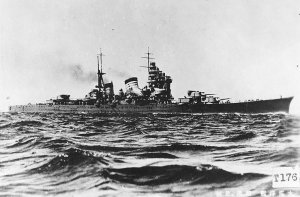
Haguro
Haguro was laid down at the Mitsubishi shipyard in Nagasaki on 16 March 1925, launched and named on 24 March 1928, and was commissioned into the Imperial Navy on 25 April 1929.
Between 1931 and 1933 she was commanded by Nomura Naokuni who subsequently achieved flag rank.
Her service in World War II started in the Dutch East Indies, where she engaged the enemy off Makassar on 8 February 1942. Haguro played a key role in the Battle of the Java Sea on 27 February 1942, and was involved in the sinking of the cruisers HMS Exeter and the Dutch flagship HNLMS De Ruyter, the destroyer HNLMS Kortenaer and of the destroyer HMS Encounter in another action off south Borneo on 1 March 1942.
On 7 May 1942, she participated in the Battle of the Coral Sea, moving on to the Solomon Islands where she took part in the Battle of the Eastern Solomons on 24 August 1942, the evacuation from Guadalcanal at the end of January 1943. Haguro took light damage in the Battle of Empress Augusta Bay on 2 November 1943. On 19 June 1944, she survived the Battle of the Philippine Sea, and from 23–25 October 1944 she took light damage in the Battle of Leyte Gulf.
Battle of the Malacca Strait and fate
Further information: Battle of the Malacca Strait
In May 1945, Haguro was the target of the British "Operation Dukedom" and was ambushed. The 26th Destroyer Flotilla found her with the destroyer Kamikaze just after midnight on 16 May 1945, and began the attack. During the battle, Kamikaze was lightly damaged, but Haguro was hit by gunfire and three Mark IX torpedoes from the British destroyers. She soon began to slow down and took a 30-degree list to port.
At 02:32, Haguro began to go down stern first in the Malacca Strait, 55 mi (48 nmi; 89 km) off Penang; Kamikaze rescued 320 survivors, but 900 men, including Vice Admiral Hashimoto and Rear Admiral Sugiura, perished with her. Rear Admiral Sugiura was posthumously promoted to Vice Admiral on 16 May. Haguro was the last major Japanese warship to be sunk in a surface action during the war.
Haguro was stricken from the navy list on 20 June 1945.

Haguro under attack at Rabaul on 2 November 1943, showing damage received in the battle of Empress Augusta Bay that morning.
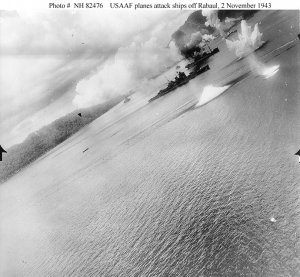
USAAF gun camera footage of Haguro under attack at Rabaul
Shipwreck
On 4 March 2003, a group of divers operating off MV Empress discovered the wreck of Haguro in 67 meters of water in the Malacca Strait south of the Island of Penang. The wreck sits upright, covered in places by discarded trawler nets with her hull opposite her forward turrets buried in the seabed to about her original waterline, but this level gradually reduces until at the stern her outer propellers and shafts are actually up above the seabed. Her foremast and the top half of the bridge structure are missing/collapsed. Her mainmast is collapsed. Her funnels are missing. British hits are visible in places. The bow section forward of No. 2 turret is decimated by torpedo hits. Haguro's No. 1 turret and barbette are completely uprooted and now lie against the hull, the rear of the turret on the starboard sea bed and the barrels pointing vertically towards the surface. Her No. 2 turret is trained to starboard at approximately the 1 o’clock position, with its roof collapsed and both barrels and breeches missing (i.e. they were not replaced after being damaged by a bomb at the earlier Battle of Leyte Gulf). Her No. 3 turret's guns are askew and trained to the port quarter, i.e. the 8 o’clock position. Both her stern main turrets’ guns point almost directly astern. Just behind the No. 5 turret, the wreck is broken completely in half, although the very stern section is still ‘partially’ attached and heavily damaged on the port side.
In 2010 a further diving expedition surveyed the wreck in detail.
In 2014 the wreck was reported to have been heavily destroyed by illegal salvors.

(Haguro - digitally colorized by Irotooko, Jr)
https://en.wikipedia.org/wiki/Battle_of_the_Malacca_Strait
https://en.wikipedia.org/wiki/Japanese_cruiser_Haguro
15 May 1945 - The Battle of the Malacca Strait, sometimes called the Sinking of Haguro, and in Japanese sources as the Battle off Penang (ペナン沖海戦),
The Battle of the Malacca Strait, sometimes called the Sinking of Haguro, and in Japanese sources as the Battle off Penang (ペナン沖海戦), was a naval battle that resulted from the British search and destroy operation in May 1945, called Operation Dukedom, that resulted in the sinking of the Japanese cruiser Haguro. Haguro had been operating as a supply ship for Japanese garrisons in the Dutch East Indies and the Bay of Bengal since 1 May 1945.



Japanese cruiser Haguro.
Background
On 9 May, Haguro left Singapore, escorted by the destroyer Kamikaze, to re-supply the Port Blair garrison on the Andaman Islands and to evacuate the troops in Port Blair back to Singapore. The Royal Navy was alerted to this by a decrypted Japanese naval signal, subsequently confirmed by a sighting by the submarines HMS Statesman and Subtle. Force 61 of the Eastern Fleet set sail on 10 May from Trincomalee, Ceylon to intercept the Japanese flotilla. The Japanese were unwilling to risk any battle and, on receipt of an air reconnaissance warning, they returned to Singapore.
On 14 May, Haguro and Kamikaze tried again and left Singapore. The next day, they were spotted by aircraft from Force 61. The subsequent bombing attack by Grumman Avenger IIs of 851 Naval Air Squadron caused only minor damage to Haguro, for the loss of an aircraft whose crew was taken prisoner by the Japanese.
Battle
Information was relayed to the Japanese that two British destroyer squadrons had been sighted heading towards them. Again, they reversed course to return to the Malacca Strait. This change had been anticipated, however, and the 26th Destroyer Flotilla (HMS Saumarez, Verulam, Venus, Vigilant, and Virago), commanded by Captain Manley Laurence Power (in Saumarez) steamed to intercept.
In heavy rain squalls with lightning, Venus made radar contact at 34 nmi (39 mi; 63 km). The British destroyers arranged themselves in a crescent cordon and allowed the Japanese ships to sail into the trap.

S class destroyer HMS Saumarez
At 01:05, Venus, parallel to Haguro as she raced past the north-westernmost ship in Power's force, found herself in a perfect attacking position. But the Torpedo Control Officer aboard Venus had made the wrong angle settings on her eight tubes, the opportunity was lost and Venus heeled hard over to port to clear the target area but still maintain the encirclement. Haguro, thinking Venus had launched torpedoes, altered course away to comb the tracks. In so doing, she turned south and deeper into the trap.
Saumarez and Verulam were now well positioned to make their attacks. Haguro appeared fine off Saumarez's port bow at a range of 6,000 yards (3.4 miles), each ship closing at 30 knots. At the same time, the Japanese destroyer Kamikaze appeared off the starboard bow, crossing from starboard to port, only 3,000 yards away and on a collision course. Saumarez's second salvo from her two forward, radar-controlled 4.7in guns struck Kamikaze and 40mm Bofors shells from the British ship's aft twin-mounting ripped the 320ft length of the Japanese destroyer as Saumarez heeled to starboard. Haguro now fired her first broadside of ten 8in and four 5in guns at Saumarez. Tremendous waterspouts thrown up alongside swamped the British flotilla leader's upper decks as Haguro was seen clearly three miles away in the light of both sides' star-shells.
At 01:11, just as she was about to fire torpedoes, Saumarez was hit. The top of her funnel disappeared over the side and a 5in shell penetrated No. 1 Boiler Room, severed a steam main and lodged inside the boiler. Five men were scalded, two of whom died, but as with the 8in shell hits, this shell failed to explode at such close range and was later thrown overboard.
At 01:15, Haguro was hit by three torpedoes from Saumarez and Verulam. As Saumarez limped northward from the immediate battle area, a violent explosion created confusion. Power thought it was Kamikaze blowing up and men on Virago and Vigilant thought it was Saumarez, but it was probably two torpedoes colliding. Venus hit Haguro with one torpedo at 01:25, and Virago stopped Haguro with two more torpedo hits two minutes later. The Japanese cruiser finally sank at 02:06 after receiving another torpedo from Vigilant, two more from Venus, and nearly an hour of gunfire from the 26th Flotilla.
Saumarez's main aerial and a funnel top had been shot away and an 8 in (200 mm) shell nicked the forecastle. Two men were killed and three burned in the boiler room when a 5 in (130 mm) shell severed the main steam pipe. There was no damage to the remainder of the 26th Flotilla.
Aftermath
Kamikaze was also damaged, but escaped, returning the next day to rescue survivors. About 320 survived, but over 900 died, including the Japanese commanders, Vice-Admiral Hashimoto and Rear-Admiral Sugiura.
This was one of the last major surface gun and torpedo actions of World War II. Lord Louis Mountbatten, himself a distinguished destroyer captain, described it in his Report to the Combined Chiefs of Staff (CCS) as 'an outstanding example of a night attack by destroyers.'
Shipwreck
In 2010 a diving expedition surveyed the wreck in detail. Several years later, circa 2014, the wreck was reported destroyed by illegal salvagers.
Haguro (羽黒) was a Myōkō-class heavy cruiser of the Imperial Japanese Navy, named after Mount Haguro in Yamagata Prefecture. Commissioned in 1929, Haguro saw significant service during World War II, participating in nine naval engagements. She was sunk in 1945 during a fight with Royal Navy destroyers, one of the last major Japanese warships to be sunk in open waters during World War II.
Design
Haguro was the third of the four-member Myōkō class of heavy cruiser; the other ships were Myōkō (妙高), Nachi (那智), and Ashigara (足柄). The ships of this class displaced 13,300 tons, were 201 metres (659 ft) long, and were capable of 36 knots (67 km/h; 41 mph). They carried two aircraft and their main armament was ten 203 mm (8 in) guns in five twin turrets. At the time they were built, this was the heaviest armament of any cruiser class in the world.
Construction and career

Haguro
Haguro was laid down at the Mitsubishi shipyard in Nagasaki on 16 March 1925, launched and named on 24 March 1928, and was commissioned into the Imperial Navy on 25 April 1929.
Between 1931 and 1933 she was commanded by Nomura Naokuni who subsequently achieved flag rank.
Her service in World War II started in the Dutch East Indies, where she engaged the enemy off Makassar on 8 February 1942. Haguro played a key role in the Battle of the Java Sea on 27 February 1942, and was involved in the sinking of the cruisers HMS Exeter and the Dutch flagship HNLMS De Ruyter, the destroyer HNLMS Kortenaer and of the destroyer HMS Encounter in another action off south Borneo on 1 March 1942.
On 7 May 1942, she participated in the Battle of the Coral Sea, moving on to the Solomon Islands where she took part in the Battle of the Eastern Solomons on 24 August 1942, the evacuation from Guadalcanal at the end of January 1943. Haguro took light damage in the Battle of Empress Augusta Bay on 2 November 1943. On 19 June 1944, she survived the Battle of the Philippine Sea, and from 23–25 October 1944 she took light damage in the Battle of Leyte Gulf.
Battle of the Malacca Strait and fate
Further information: Battle of the Malacca Strait
In May 1945, Haguro was the target of the British "Operation Dukedom" and was ambushed. The 26th Destroyer Flotilla found her with the destroyer Kamikaze just after midnight on 16 May 1945, and began the attack. During the battle, Kamikaze was lightly damaged, but Haguro was hit by gunfire and three Mark IX torpedoes from the British destroyers. She soon began to slow down and took a 30-degree list to port.
At 02:32, Haguro began to go down stern first in the Malacca Strait, 55 mi (48 nmi; 89 km) off Penang; Kamikaze rescued 320 survivors, but 900 men, including Vice Admiral Hashimoto and Rear Admiral Sugiura, perished with her. Rear Admiral Sugiura was posthumously promoted to Vice Admiral on 16 May. Haguro was the last major Japanese warship to be sunk in a surface action during the war.
Haguro was stricken from the navy list on 20 June 1945.

Haguro under attack at Rabaul on 2 November 1943, showing damage received in the battle of Empress Augusta Bay that morning.

USAAF gun camera footage of Haguro under attack at Rabaul
Shipwreck
On 4 March 2003, a group of divers operating off MV Empress discovered the wreck of Haguro in 67 meters of water in the Malacca Strait south of the Island of Penang. The wreck sits upright, covered in places by discarded trawler nets with her hull opposite her forward turrets buried in the seabed to about her original waterline, but this level gradually reduces until at the stern her outer propellers and shafts are actually up above the seabed. Her foremast and the top half of the bridge structure are missing/collapsed. Her mainmast is collapsed. Her funnels are missing. British hits are visible in places. The bow section forward of No. 2 turret is decimated by torpedo hits. Haguro's No. 1 turret and barbette are completely uprooted and now lie against the hull, the rear of the turret on the starboard sea bed and the barrels pointing vertically towards the surface. Her No. 2 turret is trained to starboard at approximately the 1 o’clock position, with its roof collapsed and both barrels and breeches missing (i.e. they were not replaced after being damaged by a bomb at the earlier Battle of Leyte Gulf). Her No. 3 turret's guns are askew and trained to the port quarter, i.e. the 8 o’clock position. Both her stern main turrets’ guns point almost directly astern. Just behind the No. 5 turret, the wreck is broken completely in half, although the very stern section is still ‘partially’ attached and heavily damaged on the port side.
In 2010 a further diving expedition surveyed the wreck in detail.
In 2014 the wreck was reported to have been heavily destroyed by illegal salvors.

(Haguro - digitally colorized by Irotooko, Jr)
https://en.wikipedia.org/wiki/Battle_of_the_Malacca_Strait
https://en.wikipedia.org/wiki/Japanese_cruiser_Haguro
Today in Naval History - Naval / Maritime Events in History
15 May 1969 - The pre-commissioned submarine USS Guitarro (SSN 665) accidentally sinks while moored at U.S. Mare Island Naval Shipyard, Calif. Due to the damage, her commissioning date is rescheduled to Sept. 1972.
USS Guitarro (SSN-665), a Sturgeon-class submarine, was the second ship of the United States Navy to be named for the guitarro, a ray of the guitarfish family.
Construction and commissioning
Keel-laying and launching
The contract to build Guitarro was awarded to Mare Island Naval Shipyard at Vallejo, California, on 18 December 1964 and her keel was laid down there on 9 December 1965. She was launched on 27 July 1968, sponsored by Mrs. John M. Taylor.
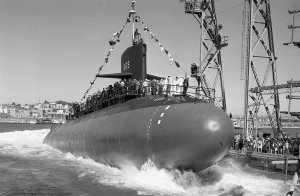
Guitarro (SSN-665) entering the water at Mare Island on 27 July 1968.
Sinking
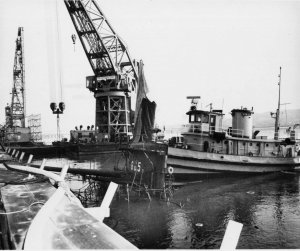
The Guitarro (SSN-665) is on the bottom of the Napa River after her accidental sinking at Mare Island on 15 May 1969. (Note: The reactor had not been installed). Other vessels in the picture are from left to right; unknown YD, YD-33 (150 Ton Crane), and Satanta (YTM-270). Satanta is preventing the Guitarro from capsizing.
(On a personal note: I was working the installation of her MK-113 fire control system at the time, but I was in training at the time of her sinking and salvage. I did return in time to remove the mounting rails and the reference sensing elements from the forward portion of the torpedo tubes. These units were located on the tubes just before they penetrated the pressure hull. This experiences gave a new meaning to "sewer pipes.")
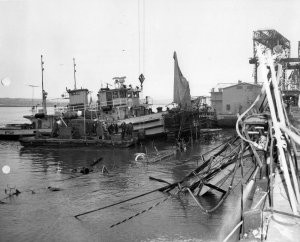
Navy tugs Satanta (YTM-270) and DekauryYTM-178 with the shipyard's diving barge alongside the sail of the Guitarro (SSN-665) on the morning of 16 May 1969 looking south.
On 15 May 1969, Guitarro was moored in the Napa River at Mare Island Naval Shipyard while construction was still underway. At about 16:00, a civilian nuclear construction group began an instrument calibration assignment which required the filling of certain tanks, located aft of the ship's pivot point, with approximately five tons of water. Within 30 minutes, a different, non-nuclear civilian construction group began an assignment to bring Guitarro within a half-degree of trim; this entailed the adding of water to tanks forward of the ship's pivot point to overcome a reported two-degree up-bow attitude. Until shortly before 20:00, both groups continued to add water, unaware of each other's activities.
Twice between 16:30 and 20:00, a security watch advised the non-nuclear group that Guitarro was riding so low forward that the 1.5-foot-high (0.46 m) wakes of boats operating in the Napa River were sloshing into an uncovered manhole in the most forward and lowest portion of the ship's deck; these warnings went unheeded. At 19:45, the non-nuclear group stopped adding water to the ballast tanks and began to halt work for their meal break, leaving at 20:00. At 19:50, the nuclear group completed their calibrations and began to empty the tanks aft.
At 20:30, both the nuclear group, still aboard, and the non-nuclear group, returning from their break, noticed Guitarro taking a sudden down angle which put the forward hatches underwater. Massive flooding took place through several large open hatches. Efforts between 20:30 and 20:45 to close watertight doors and hatches were largely unsuccessful because lines and cables ran through the doors and hatches, preventing them from closing. At 20:55, Guitarro sank earning her the nickname "Mare Island Mud Puppy".
Guitarro was refloated three days later, on 18 May 1969. Damages to her were estimated at $15.2 to $21.85 million (equivalent to $81 to $117 million in 2018).
Commissioning
Guitarro had been scheduled to be commissioned in January 1970, but repairs necessitated by her sinking dictated a 32-month delay. She finally was commissioned on 9 September 1972 with Commander Gordon Lange in command.
Service history
In the mid-to-late 1970s, Guitarro was stationed at Point Loma in San Diego, California, commanded by Alvin H. Pauole, followed by Scott Van Hoften. She was active at the time in the pre-operational testing of the new Tomahawk cruise missile, launching several of the missiles on a test range off the coast of Southern California.
Guitarro (SSN-665) at NAS North Island on 4 October 1990 for a VIP visit. General Mikhail Moiseyev, First Deputy Minister of Defense and Chief of the General Staff for the Soviet Union and General Colin Powell, Chairman of the Joint Chiefs of Staff, toured the forward areas of the ship that day, but did not tour the engineering spaces. Just aft of the Guitarro (SSN-665) is the Missouri BB-63.

USS Guitarro (SSN-665) hosting the first tour of a US nuclear submarine by high-ranking Russian officials: General Colin Powell is in the rear of the group
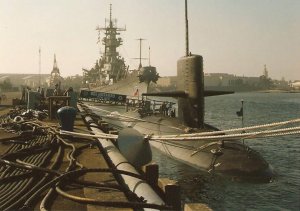
USS Guitarro (SSN-665) hosting the first tour of a US nuclear submarine by high-ranking Russian officials
Decommissioning and disposal
Guitarro was decommissioned on 29 May 1992 and stricken from the Naval Vessel Register the same day. Her scrapping via the Nuclear-Powered Ship and Submarine Recycling Program at Puget Sound Naval Shipyard in Bremerton, Washington, was completed on 18 October 1994.

 en.wikipedia.org
en.wikipedia.org
15 May 1969 - The pre-commissioned submarine USS Guitarro (SSN 665) accidentally sinks while moored at U.S. Mare Island Naval Shipyard, Calif. Due to the damage, her commissioning date is rescheduled to Sept. 1972.
USS Guitarro (SSN-665), a Sturgeon-class submarine, was the second ship of the United States Navy to be named for the guitarro, a ray of the guitarfish family.
Construction and commissioning
Keel-laying and launching
The contract to build Guitarro was awarded to Mare Island Naval Shipyard at Vallejo, California, on 18 December 1964 and her keel was laid down there on 9 December 1965. She was launched on 27 July 1968, sponsored by Mrs. John M. Taylor.

Guitarro (SSN-665) entering the water at Mare Island on 27 July 1968.
Sinking

The Guitarro (SSN-665) is on the bottom of the Napa River after her accidental sinking at Mare Island on 15 May 1969. (Note: The reactor had not been installed). Other vessels in the picture are from left to right; unknown YD, YD-33 (150 Ton Crane), and Satanta (YTM-270). Satanta is preventing the Guitarro from capsizing.
(On a personal note: I was working the installation of her MK-113 fire control system at the time, but I was in training at the time of her sinking and salvage. I did return in time to remove the mounting rails and the reference sensing elements from the forward portion of the torpedo tubes. These units were located on the tubes just before they penetrated the pressure hull. This experiences gave a new meaning to "sewer pipes.")

Navy tugs Satanta (YTM-270) and DekauryYTM-178 with the shipyard's diving barge alongside the sail of the Guitarro (SSN-665) on the morning of 16 May 1969 looking south.
On 15 May 1969, Guitarro was moored in the Napa River at Mare Island Naval Shipyard while construction was still underway. At about 16:00, a civilian nuclear construction group began an instrument calibration assignment which required the filling of certain tanks, located aft of the ship's pivot point, with approximately five tons of water. Within 30 minutes, a different, non-nuclear civilian construction group began an assignment to bring Guitarro within a half-degree of trim; this entailed the adding of water to tanks forward of the ship's pivot point to overcome a reported two-degree up-bow attitude. Until shortly before 20:00, both groups continued to add water, unaware of each other's activities.
Twice between 16:30 and 20:00, a security watch advised the non-nuclear group that Guitarro was riding so low forward that the 1.5-foot-high (0.46 m) wakes of boats operating in the Napa River were sloshing into an uncovered manhole in the most forward and lowest portion of the ship's deck; these warnings went unheeded. At 19:45, the non-nuclear group stopped adding water to the ballast tanks and began to halt work for their meal break, leaving at 20:00. At 19:50, the nuclear group completed their calibrations and began to empty the tanks aft.
At 20:30, both the nuclear group, still aboard, and the non-nuclear group, returning from their break, noticed Guitarro taking a sudden down angle which put the forward hatches underwater. Massive flooding took place through several large open hatches. Efforts between 20:30 and 20:45 to close watertight doors and hatches were largely unsuccessful because lines and cables ran through the doors and hatches, preventing them from closing. At 20:55, Guitarro sank earning her the nickname "Mare Island Mud Puppy".
Guitarro was refloated three days later, on 18 May 1969. Damages to her were estimated at $15.2 to $21.85 million (equivalent to $81 to $117 million in 2018).
Commissioning
Guitarro had been scheduled to be commissioned in January 1970, but repairs necessitated by her sinking dictated a 32-month delay. She finally was commissioned on 9 September 1972 with Commander Gordon Lange in command.
Service history
In the mid-to-late 1970s, Guitarro was stationed at Point Loma in San Diego, California, commanded by Alvin H. Pauole, followed by Scott Van Hoften. She was active at the time in the pre-operational testing of the new Tomahawk cruise missile, launching several of the missiles on a test range off the coast of Southern California.
Guitarro (SSN-665) at NAS North Island on 4 October 1990 for a VIP visit. General Mikhail Moiseyev, First Deputy Minister of Defense and Chief of the General Staff for the Soviet Union and General Colin Powell, Chairman of the Joint Chiefs of Staff, toured the forward areas of the ship that day, but did not tour the engineering spaces. Just aft of the Guitarro (SSN-665) is the Missouri BB-63.

USS Guitarro (SSN-665) hosting the first tour of a US nuclear submarine by high-ranking Russian officials: General Colin Powell is in the rear of the group

USS Guitarro (SSN-665) hosting the first tour of a US nuclear submarine by high-ranking Russian officials
Decommissioning and disposal
Guitarro was decommissioned on 29 May 1992 and stricken from the Naval Vessel Register the same day. Her scrapping via the Nuclear-Powered Ship and Submarine Recycling Program at Puget Sound Naval Shipyard in Bremerton, Washington, was completed on 18 October 1994.

USS Guitarro (SSN-665) - Wikipedia
Today in Naval History - Naval / Maritime Events in History
Other Events on 15 May
1662 – Launch of French Beaufort 36–38 (launched 15 May 1662 at Toulon) – renamed Neptune in June 1671, then Maure in January 1679; condemned 1686
Beaufort Class (2 ships) or also named Mancini class, designed by Gédéon Rodolphe with 2 x 20-pounder, 6 x 16-pounder, 10 x 12-pounder and 14 x 8-pounder guns:
Beaufort 36–38 (launched 15 May 1662 at Toulon) – renamed Neptune in June 1671, then Maure in January 1679; condemned 1686
Mercoeur 36 (launched July 1662 at Toulon) – renamed Trident in June 1671; condemned 1686
1673 - British fleet under Cptn. Richard Munden re-capture the Island of St. Helena.
Sir Richard Munden (1640–1680) was a captain in the Royal Navy. He was the elder son of Sir Richard Munden (1602–1672) of Chelsea; the younger son was Rear-Admiral Sir John Munden.
Richard first appears as commander of the Swallow ketch in 1666, and afterwards of the Portsmouth in 1667. In 1672 he was captain of the Princess of 52 guns; and in 1673, in the Assistance, was commodore of a small squadron sent as convoy to the East India fleet. Touching at St Helena for water, he found the island in the possession of the Dutch. After a spirited attack by sea and land he captured it on 4 May, and three Dutch East Indiamen, richly laden, who anchored in the bay, were seized. With his squadron and prizes and the homeward-bound ships in convoy, Munden arrived in England in August, and on 6 December was knighted by the king, "in consideration of his eminent service". In April 1677, in command of the St David, he convoyed the trade to the Mediterranean, was for some time at Zante, afterwards at Scanderoon, and for fourteen months at Smyrna. He arrived at Plymouth with the homeward trade on 12 May 1680. On 15 June he wrote to the admiralty explaining that he had not sent home the muster-books from the Mediterranean, the postage being extremely heavy, and by no means safe. Ten days later, 25 June 1680, he died. He was buried in the church at Bromley, Middlesex.
 en.wikipedia.org
en.wikipedia.org
1759 - John Jervis (later Earl St. Vincent) promoted Commander into HMS Scorpion (14).
Admiral of the Fleet John Jervis, 1st Earl of St Vincent GCB, PC (9 January 1735 – 13 March 1823) was an admiral in the Royal Navy and Member of Parliament in the United Kingdom. Jervis served throughout the latter half of the 18th century and into the 19th, and was an active commander during the Seven Years' War, American War of Independence, French Revolutionary War and the Napoleonic Wars. He is best known for his victory at the 1797 Battle of Cape Saint Vincent, from which he earned his titles, and as a patron of Horatio Nelson.
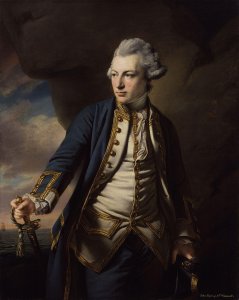
Jervis was also recognised by both political and military contemporaries as a fine administrator and naval reformer. As Commander-in-chief of the Mediterranean, between 1795 and 1799 he introduced a series of severe standing orders to avert mutiny. He applied those orders to both seamen and officers alike, a policy that made him a controversial figure. He took his disciplinarian system of command with him when he took command of the Channel Fleet in 1799. In 1801, as First Lord of the Admiralty he introduced a number of reforms that, though unpopular at the time, made the Navy more efficient and more self-sufficient. He introduced innovations including block making machinery at Portsmouth Royal Dockyard. St Vincent was known for his generosity to officers he considered worthy of reward and his swift and often harsh punishment of those he felt deserved it.
Jervis' entry in the Oxford Dictionary of National Biography by P. K. Crimmin describes his contribution to history: "His importance lies in his being the organiser of victories; the creator of well-equipped, highly efficient fleets; and in training a school of officers as professional, energetic, and devoted to the service as himself.
HMS Scorpion was a 14-gun two-masted Merlin-class sloop of the Royal Navy, built by Wyatt and Major at Bucklers Hard on the Beaulieu River in Hampshire, England and launched on 8 July 1746.
She foundered in the Irish Sea in September 1762.


 en.wikipedia.org
en.wikipedia.org
 en.wikipedia.org
en.wikipedia.org
1771 - Midshipman Horatio Nelson transfers to the HMS Triumph (74).
https://en.wikipedia.org/wiki/Horatio_Nelson,_1st_Viscount_Nelson
1790 - May 15 (May 4 OS) Fredrikshamn/Hamina in Finland - Swedish galley flotilla defeats Russian galley flotilla.
1797 - Spithead Mutiny ends
https://en.wikipedia.org/wiki/Spithead_and_Nore_mutinies
1800 - The frigate USS Essex, commanded by Capt. Edward Preble, arrives in Batavia, Java, to escort United States merchant ships. During her journey, she is the first U.S. Navy warship to cross the Equator and the first U.S. man-of-war to double the Cape of Good Hope.
The first USS Essex of the United States Navy was a 36-gun or 32-gun sailing frigate that participated in the Quasi-War with France, the First Barbary War, and in the War of 1812. The British captured her in 1814 and she then served as HMS Essex until sold at public auction on 6 June 1837.

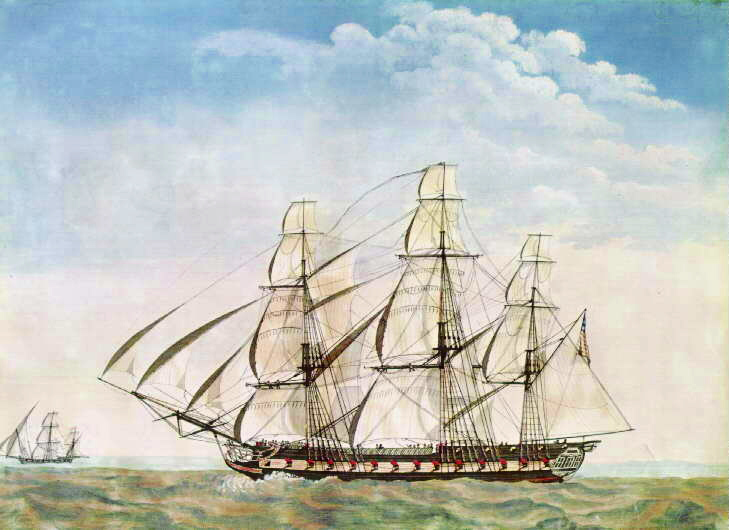
 en.wikipedia.org
en.wikipedia.org
1804 HMS Cruizer (18), John Hancock, HMS Rattler (16), Francis Mason, HMS Penelope (36), Cptn. W. R. Broughton, HMS Antelope (50), Commodore Sir Sidney Smith, and HMS Aimable (32), Cptn William Bolton, engaged Flushing flotilla of 59 vessels (2 praams, 19 schooners and 38 schuyts) off Blankenberg.
HMS Antelope (1802) was a 50-gun fourth rate launched in 1802. She was used as a troopship from 1818, was placed on harbour service from 1824 and was broken up in 1845.
HMS Penelope was a fifth-rate frigate of the Royal Navy, launched in 1798 and wrecked in 1815.
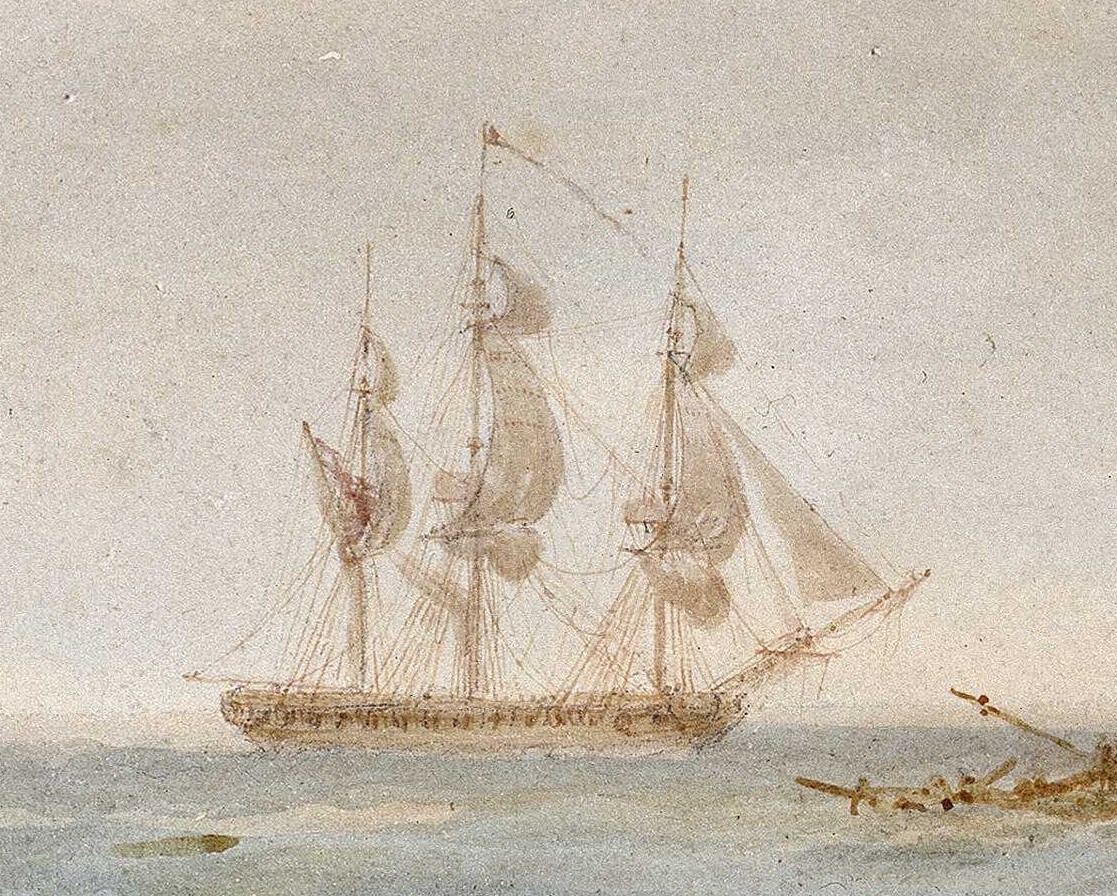
 en.wikipedia.org
en.wikipedia.org
1806 - HMS Juno (32), Capt. H. Richardson, supported a Neopolitan sortie from Gaeta.
On 15 May the garrison at Gaeta made another modestly successful sortie. Two divisions of gunboats supported the operation. Richardson commanded one division. Juno's boats, under the command of Lieutenant Thomas Wells, assisted by Lieutenant of marines Robert M. Mant joined the attack. Juno's boats sustained the allies' only loss, which consisted of four seamen killed and five wounded.
HMS Juno was a Royal Navy 32-gun Amazon-class fifth rate. This frigate served during the American War of Independence, and the French Revolutionary and Napoleonic Wars.
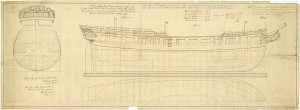

 en.wikipedia.org
en.wikipedia.org
1809 - Boats of HMS Tartar (32), Cptn. Jos. Baker, drove ashore and captured a Danish privateer (4) near Felixberg on the coast of Courland.
HMS Tartar was a 32-gun fifth-rate Narcissus-class frigate of the Royal Navy, built at Frindsbury and launched in 1801. She captured privateers on the Jamaica station and fought in the Gunboat War and elsewhere in the Baltic before being lost to grounding off Estonia in 1811.
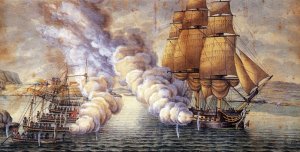
Tartar fighting gunboats at the battle of Alvøen

 en.wikipedia.org
en.wikipedia.org
1809 - HMS Mercury (28), Cptn. Henry Duncan, bombarded Rotti.
HMS Mercury was a 28-gun Enterprise-class sixth-rate frigate of the Royal Navy. She was built during the American War of Independence and serving during the later years of that conflict. She continued to serve during the years of peace and had an active career during the French Revolutionary Wars and most of the Napoleonic Wars, until being broken up in 1814.
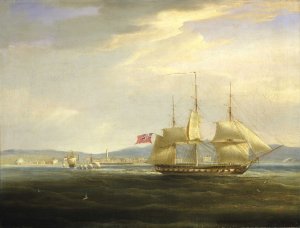

 en.wikipedia.org
en.wikipedia.org
1813 – Launch of HMS Challenger, a Cruizer-class brig-sloop launched at Redbridge, Southampton, in 1813
HMS Challenger was a Cruizer-class brig-sloop launched at Redbridge, Southampton, in 1813. She participated in the capture of a French privateer and then sailed to the East Indies. She was laid up in 1819 and sold in 1824.

 en.wikipedia.org
en.wikipedia.org
1813 - HMS Bacchante (38), Cptn. William Hoste, bombarded Karlebago and destroyed the fort and other defences.
HMS Bacchante (1811) – 38-gun fifth rate launched in 1811 at Deptford. She was converted to harbour service in 1837 and scrapped in 1858.




1828 - HMS Parthian (10), George Hotham, wrecked near Marabout Island, Egypt.
HMS Parthian (1808) was a 10-gun Cherokee-class brig-sloop launched in 1808 and wrecked on the coast of Egypt on 15 May 1828.

1856 – Launch of French Eylau was a converted fast screw ship of the line of the French Navy.
The Eylau was a converted fast screw ship of the line of the French Navy.
Started as a 100-gun Hercule class ship of the line under the name Éole, Eylau was ordered converted to mixed propulsion in 1852, even before her keel was laid.
She was used as a hulk in Toulon, and broken up in 1905.

French ship Eylau (foreground). The ships behind might be Mars and Souverain.
https://en.wikipedia.org/wiki/French_ship_Eylau_(1856)
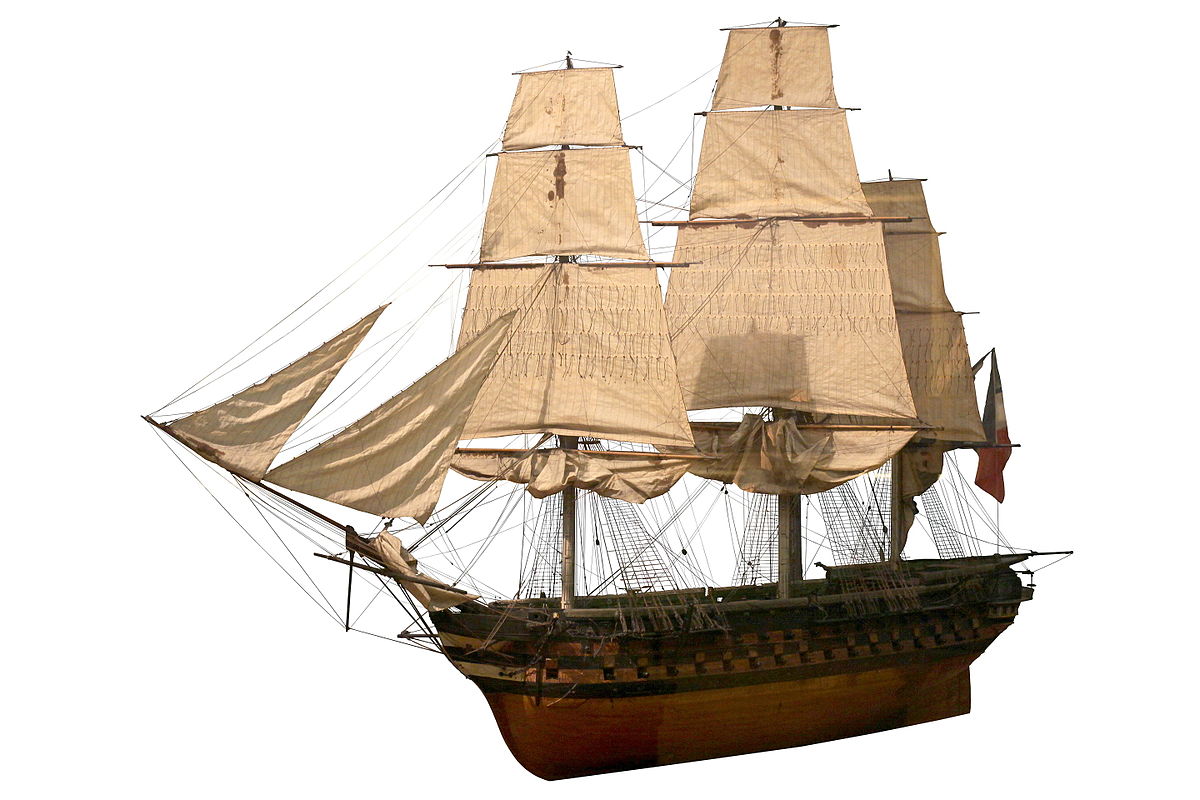
 en.wikipedia.org
en.wikipedia.org
1934 – Launch of Rainbow was a 1930 yacht of the J Class and successful defender of the 1934 America's Cup.
Rainbow was a 1930 yacht of the J Class and successful defender of the 1934 America's Cup. It was ordered by Harold Vanderbilt and designed by William Starling Burgess. Rainbow was scrapped in 1940.
A replica, Rainbow, was launched in 2012 at Holland Jachtbouw. In January 2015 it was reported that she was for sale with an asking price of €10,450,000 VAT paid.
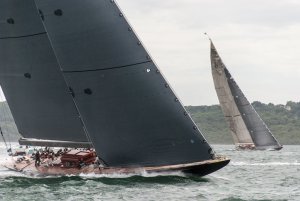
J-Class yachts Rainbow (foreground) and Velsheda under sail
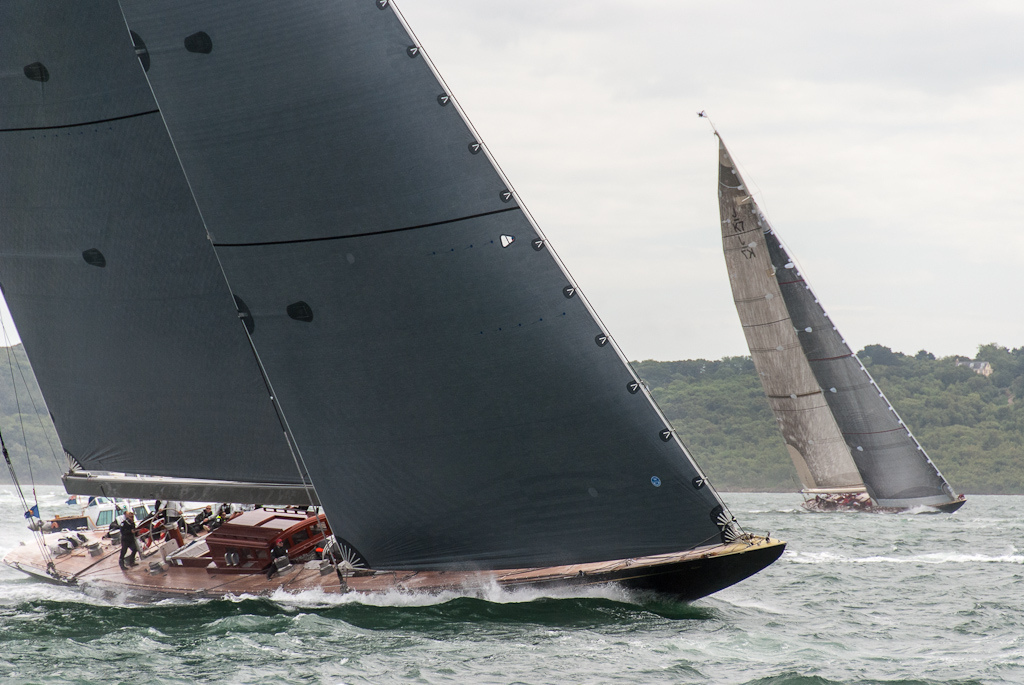
 en.wikipedia.org
en.wikipedia.org
1944 - PBY-5 Catalina aircraft from (VP 63) and British escort vessels HMS Kilmarnock and HMS Blackfly sink German submarine U 731 off Tangiers.
2014 - the double-decker ferry MV Miraj-4 capsized in the Meghna River, 50 kilometres (31 mi) southeast of Dhaka, Bangladesh. Between 150 and 200 people were on board at the time, of whom about 75 survived. As of 17 May, the official death toll stood at 54 with an unknown number of people missing.
 en.wikipedia.org
en.wikipedia.org
Other Events on 15 May
1662 – Launch of French Beaufort 36–38 (launched 15 May 1662 at Toulon) – renamed Neptune in June 1671, then Maure in January 1679; condemned 1686
Beaufort Class (2 ships) or also named Mancini class, designed by Gédéon Rodolphe with 2 x 20-pounder, 6 x 16-pounder, 10 x 12-pounder and 14 x 8-pounder guns:
Beaufort 36–38 (launched 15 May 1662 at Toulon) – renamed Neptune in June 1671, then Maure in January 1679; condemned 1686
Mercoeur 36 (launched July 1662 at Toulon) – renamed Trident in June 1671; condemned 1686
1673 - British fleet under Cptn. Richard Munden re-capture the Island of St. Helena.
Sir Richard Munden (1640–1680) was a captain in the Royal Navy. He was the elder son of Sir Richard Munden (1602–1672) of Chelsea; the younger son was Rear-Admiral Sir John Munden.
Richard first appears as commander of the Swallow ketch in 1666, and afterwards of the Portsmouth in 1667. In 1672 he was captain of the Princess of 52 guns; and in 1673, in the Assistance, was commodore of a small squadron sent as convoy to the East India fleet. Touching at St Helena for water, he found the island in the possession of the Dutch. After a spirited attack by sea and land he captured it on 4 May, and three Dutch East Indiamen, richly laden, who anchored in the bay, were seized. With his squadron and prizes and the homeward-bound ships in convoy, Munden arrived in England in August, and on 6 December was knighted by the king, "in consideration of his eminent service". In April 1677, in command of the St David, he convoyed the trade to the Mediterranean, was for some time at Zante, afterwards at Scanderoon, and for fourteen months at Smyrna. He arrived at Plymouth with the homeward trade on 12 May 1680. On 15 June he wrote to the admiralty explaining that he had not sent home the muster-books from the Mediterranean, the postage being extremely heavy, and by no means safe. Ten days later, 25 June 1680, he died. He was buried in the church at Bromley, Middlesex.
Richard Munden (Royal Navy officer) - Wikipedia
1759 - John Jervis (later Earl St. Vincent) promoted Commander into HMS Scorpion (14).
Admiral of the Fleet John Jervis, 1st Earl of St Vincent GCB, PC (9 January 1735 – 13 March 1823) was an admiral in the Royal Navy and Member of Parliament in the United Kingdom. Jervis served throughout the latter half of the 18th century and into the 19th, and was an active commander during the Seven Years' War, American War of Independence, French Revolutionary War and the Napoleonic Wars. He is best known for his victory at the 1797 Battle of Cape Saint Vincent, from which he earned his titles, and as a patron of Horatio Nelson.

Jervis was also recognised by both political and military contemporaries as a fine administrator and naval reformer. As Commander-in-chief of the Mediterranean, between 1795 and 1799 he introduced a series of severe standing orders to avert mutiny. He applied those orders to both seamen and officers alike, a policy that made him a controversial figure. He took his disciplinarian system of command with him when he took command of the Channel Fleet in 1799. In 1801, as First Lord of the Admiralty he introduced a number of reforms that, though unpopular at the time, made the Navy more efficient and more self-sufficient. He introduced innovations including block making machinery at Portsmouth Royal Dockyard. St Vincent was known for his generosity to officers he considered worthy of reward and his swift and often harsh punishment of those he felt deserved it.
Jervis' entry in the Oxford Dictionary of National Biography by P. K. Crimmin describes his contribution to history: "His importance lies in his being the organiser of victories; the creator of well-equipped, highly efficient fleets; and in training a school of officers as professional, energetic, and devoted to the service as himself.
HMS Scorpion was a 14-gun two-masted Merlin-class sloop of the Royal Navy, built by Wyatt and Major at Bucklers Hard on the Beaulieu River in Hampshire, England and launched on 8 July 1746.
She foundered in the Irish Sea in September 1762.


John Jervis, 1st Earl of St Vincent - Wikipedia
HMS Scorpion (1746) - Wikipedia
1771 - Midshipman Horatio Nelson transfers to the HMS Triumph (74).
https://en.wikipedia.org/wiki/Horatio_Nelson,_1st_Viscount_Nelson
1790 - May 15 (May 4 OS) Fredrikshamn/Hamina in Finland - Swedish galley flotilla defeats Russian galley flotilla.
1797 - Spithead Mutiny ends
https://en.wikipedia.org/wiki/Spithead_and_Nore_mutinies
1800 - The frigate USS Essex, commanded by Capt. Edward Preble, arrives in Batavia, Java, to escort United States merchant ships. During her journey, she is the first U.S. Navy warship to cross the Equator and the first U.S. man-of-war to double the Cape of Good Hope.
The first USS Essex of the United States Navy was a 36-gun or 32-gun sailing frigate that participated in the Quasi-War with France, the First Barbary War, and in the War of 1812. The British captured her in 1814 and she then served as HMS Essex until sold at public auction on 6 June 1837.


USS Essex (1799) - Wikipedia
1804 HMS Cruizer (18), John Hancock, HMS Rattler (16), Francis Mason, HMS Penelope (36), Cptn. W. R. Broughton, HMS Antelope (50), Commodore Sir Sidney Smith, and HMS Aimable (32), Cptn William Bolton, engaged Flushing flotilla of 59 vessels (2 praams, 19 schooners and 38 schuyts) off Blankenberg.
HMS Antelope (1802) was a 50-gun fourth rate launched in 1802. She was used as a troopship from 1818, was placed on harbour service from 1824 and was broken up in 1845.
HMS Penelope was a fifth-rate frigate of the Royal Navy, launched in 1798 and wrecked in 1815.

HMS Penelope (1798) - Wikipedia
1806 - HMS Juno (32), Capt. H. Richardson, supported a Neopolitan sortie from Gaeta.
On 15 May the garrison at Gaeta made another modestly successful sortie. Two divisions of gunboats supported the operation. Richardson commanded one division. Juno's boats, under the command of Lieutenant Thomas Wells, assisted by Lieutenant of marines Robert M. Mant joined the attack. Juno's boats sustained the allies' only loss, which consisted of four seamen killed and five wounded.
HMS Juno was a Royal Navy 32-gun Amazon-class fifth rate. This frigate served during the American War of Independence, and the French Revolutionary and Napoleonic Wars.


HMS Juno (1780) - Wikipedia
1809 - Boats of HMS Tartar (32), Cptn. Jos. Baker, drove ashore and captured a Danish privateer (4) near Felixberg on the coast of Courland.
HMS Tartar was a 32-gun fifth-rate Narcissus-class frigate of the Royal Navy, built at Frindsbury and launched in 1801. She captured privateers on the Jamaica station and fought in the Gunboat War and elsewhere in the Baltic before being lost to grounding off Estonia in 1811.

Tartar fighting gunboats at the battle of Alvøen
HMS Tartar (1801) - Wikipedia
1809 - HMS Mercury (28), Cptn. Henry Duncan, bombarded Rotti.
HMS Mercury was a 28-gun Enterprise-class sixth-rate frigate of the Royal Navy. She was built during the American War of Independence and serving during the later years of that conflict. She continued to serve during the years of peace and had an active career during the French Revolutionary Wars and most of the Napoleonic Wars, until being broken up in 1814.


HMS Mercury (1779) - Wikipedia
1813 – Launch of HMS Challenger, a Cruizer-class brig-sloop launched at Redbridge, Southampton, in 1813
HMS Challenger was a Cruizer-class brig-sloop launched at Redbridge, Southampton, in 1813. She participated in the capture of a French privateer and then sailed to the East Indies. She was laid up in 1819 and sold in 1824.

HMS Challenger (1813) - Wikipedia
1813 - HMS Bacchante (38), Cptn. William Hoste, bombarded Karlebago and destroyed the fort and other defences.
HMS Bacchante (1811) – 38-gun fifth rate launched in 1811 at Deptford. She was converted to harbour service in 1837 and scrapped in 1858.




1828 - HMS Parthian (10), George Hotham, wrecked near Marabout Island, Egypt.
HMS Parthian (1808) was a 10-gun Cherokee-class brig-sloop launched in 1808 and wrecked on the coast of Egypt on 15 May 1828.

1856 – Launch of French Eylau was a converted fast screw ship of the line of the French Navy.
The Eylau was a converted fast screw ship of the line of the French Navy.
Started as a 100-gun Hercule class ship of the line under the name Éole, Eylau was ordered converted to mixed propulsion in 1852, even before her keel was laid.
She was used as a hulk in Toulon, and broken up in 1905.

French ship Eylau (foreground). The ships behind might be Mars and Souverain.
https://en.wikipedia.org/wiki/French_ship_Eylau_(1856)

Hercule-class ship of the line - Wikipedia
1934 – Launch of Rainbow was a 1930 yacht of the J Class and successful defender of the 1934 America's Cup.
Rainbow was a 1930 yacht of the J Class and successful defender of the 1934 America's Cup. It was ordered by Harold Vanderbilt and designed by William Starling Burgess. Rainbow was scrapped in 1940.
A replica, Rainbow, was launched in 2012 at Holland Jachtbouw. In January 2015 it was reported that she was for sale with an asking price of €10,450,000 VAT paid.

J-Class yachts Rainbow (foreground) and Velsheda under sail

Rainbow (yacht) - Wikipedia
1944 - PBY-5 Catalina aircraft from (VP 63) and British escort vessels HMS Kilmarnock and HMS Blackfly sink German submarine U 731 off Tangiers.
2014 - the double-decker ferry MV Miraj-4 capsized in the Meghna River, 50 kilometres (31 mi) southeast of Dhaka, Bangladesh. Between 150 and 200 people were on board at the time, of whom about 75 survived. As of 17 May, the official death toll stood at 54 with an unknown number of people missing.
Sinking of MV Miraj-4 - Wikipedia
Today in Naval History - Naval / Maritime Events in History
16 May 1644 - Danes defeat Dutch ships which have been hired to support Sweden
This battle took place on 16 May 1644 during the Danish-Swedish War near List Deep, between Sylt and Rømø in western Denmark. Nine Danish ships under King Christian IV forced a retreat back into List Deep of 26 smaller Dutch ships (13 under Marten Thijsen and 13 under Hendrik Gerritsen) which had come to assist Sweden against Denmark. 4 more Dutch ships from Marcus' squadron appeared during the battle but took no part.


Ships involved
Denmark
Trefoldighed 48
Tre Løver 46
Lindorm 38
Norske Løve 30
Neptunus 28
Sorte Rytter 24
Phenix 20
Postillion 14
Hollandske Fregat 12
Netherlands (Thijssen)
Gulde Swaen (flag)
Grooten Dolphien (2nd flag of Gerritsen)
Lange Bark
10 others plus 4 under Marcus

 en.wikipedia.org
en.wikipedia.org
16 May 1644 - Danes defeat Dutch ships which have been hired to support Sweden
This battle took place on 16 May 1644 during the Danish-Swedish War near List Deep, between Sylt and Rømø in western Denmark. Nine Danish ships under King Christian IV forced a retreat back into List Deep of 26 smaller Dutch ships (13 under Marten Thijsen and 13 under Hendrik Gerritsen) which had come to assist Sweden against Denmark. 4 more Dutch ships from Marcus' squadron appeared during the battle but took no part.


Ships involved
Denmark
Trefoldighed 48
Tre Løver 46
Lindorm 38
Norske Løve 30
Neptunus 28
Sorte Rytter 24
Phenix 20
Postillion 14
Hollandske Fregat 12
Netherlands (Thijssen)
Gulde Swaen (flag)
Grooten Dolphien (2nd flag of Gerritsen)
Lange Bark
10 others plus 4 under Marcus

Action of 16 May 1644 - Wikipedia
Today in Naval History - Naval / Maritime Events in History
16 May 1654 - Battle of the Dardanelles (1654)
Turks under Murad defeat Venetians under Giuseppe Delfino in Dardanelles
This battle, which took place on 16 May 1654, was the first of a series of tough battles just inside the mouth of the Dardanelles Strait, as Venice and sometimes the other Christian forces attempted to hold the Turksback from their invasion of Crete by attacking them early.
Venetian commander Giuseppe Delfino reached the mouth of the Dardanelles on 19 April after a voyage in which he lost 3 ships. His fleet of 16 sailing ships, 2 galleasses and 8 galleys was not large enough or adequately prepared. Murad, the Kapudan Pasha (admiral) left Istanbul with 30 sailing ships, 6 galleasses (known in Turkey as mahons), and 40 galleys on 10 May and reached the Narrows, just above the mouth of the Dardanelles, on 15 May.
His fleet was formed into 3 lines: sailing ships first, then galleasses, then galleys.
The next day Delfino attacked. His plan was for his ships to remain at anchor until the Turks passed and then to attack the rear. However most Venetian ships sailed too soon, leaving Delfinos ship, San Giorgio grande, that of his second, Daniele Morosini, Aquila d'Oro, along with Orsola Bonaventura (Sebastiano Molino), Margarita, 2 galleasses and 2 galleys without support. Aquila d'Oro was attacked first, by a large Ottoman ship which she managed to capture, before 5 Turkish vessels came to its rescue.
The Ottoman vessel ended up being burnt, leading to the burning of Aquila d'Oro too. Morosini was taken prisoner as he tried to flee in a boat. The action became more general, and when it was over the Venetians had lost 2 ships and 1 galley burnt, 1 galley captured, as well as the leader of the galleys, Francesco Morosini, killed, and Daniele Morosini captured. Total casualties were 30 killed and about 40 wounded, although one account had higher figures. Ottoman losses were 2 sailing ships burnt, and perhaps 1 galleass and 1 galley lost.
Order of battle
Venice (Giuseppe Delfino)
Many were hired Dutch or English ships
San Giorgio grande (flag)
Aquila d'Oro (Dutch Gouden Arend) - Burnt
Concordia (Dutch Eendracht)
Casa di Nassau (Dutch Huys van Nassau)
San Zorzi (Giorgio) piccolo (Dutch Kleene Sint Joris)
Aquila Coronato (Dutch Kronede Arend)
Orsola Bonaventura (English Ursula Bonaventure) - Burnt
Anna Bonaventura (English Anne Bonaventure)
San Michiel
Spirito Santo
Apollo
Margarita
San Giovanni
Conte Sdrin/Conte Desdrin
Genovese grande
Pinco Tremartino
2 galleasses
8 galleys - flag galley of Francesco Morosini burnt, 1 other captured
Ottomans (Kara Murat Pasha)
30 sailing ships - 2 burnt
6 galleasses - 1 sunk?
40 galleys - 1 sunk?
Reserve fleet guarding retreat of 14 sailing ships and 22 galleys
https://en.wikipedia.org/wiki/Battle_of_the_Dardanelles_(1654)
16 May 1654 - Battle of the Dardanelles (1654)
Turks under Murad defeat Venetians under Giuseppe Delfino in Dardanelles
This battle, which took place on 16 May 1654, was the first of a series of tough battles just inside the mouth of the Dardanelles Strait, as Venice and sometimes the other Christian forces attempted to hold the Turksback from their invasion of Crete by attacking them early.
Venetian commander Giuseppe Delfino reached the mouth of the Dardanelles on 19 April after a voyage in which he lost 3 ships. His fleet of 16 sailing ships, 2 galleasses and 8 galleys was not large enough or adequately prepared. Murad, the Kapudan Pasha (admiral) left Istanbul with 30 sailing ships, 6 galleasses (known in Turkey as mahons), and 40 galleys on 10 May and reached the Narrows, just above the mouth of the Dardanelles, on 15 May.
His fleet was formed into 3 lines: sailing ships first, then galleasses, then galleys.
The next day Delfino attacked. His plan was for his ships to remain at anchor until the Turks passed and then to attack the rear. However most Venetian ships sailed too soon, leaving Delfinos ship, San Giorgio grande, that of his second, Daniele Morosini, Aquila d'Oro, along with Orsola Bonaventura (Sebastiano Molino), Margarita, 2 galleasses and 2 galleys without support. Aquila d'Oro was attacked first, by a large Ottoman ship which she managed to capture, before 5 Turkish vessels came to its rescue.
The Ottoman vessel ended up being burnt, leading to the burning of Aquila d'Oro too. Morosini was taken prisoner as he tried to flee in a boat. The action became more general, and when it was over the Venetians had lost 2 ships and 1 galley burnt, 1 galley captured, as well as the leader of the galleys, Francesco Morosini, killed, and Daniele Morosini captured. Total casualties were 30 killed and about 40 wounded, although one account had higher figures. Ottoman losses were 2 sailing ships burnt, and perhaps 1 galleass and 1 galley lost.
Order of battle
Venice (Giuseppe Delfino)
Many were hired Dutch or English ships
San Giorgio grande (flag)
Aquila d'Oro (Dutch Gouden Arend) - Burnt
Concordia (Dutch Eendracht)
Casa di Nassau (Dutch Huys van Nassau)
San Zorzi (Giorgio) piccolo (Dutch Kleene Sint Joris)
Aquila Coronato (Dutch Kronede Arend)
Orsola Bonaventura (English Ursula Bonaventure) - Burnt
Anna Bonaventura (English Anne Bonaventure)
San Michiel
Spirito Santo
Apollo
Margarita
San Giovanni
Conte Sdrin/Conte Desdrin
Genovese grande
Pinco Tremartino
2 galleasses
8 galleys - flag galley of Francesco Morosini burnt, 1 other captured
Ottomans (Kara Murat Pasha)
30 sailing ships - 2 burnt
6 galleasses - 1 sunk?
40 galleys - 1 sunk?
Reserve fleet guarding retreat of 14 sailing ships and 22 galleys
https://en.wikipedia.org/wiki/Battle_of_the_Dardanelles_(1654)
Today in Naval History - Naval / Maritime Events in History
16 May 1763 – Launch of HMS Albion, a 74-gun third-rate ship of the line of the Royal Navy.
She was launched on 16 May 1763 at Deptford, being adapted from a design of the old 90-gun ship Neptune which had been built in 1730, and was the first ship to bear the name.
HMS Albion was a 74-gun third-rate ship of the line of the Royal Navy. She was launched on 16 May 1763 at Deptford, being adapted from a design of the old 90-gun ship Neptune which had been built in 1730, and was the first ship to bear the name. She was the first of a series of ships built to the same lines, which became known as the Albion-class ship of the line.
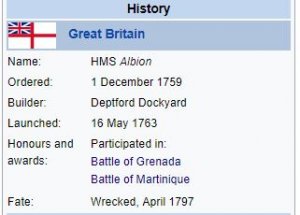


HMS Albion in a gale (PAF6082)
She saw her first action in the American War of Independence in July 1779 at the indecisive Battle of Grenada, when the British Fleet under the command of Vice Admiral Byron managed to avoid defeat from superior French forces.
Albion's next action was a year later on 17 April 1780, when British and French fleets met in the Battle of Martinique. A month later, on 15 May, the fleets met again and after a few days of manoeuvring the head of the British line confronted the rear-most French warships. Albion, leading the vanguard of the British fleet suffered heavy casualties, but with little to show for it. Just four days later the two fleets clashed for the third time but again it was indecisive with Albion heavily engaged as before, suffering numerous casualties in the process.
In 1794 Albion was consigned to the role of a 60-gun floating battery armed with heavy carronades and moored on the Thames Estuary. She was positioned in the Middle Swin, seven miles north-east of Foulness Point.

Scale: 1:48. Plan showing the body plan, sheer lines, and longitudinal half-breadth for Albion (1763), and later, by Admiralty Order dated 6 July 1778, for Irresistible (1782), both 74-gun Third Rate, two-decker. Signed by Thomas Slade [Surveyor of the Navy, 1755-1771], and later signed by John Williams [Surveyor of the Navy, 1765-1784] and Edward Hunt [Surveyor of the Navy, 1778-1784]
Fate
In April 1797, while heading to a new position in the Swin Channel, off Maplin Sands and Foulness she ran aground due to pilot error. Two days later, during salvage efforts, her back broke, and she was completely wrecked. HMS Astraea rescued Captain Henry Savage and his crew. The crew later transferred to the newly-built HMS Lancaster.
The subsequent court-martial blamed the pilots, William Springfield and Joseph Wright, for imprudent maneuvering and going too far back before altering course. The court ordered that they lose all pay due to them and they never serve as pilots again

Scale: 1:48. Plan showing the inboard profile proposed (and approved) for Albion (1763), a 74-gun Third Rate, two-decker
The Albion-class ships of the line were a class of five 74-gun third rates, designed for the Royal Navy by Sir Thomas Slade.

Design
Slade based the design of the Albion-class on the lines of the 90-gun ship Neptune.
Ships
Builder: Deptford Dockyard
Ordered: 1 December 1759
Launched: 16 May 1763
Fate: Wrecked, 1797
Builder: Deptford Dockyard
Ordered: 22 October 1767
Launched: 26 September 1771
Fate: Broken up, 1816
Builder: Deptford Dockyard
Ordered: 21 August 1774
Launched: 30 July 1779
Fate: Broken up, 1817
Builder: Randall, Rotherhithe
Ordered: 2 February 1778
Launched: 23 March 1780
Fate: Broken up, 1820
Builder: Barnard, Harwich
Ordered: 8 July 1778
Launched: 6 December 1782
Fate: Broken up, 1806

Scale: 1:48. Plan showing the framing profile (disposition) for Fortitude (1780) and Irresistible (1782), both 74-gun Third Rate, two-deckers, based on Albion (1763)
https://en.wikipedia.org/wiki/HMS_Albion_(1763)
 en.wikipedia.org
en.wikipedia.org
16 May 1763 – Launch of HMS Albion, a 74-gun third-rate ship of the line of the Royal Navy.
She was launched on 16 May 1763 at Deptford, being adapted from a design of the old 90-gun ship Neptune which had been built in 1730, and was the first ship to bear the name.
HMS Albion was a 74-gun third-rate ship of the line of the Royal Navy. She was launched on 16 May 1763 at Deptford, being adapted from a design of the old 90-gun ship Neptune which had been built in 1730, and was the first ship to bear the name. She was the first of a series of ships built to the same lines, which became known as the Albion-class ship of the line.



HMS Albion in a gale (PAF6082)
She saw her first action in the American War of Independence in July 1779 at the indecisive Battle of Grenada, when the British Fleet under the command of Vice Admiral Byron managed to avoid defeat from superior French forces.
Albion's next action was a year later on 17 April 1780, when British and French fleets met in the Battle of Martinique. A month later, on 15 May, the fleets met again and after a few days of manoeuvring the head of the British line confronted the rear-most French warships. Albion, leading the vanguard of the British fleet suffered heavy casualties, but with little to show for it. Just four days later the two fleets clashed for the third time but again it was indecisive with Albion heavily engaged as before, suffering numerous casualties in the process.
In 1794 Albion was consigned to the role of a 60-gun floating battery armed with heavy carronades and moored on the Thames Estuary. She was positioned in the Middle Swin, seven miles north-east of Foulness Point.

Scale: 1:48. Plan showing the body plan, sheer lines, and longitudinal half-breadth for Albion (1763), and later, by Admiralty Order dated 6 July 1778, for Irresistible (1782), both 74-gun Third Rate, two-decker. Signed by Thomas Slade [Surveyor of the Navy, 1755-1771], and later signed by John Williams [Surveyor of the Navy, 1765-1784] and Edward Hunt [Surveyor of the Navy, 1778-1784]
Fate
In April 1797, while heading to a new position in the Swin Channel, off Maplin Sands and Foulness she ran aground due to pilot error. Two days later, during salvage efforts, her back broke, and she was completely wrecked. HMS Astraea rescued Captain Henry Savage and his crew. The crew later transferred to the newly-built HMS Lancaster.
The subsequent court-martial blamed the pilots, William Springfield and Joseph Wright, for imprudent maneuvering and going too far back before altering course. The court ordered that they lose all pay due to them and they never serve as pilots again

Scale: 1:48. Plan showing the inboard profile proposed (and approved) for Albion (1763), a 74-gun Third Rate, two-decker
The Albion-class ships of the line were a class of five 74-gun third rates, designed for the Royal Navy by Sir Thomas Slade.

Design
Slade based the design of the Albion-class on the lines of the 90-gun ship Neptune.
Ships
Builder: Deptford Dockyard
Ordered: 1 December 1759
Launched: 16 May 1763
Fate: Wrecked, 1797
Builder: Deptford Dockyard
Ordered: 22 October 1767
Launched: 26 September 1771
Fate: Broken up, 1816
Builder: Deptford Dockyard
Ordered: 21 August 1774
Launched: 30 July 1779
Fate: Broken up, 1817
Builder: Randall, Rotherhithe
Ordered: 2 February 1778
Launched: 23 March 1780
Fate: Broken up, 1820
Builder: Barnard, Harwich
Ordered: 8 July 1778
Launched: 6 December 1782
Fate: Broken up, 1806

Scale: 1:48. Plan showing the framing profile (disposition) for Fortitude (1780) and Irresistible (1782), both 74-gun Third Rate, two-deckers, based on Albion (1763)
https://en.wikipedia.org/wiki/HMS_Albion_(1763)
Albion-class ship of the line (1763) - Wikipedia
Today in Naval History - Naval / Maritime Events in History
16 May 1797 - The action of 16 May 1797
was a naval battle that took place near Tripoli in Ottoman Tripolitania (present-day Libya).
The Danish squadron was victorious over a Tripolitan squadron that outnumbered them in terms of the number of vessels.
The result was a peace treaty between the Bey of Tripoli and Denmark.
Background
After the newly appointed Bey of Tripoli, Sidi Yussuf, demanded an increased tribute (essentially a bribe to stop Tripolitans preying on Danish merchant ships), and captured two Danish vessels, whose crews he sold into slavery, Denmark sent Captain Lorenz Fisker in the 40-gun frigate Thetis to Tripoli. He had two missions: first, to escort the annual "gift ship" to Algiers, and second, to arrange for the freeing of the two Danish vessels and their crews. He arrived at Tripoli on 30 August 1796, but failed to free the captured sailors, or even to agree a ransom price.



The Dano-Norwegian frigate Najaden leading a small Danish squadron against six corsair ships outside Tripoli, May 16, 1797.
The Action
The Danes therefore decided to make a second attempt. They sent Captain Steen Andersen Bille in the frigate Najaden 40, under Captain John Hoppe, to Malta, where she arrived on 2 May 1797. There the Danes met up with the brig Sarpen 18, under Captain Charles Christian De Holck. They also hired a xebec of six guns, and put in a Danish crew under Lieutenant Hans Munck (or Munk), of Sarpen. This squadron then sailed from Malta for Tripoli. On 12 May, off the coast of Lampedusa, they met with Fisker and Thetis. Fisker transferred command of Danish forces in the Mediterranean to Bille and sailed for home. Bille's small squadron sailed past the forts guarding Tripoli on 15 May 1797. Among the guns firing on the Danish vessels from the forts were four Danish cannons that the Libyan envoy Abderahman al Bidiri had obtained from the King of Denmark in 1772.
On 16 May Najaden sailed into the harbor and attacked the six armed vessels there. The Tripolitan forces consisted of the 28-gun xebec Meshuda, two other xebecs of similar size and three smaller vessels. Although the Danish cannon fire caused extensive casualties among the Tripolitans, they nevertheless got close to the Danish vessels and almost managed to board Najaden. Hoppe's deft maneuvering forestalled defeat. Although the two smaller Danish ships were more of a hindrance than a help, the Tripolitans retreated after two hours. Danish casualties were one killed and one wounded.
Bille then blockaded the harbor, stopping trade. Subsequent negotiations resulted in a peace treaty on 25 May. Denmark agreed to continue to pay tribute, but at a reduced rate. Bille was also able to buy the freedom of the Danish prisoners.
Aftermath
Bille remained in the Mediterranean until 1801 with a force that the Danish government increased to three frigates and two brigs. After the Danish government recalled him to become the chief of the naval defense, the Danish flotilla remained, continuing to protect Danish shipping for a few more years. Bille went on to command a division of the navy in the Battle of Copenhagen.
Ships involved
Denmark (Bille)
Najaden 40 (flag)
Sarpen 18
Unnamed xebec
Tripoli
Meshuda 28
2 other xebecs of 28 guns
3 smaller vessels
HDMS Najaden (Danish: "The Naiad") was a frigate of the Royal Dano-Norwegian Navy, which she served from 1796 to 1807 until the British captured her in 1807. While in Dano-Norwegian service she participated in an action at Tripoli, North Africa. She served the Royal Navy as the fifth rate HMS Nyaden (or Nijaden) from 1808 until 1812 when she was broken up. During her brief British service she participated in some small attacks in the Barents Sea during the Anglo-Russian War.



Design
Najaden was the first ship that the great Danish naval architect F.C.H. Hohlenberg designed after he returned home from training abroad. She had several revolutionary innovations and bore more resemblance to 19th century sailing warships than 18th century examples. HMS Nymphen was the only other member of the class.
Najaden had a slab-sided hull and the typical Hohlenberg pinkie stern, with a place for two stern chaser guns. Gardiner suggests that the pinkie stern and increased tumblehome towards the stern permitted the vessel to fire over the quarters. Naval warfare in the Baltic made extensive use of oared gunboats, which would fire on becalmed vessels from the quarter, an angle that normally broadside guns could not cover. The pinkie stern was unpopular with the British, who removed it when they refitted her.
Compared to many British frigates of the same period, her main gun deck ports were closer to the water (at 6 feet (1.8 m) when loaded with full supplies), and she had less carrying capacity for supplies. This made sense as Hohlenberg expected that her primary area for operations would be the Baltic. But it would have been difficult for her to be in full action in heavy weather in the open Atlantic.

 en.wikipedia.org
en.wikipedia.org
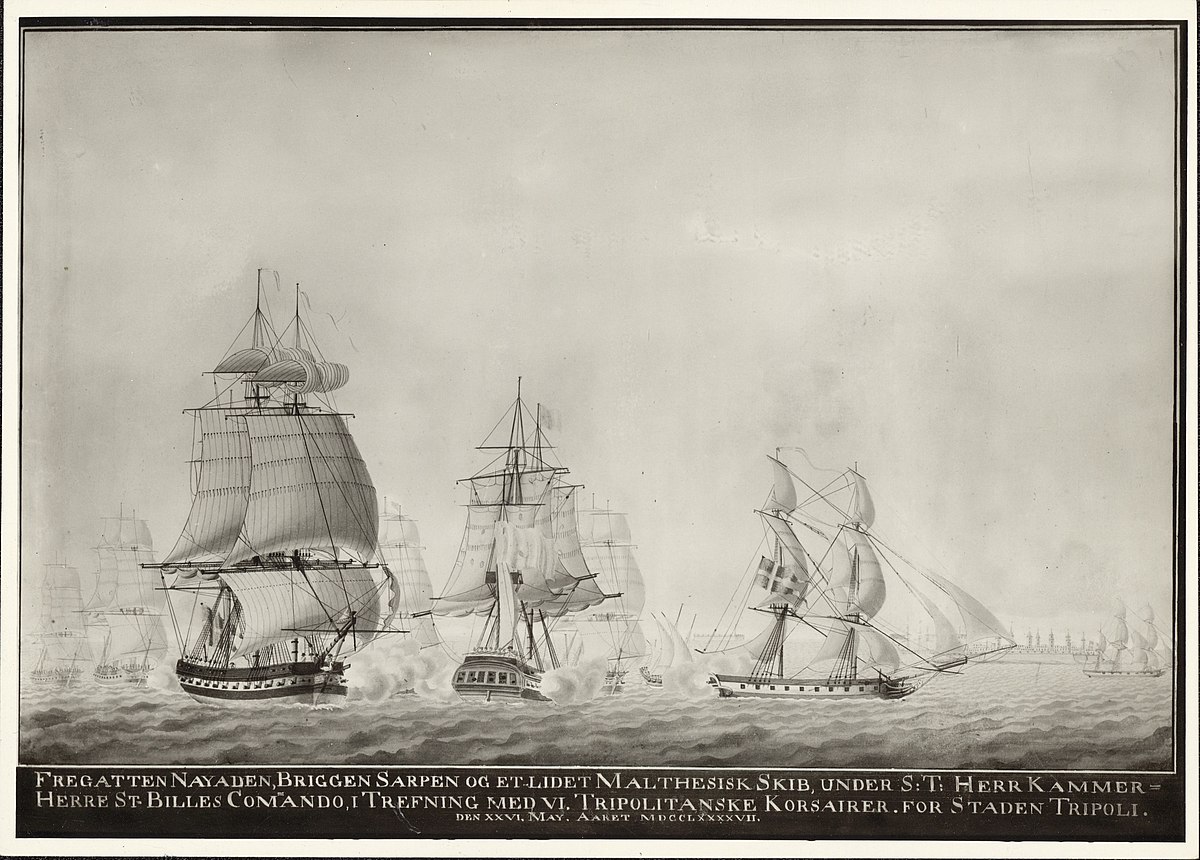
 en.wikipedia.org
en.wikipedia.org
16 May 1797 - The action of 16 May 1797
was a naval battle that took place near Tripoli in Ottoman Tripolitania (present-day Libya).
The Danish squadron was victorious over a Tripolitan squadron that outnumbered them in terms of the number of vessels.
The result was a peace treaty between the Bey of Tripoli and Denmark.
Background
After the newly appointed Bey of Tripoli, Sidi Yussuf, demanded an increased tribute (essentially a bribe to stop Tripolitans preying on Danish merchant ships), and captured two Danish vessels, whose crews he sold into slavery, Denmark sent Captain Lorenz Fisker in the 40-gun frigate Thetis to Tripoli. He had two missions: first, to escort the annual "gift ship" to Algiers, and second, to arrange for the freeing of the two Danish vessels and their crews. He arrived at Tripoli on 30 August 1796, but failed to free the captured sailors, or even to agree a ransom price.



The Dano-Norwegian frigate Najaden leading a small Danish squadron against six corsair ships outside Tripoli, May 16, 1797.
The Action
The Danes therefore decided to make a second attempt. They sent Captain Steen Andersen Bille in the frigate Najaden 40, under Captain John Hoppe, to Malta, where she arrived on 2 May 1797. There the Danes met up with the brig Sarpen 18, under Captain Charles Christian De Holck. They also hired a xebec of six guns, and put in a Danish crew under Lieutenant Hans Munck (or Munk), of Sarpen. This squadron then sailed from Malta for Tripoli. On 12 May, off the coast of Lampedusa, they met with Fisker and Thetis. Fisker transferred command of Danish forces in the Mediterranean to Bille and sailed for home. Bille's small squadron sailed past the forts guarding Tripoli on 15 May 1797. Among the guns firing on the Danish vessels from the forts were four Danish cannons that the Libyan envoy Abderahman al Bidiri had obtained from the King of Denmark in 1772.
On 16 May Najaden sailed into the harbor and attacked the six armed vessels there. The Tripolitan forces consisted of the 28-gun xebec Meshuda, two other xebecs of similar size and three smaller vessels. Although the Danish cannon fire caused extensive casualties among the Tripolitans, they nevertheless got close to the Danish vessels and almost managed to board Najaden. Hoppe's deft maneuvering forestalled defeat. Although the two smaller Danish ships were more of a hindrance than a help, the Tripolitans retreated after two hours. Danish casualties were one killed and one wounded.
Bille then blockaded the harbor, stopping trade. Subsequent negotiations resulted in a peace treaty on 25 May. Denmark agreed to continue to pay tribute, but at a reduced rate. Bille was also able to buy the freedom of the Danish prisoners.
Aftermath
Bille remained in the Mediterranean until 1801 with a force that the Danish government increased to three frigates and two brigs. After the Danish government recalled him to become the chief of the naval defense, the Danish flotilla remained, continuing to protect Danish shipping for a few more years. Bille went on to command a division of the navy in the Battle of Copenhagen.
Ships involved
Denmark (Bille)
Najaden 40 (flag)
Sarpen 18
Unnamed xebec
Tripoli
Meshuda 28
2 other xebecs of 28 guns
3 smaller vessels
HDMS Najaden (Danish: "The Naiad") was a frigate of the Royal Dano-Norwegian Navy, which she served from 1796 to 1807 until the British captured her in 1807. While in Dano-Norwegian service she participated in an action at Tripoli, North Africa. She served the Royal Navy as the fifth rate HMS Nyaden (or Nijaden) from 1808 until 1812 when she was broken up. During her brief British service she participated in some small attacks in the Barents Sea during the Anglo-Russian War.



Design
Najaden was the first ship that the great Danish naval architect F.C.H. Hohlenberg designed after he returned home from training abroad. She had several revolutionary innovations and bore more resemblance to 19th century sailing warships than 18th century examples. HMS Nymphen was the only other member of the class.
Najaden had a slab-sided hull and the typical Hohlenberg pinkie stern, with a place for two stern chaser guns. Gardiner suggests that the pinkie stern and increased tumblehome towards the stern permitted the vessel to fire over the quarters. Naval warfare in the Baltic made extensive use of oared gunboats, which would fire on becalmed vessels from the quarter, an angle that normally broadside guns could not cover. The pinkie stern was unpopular with the British, who removed it when they refitted her.
Compared to many British frigates of the same period, her main gun deck ports were closer to the water (at 6 feet (1.8 m) when loaded with full supplies), and she had less carrying capacity for supplies. This made sense as Hohlenberg expected that her primary area for operations would be the Baltic. But it would have been difficult for her to be in full action in heavy weather in the open Atlantic.

Action of 16 May 1797 - Wikipedia

HDMS Najaden (1796) - Wikipedia
Today in Naval History - Naval / Maritime Events in History
16 May 1802 - The First Battle of Tripoli Harbor was a naval battle fought on May 16, 1802 in Tripoli Harbor between a combined force consisting of the American frigate USS Boston and two Swedish Navy frigates against several Tripolitan Barbary corsairs.
The First Battle of Tripoli Harbor was a naval battle fought on May 16, 1802 in Tripoli Harbor between a combined force consisting of the American frigate USS Boston and two Swedish Navy frigates against several Tripolitan Barbary corsairs. The Swedish-American force was enforcing the blockade when an engagement broke out between it and Tripolitan forces. The Allied fleet damaged the Tripolitan squadron as well as the harbor fortifications before withdrawing and resuming the blockade.
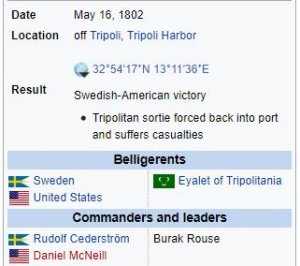
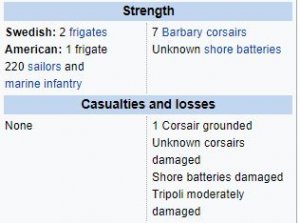
Background
USS Boston under Captain McNeill had been sent to Tripoli to blockade the port and prevent any ships from entering or leaving. Leaving for Tripoli in January she discovered that four Swedish ships had already begun a blockade of the port. Along with the Swedish vessels she attempted to chase down corsairs attempting to break the blockade with little success, as the Swedish vessels were quite large and cumbersome making it difficult for them to pursue the small Tripolitan galleys that darted in and out of the port's harbor.

USS Boston
Battle
On May 16, Boston with the Swedish frigate Fröja managed to chase down a Tripolitan corsair (a ship owned and staffed by Muslim Slave Traders), disabling it by forcing it to beach itself. Six other corsairs then sortied from the harbor in an attempt to screen the first one. The American and Swedish frigates managed to deter their attempts until another ship arrived in the harbor. The Swedish frigate began bombarding the harbor fortifications while Boston left to meet the new vessel. This gave the corsairs an opportunity to make another attempt at assisting the beached vessel. Shortly thereafter Boston realized that the newly arrived ship was merely another Swedish frigate. Realizing his mistake, Captain McNeil turned his ship around and engaged the Tripolitan ships once more firing several broadsides into them and damaging several. The action then concluded with the three frigates resuming their blockade stations having taken no damage while inflicting several losses on the enemy.
Aftermath
The action did little to prevent corsairs from using Tripoli as a base of operations. Besides this action, no other serious attempt was made by the blockading squadron to enforce the blockade. USS Constellation later arrived to bolster the attempt at denying the harbors use by the Tripolitans. The Swedish decided to make their own peace with Tripoli, leaving the two American frigates to enforce the blockade themselves, but the Americans soon ran short of provisions and also withdrew, thereby lifting the blockade and leaving the port open to the enemy.
The third USS Boston was a 32-gun wooden-hulled, three-masted frigate of the United States Navy. Boston was built by public subscription in Boston under the Act of 30 June 1798. Boston was active during the Quasi-War with France and the First Barbary War. On 12 October 1800, Boston engaged and captured the French corvette Berceau. Boston was laid up in 1802, and considered not worth repairing at the outbreak of the War of 1812. She was burned at the Washington Naval Yard on 24 August 1814 to prevent her capture by British forces.


Design and Construction
Boston was designed and constructed by Edmund Hartt at Boston, Massachusetts. Boston was authorized by the Naval Act of 1798 [fr] funded by the donations from the people of Boston, Massachusetts as part of the group of ships built by the states to supplement the Original six frigates of the United States Navy provided by the Naval Act of 1794.
The frigate has a displacement of 400 tons and had a length between perpendiculars of 134 feet (41 m). She was originally armed with twenty-four 9-pounder and eight 6-pounder guns, and carried a complement of 220 officers and men. She was launched on 20 May 1799 and commissioned soon afterwards, Captain George Little in command.
Service history
Boston cruised in the West Indies (July 1799 – June 1800) protecting American commerce against French privateers. Returning to Boston 25 June 1800, she cruised along the American coast until September when she sailed to the Guadeloupe Station in the West Indies. In 22°52′N 52°56′W, on 12 October 1800, she engaged and captured the French corvette Berceau. Boston lost seven killed and eight wounded in the encounter. She towed her prize to Boston, arriving in November. During her West Indian cruises Boston captured seven additional prizes (two in conjunction with USS General Greene).
During the winter of 1801 Boston carried Minister Livingston to France and then joined the Mediterranean Squadron off Tripoli while under the command of Captain Daniel McNeill. She fought an action with six or seven Tripolitanian gunboats on 16 May 1802, forcing one ashore. Boston returned to Boston in October 1802 and then proceeded to Washington where she was laid up. Considered not worth repairing on the outbreak of the War of 1812, she remained at Washington until 24 August 1814 when she was burned to prevent her falling into British hands.

 en.wikipedia.org
en.wikipedia.org

 en.wikipedia.org
en.wikipedia.org
16 May 1802 - The First Battle of Tripoli Harbor was a naval battle fought on May 16, 1802 in Tripoli Harbor between a combined force consisting of the American frigate USS Boston and two Swedish Navy frigates against several Tripolitan Barbary corsairs.
The First Battle of Tripoli Harbor was a naval battle fought on May 16, 1802 in Tripoli Harbor between a combined force consisting of the American frigate USS Boston and two Swedish Navy frigates against several Tripolitan Barbary corsairs. The Swedish-American force was enforcing the blockade when an engagement broke out between it and Tripolitan forces. The Allied fleet damaged the Tripolitan squadron as well as the harbor fortifications before withdrawing and resuming the blockade.


Background
USS Boston under Captain McNeill had been sent to Tripoli to blockade the port and prevent any ships from entering or leaving. Leaving for Tripoli in January she discovered that four Swedish ships had already begun a blockade of the port. Along with the Swedish vessels she attempted to chase down corsairs attempting to break the blockade with little success, as the Swedish vessels were quite large and cumbersome making it difficult for them to pursue the small Tripolitan galleys that darted in and out of the port's harbor.

USS Boston
Battle
On May 16, Boston with the Swedish frigate Fröja managed to chase down a Tripolitan corsair (a ship owned and staffed by Muslim Slave Traders), disabling it by forcing it to beach itself. Six other corsairs then sortied from the harbor in an attempt to screen the first one. The American and Swedish frigates managed to deter their attempts until another ship arrived in the harbor. The Swedish frigate began bombarding the harbor fortifications while Boston left to meet the new vessel. This gave the corsairs an opportunity to make another attempt at assisting the beached vessel. Shortly thereafter Boston realized that the newly arrived ship was merely another Swedish frigate. Realizing his mistake, Captain McNeil turned his ship around and engaged the Tripolitan ships once more firing several broadsides into them and damaging several. The action then concluded with the three frigates resuming their blockade stations having taken no damage while inflicting several losses on the enemy.
Aftermath
The action did little to prevent corsairs from using Tripoli as a base of operations. Besides this action, no other serious attempt was made by the blockading squadron to enforce the blockade. USS Constellation later arrived to bolster the attempt at denying the harbors use by the Tripolitans. The Swedish decided to make their own peace with Tripoli, leaving the two American frigates to enforce the blockade themselves, but the Americans soon ran short of provisions and also withdrew, thereby lifting the blockade and leaving the port open to the enemy.
The third USS Boston was a 32-gun wooden-hulled, three-masted frigate of the United States Navy. Boston was built by public subscription in Boston under the Act of 30 June 1798. Boston was active during the Quasi-War with France and the First Barbary War. On 12 October 1800, Boston engaged and captured the French corvette Berceau. Boston was laid up in 1802, and considered not worth repairing at the outbreak of the War of 1812. She was burned at the Washington Naval Yard on 24 August 1814 to prevent her capture by British forces.


Design and Construction
Boston was designed and constructed by Edmund Hartt at Boston, Massachusetts. Boston was authorized by the Naval Act of 1798 [fr] funded by the donations from the people of Boston, Massachusetts as part of the group of ships built by the states to supplement the Original six frigates of the United States Navy provided by the Naval Act of 1794.
The frigate has a displacement of 400 tons and had a length between perpendiculars of 134 feet (41 m). She was originally armed with twenty-four 9-pounder and eight 6-pounder guns, and carried a complement of 220 officers and men. She was launched on 20 May 1799 and commissioned soon afterwards, Captain George Little in command.
Service history
Boston cruised in the West Indies (July 1799 – June 1800) protecting American commerce against French privateers. Returning to Boston 25 June 1800, she cruised along the American coast until September when she sailed to the Guadeloupe Station in the West Indies. In 22°52′N 52°56′W, on 12 October 1800, she engaged and captured the French corvette Berceau. Boston lost seven killed and eight wounded in the encounter. She towed her prize to Boston, arriving in November. During her West Indian cruises Boston captured seven additional prizes (two in conjunction with USS General Greene).
During the winter of 1801 Boston carried Minister Livingston to France and then joined the Mediterranean Squadron off Tripoli while under the command of Captain Daniel McNeill. She fought an action with six or seven Tripolitanian gunboats on 16 May 1802, forcing one ashore. Boston returned to Boston in October 1802 and then proceeded to Washington where she was laid up. Considered not worth repairing on the outbreak of the War of 1812, she remained at Washington until 24 August 1814 when she was burned to prevent her falling into British hands.

First Battle of Tripoli Harbor - Wikipedia

USS Boston (1799) - Wikipedia
Today in Naval History - Naval / Maritime Events in History
16 May 1807 - HMS Dauntless (22), Christopher Strachey, surrendered to the French at Danzig after grounding.
The first HMS Dauntless was a sixth-rate Combatant-class sloop of the Royal Navy. She was launched in 1804 and the French captured her in 1807 at Danzig. The French Navy took her into service as Sans Peur, but her subsequent fate is unknown.

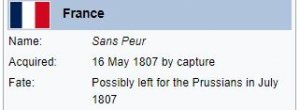


HMS Dauntless aground, by Benjamin Zix / Surrender of HMS Dauntless
Design
She was built in Hull at the William Gibson Shipyard, as one of a class of three (the others being Combatant and Valorous) and launched in 1804. Designed by John Staniforth MP, they were flush-decked, shallow draught and (for their dimensions) heavily armed. Rated as a sloop, she had a design based on the Danish Praam (English Pram), allowing the combination of heavy armament with a draught of only 11 feet. Her design may well have been influenced by the flush-decked, shallow draught vessels of Napoleon's invasion fleet, although Dauntless and her sisters were significantly larger. The Royal Navy rated her for purposes of command as an 18-gun sloop, but as a captain's command until 1806.
Career
Captain Hugh Pigot commissioned Dauntless in March 1805, serving with the anti-invasion flotillas stationed in The Downs. In July she was under the command of Captain Charles Jones on the North Sea station.
In March 1806 Commander William Cook replaced Jones. However, in October 1806, Commander Christopher Strachey replaced Cook.
In the spring of 1807 she and her sisters were ordered to the Baltic where their characteristics would be of value as convoy escorts and particularly in support of operations ashore. On 13 May Dauntless was ordered to sail up the Vistula and break through the French armies besieging Danzig (now Gdansk) in order to supply the encircled Prussians with 600 barrels of gunpowder. Heavily laden and making upriver under a press of sail, Dauntless became unmanageable and broached to. Running hard aground on a sandbank within easy range of French artillery, she suffered an hour's bombardment before surrendering. Napoleon himself is reputed to have said that her resistance "was worthy of being placed on the page of history". Strachey then remained a French prisoner until the end of the war. At the obligatory court martial her captain, Christopher Strachey, was honourably acquitted of all blame for the surrender of his ship.
Fate
The French Navy took Dauntless into service as Sans Peur. Her ultimate fate is unknown, but she may have fallen into Prussian hands in July when Napoleon handed Danzig over to the Prussians.

Scale: 1:48. A contemporary copy of a plan showing the body plan, sheer lines and longitudinal half-breadth for Dauntless (1804) and Valorous (1804), both 18-gun Ship Sloops proposed by Mr John Stainforth, MP. They were originally proposed as 24-gun Gun Vessels. The plan was accepted with alterations, including the addition of a forecastle deck and alterations to the gunports and lower deck. Later in 1805 the head of all three ships was modified. They were then registered as Ships not Gun Vessels

Scale: 1:48. Plan showing the inboard profile for Dauntless (1804) and Valorous (1804), both 18-gun Ship Sloops building at Hull by Mr Blunt. The plan includes alterations proposed by Mr Stainforth, MP. Signed by John Henslow [Surveyor of the Navy, 1784-1806]
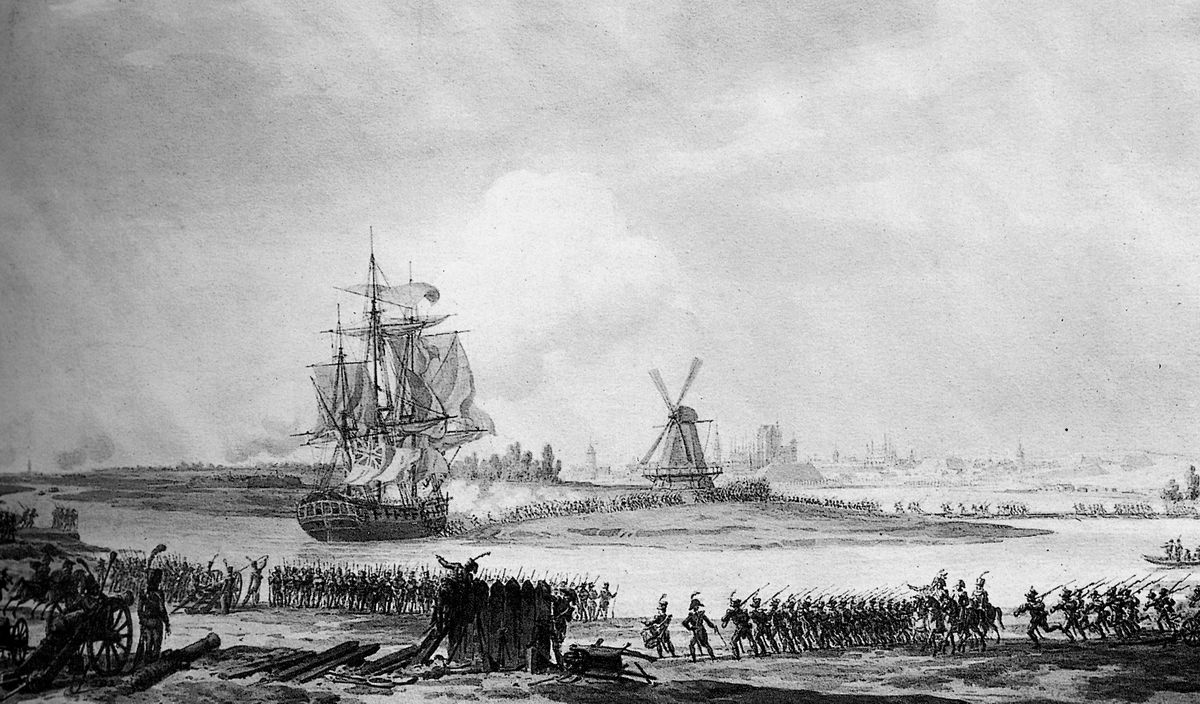
 en.wikipedia.org
en.wikipedia.org
16 May 1807 - HMS Dauntless (22), Christopher Strachey, surrendered to the French at Danzig after grounding.
The first HMS Dauntless was a sixth-rate Combatant-class sloop of the Royal Navy. She was launched in 1804 and the French captured her in 1807 at Danzig. The French Navy took her into service as Sans Peur, but her subsequent fate is unknown.




HMS Dauntless aground, by Benjamin Zix / Surrender of HMS Dauntless
Design
She was built in Hull at the William Gibson Shipyard, as one of a class of three (the others being Combatant and Valorous) and launched in 1804. Designed by John Staniforth MP, they were flush-decked, shallow draught and (for their dimensions) heavily armed. Rated as a sloop, she had a design based on the Danish Praam (English Pram), allowing the combination of heavy armament with a draught of only 11 feet. Her design may well have been influenced by the flush-decked, shallow draught vessels of Napoleon's invasion fleet, although Dauntless and her sisters were significantly larger. The Royal Navy rated her for purposes of command as an 18-gun sloop, but as a captain's command until 1806.
Career
Captain Hugh Pigot commissioned Dauntless in March 1805, serving with the anti-invasion flotillas stationed in The Downs. In July she was under the command of Captain Charles Jones on the North Sea station.
In March 1806 Commander William Cook replaced Jones. However, in October 1806, Commander Christopher Strachey replaced Cook.
In the spring of 1807 she and her sisters were ordered to the Baltic where their characteristics would be of value as convoy escorts and particularly in support of operations ashore. On 13 May Dauntless was ordered to sail up the Vistula and break through the French armies besieging Danzig (now Gdansk) in order to supply the encircled Prussians with 600 barrels of gunpowder. Heavily laden and making upriver under a press of sail, Dauntless became unmanageable and broached to. Running hard aground on a sandbank within easy range of French artillery, she suffered an hour's bombardment before surrendering. Napoleon himself is reputed to have said that her resistance "was worthy of being placed on the page of history". Strachey then remained a French prisoner until the end of the war. At the obligatory court martial her captain, Christopher Strachey, was honourably acquitted of all blame for the surrender of his ship.
Fate
The French Navy took Dauntless into service as Sans Peur. Her ultimate fate is unknown, but she may have fallen into Prussian hands in July when Napoleon handed Danzig over to the Prussians.

Scale: 1:48. A contemporary copy of a plan showing the body plan, sheer lines and longitudinal half-breadth for Dauntless (1804) and Valorous (1804), both 18-gun Ship Sloops proposed by Mr John Stainforth, MP. They were originally proposed as 24-gun Gun Vessels. The plan was accepted with alterations, including the addition of a forecastle deck and alterations to the gunports and lower deck. Later in 1805 the head of all three ships was modified. They were then registered as Ships not Gun Vessels

Scale: 1:48. Plan showing the inboard profile for Dauntless (1804) and Valorous (1804), both 18-gun Ship Sloops building at Hull by Mr Blunt. The plan includes alterations proposed by Mr Stainforth, MP. Signed by John Henslow [Surveyor of the Navy, 1784-1806]

HMS Dauntless (1804) - Wikipedia
Today in Naval History - Naval / Maritime Events in History
16 May 1808 - Battle of Alvøen
was a sea battle of the Gunboat War between Denmark-Norway and the United Kingdom. It was fought on 16 May 1808 in Vatlestraumen, outside Bergen in Norway, between the British frigate HMS Tartar and a Norwegian force consisting of four kanonjolles and one kanonsjalupps (collectively known as gunboats).
The Battle of Alvøen was a sea battle of the Gunboat War between Denmark-Norway and the United Kingdom. It was fought on 16 May 1808 in Vatlestraumen, outside Bergen in Norway, between the British frigate HMS Tartar and a Norwegian force consisting of four kanonjolles and one kanonsjalupps (collectively known as gunboats).


The British Royal Navy was then blockading the coast of Norway, causing major difficulties since the country was then dependent on Danish imports of grain and other foodstuffs. Having lost their fleet in the Battle of Copenhagen in 1807, Denmark-Norway was unable to afford the time or money to rebuild their high-seas fleet of corvettes, frigates and ships of the line and so had been forced to construct small vessels or gunboats for coastal defence.
The British frigate was underway to Bergen harbour in search of a Dutch privateer named Gelderland, known by the British to be seeking shelter in the harbour during repairs. On the evening on 15 May, a message was received at Bergenhus Fortress stating that a British frigate had been sighted, and was probably heading towards Bergen. After the frigate had been sighted at Alvøen, near Bergen, on 16 May, the five vessels making up the entire Norwegian sea force in the Bergen region were ordered to row out and engage the enemy. The frigate lay becalmed outside Alvøen, and in thick fog. The Norwegian vessels took up a position between Alvøen and the frigate, and opened fire. The battle lasted about one hour, during which the British lost 12 men, including Post Captain Bettesworth, commander of the frigate. Norwegian losses were five men and several wounded.

HMS Tartar attacked by Danish-Norwegian gunboats in the Battle of Alvøen
Background
The years from 1807 until 1814 were hard times for Norway. They fell during the Napoleonic Wars, which raged from 1800–1815, and which the united kingdoms of Norway and Denmark entered in 1807. After "the theft of the fleet" in 1807, when the entire Danish-Norwegian fleet was confiscated and sailed to Britain after the British victory at Copenhagen, Denmark-Norway moved from 'armed neutrality' to fighting against Britain. The British fleet blockaded the Skagerrak and cruised along the Norwegian coast, capturing merchant vessels as prizes and attacking coastal convoys. The Norwegian population depended on the import of grain from other countries, particularly Denmark, but supplies dried up as the British navy captured the merchant vessels carrying them. The Henrik Ibsen poem "Terje Vigen" occurs during this period and describes a poor pilot's risky journey from the south of Norway to Denmark to buy grain in order to feed his wife and child. He is captured near the coast of Norway on his way back from Denmark, and sent to prison in England.
With the loss of the high seas fleet, and the blockade of the Norwegian coast, the two countries were left to design and build a coastal defence system. As funds were lacking to construct even smaller vessels in sufficient numbers, people were urged to give money and valuables to raise funds for the construction of gunboats:
Another important factor was the privateers, civil ships granted letters of marque by the Danish government legally allowing them to engage and seize enemy vessels along the country's coast and retaining 99% of these vessels' value so long as 1% of it was then given to the government. Norwegian privateers operated as far as Scotland, and merchants began to demand better protection from the Royal Navy. As a result, the Royal Navy sent even more warships to the Norwegian coast, trying to prevent the privateers from ever reaching the open sea and any trading ships from entering Norwegian waters.

Tartar (with several of her cannonballs landing in the water behind the gunboats) and the five gunboats (flying the Danish flag) at the entrance to Alvøen - this image hangs in Alvøen's hovedbygning.
Context
In May 1808, a Dutch frigate named Gelderland entered Bergen harbour seeking a sheltered spot to conduct repairs. Several privateers were also present in the harbour. The Royal Navy received intelligence about the Dutch frigate, and sent the frigates Tartar, Adrianeand the corvette Cygnet from Leith in Scotland on 10 May, with orders to intercept the frigate and report on its movements. On 7 May, Gelderland had left Bergen; at least that is what local fishermen told Post Captain George Edmund Byron Bettesworth when Tartarentered the area of Stolmen west of Bergen on 15 May.

Scale 1:48. Plan showing the body plan, sheer lines with later alterations to gun ports and longitudinal half breadth proposed and approved for Narcissus (1801), and later Tartar (1801), both 32-gun, Fifth Rate Frigates. The plan also relate to Cornelia (1808), of the same class. Signed J. Henslow and W.Rule. (Surveyors of the navy)
Some sources claim that Tartar was flying Dutch colours upon entering Norwegian waters on 15 May, and was therefore unsuspected, since the Netherlands were then an ally of Denmark-Norway against Britain. Norwegian fishermen and pilots sailed out in small boats to welcome the vessel and to offer their assistance as pilots - the Dutch flag might have fooled them into thinking the Tartar was the Gelderland returning. The pilots would have rushed to the vessel since the first there would get the job of piloting that vessel but, upon arrival, the pilots and fishermen were taken prisoner and forced to guide the vessel in through the narrow fjords leading to Bergen. They were tried by the Norwegian authorities after the battle and a transcript of their interrogation tells of what happened next:
The Norwegians on board were eventually designated as prisoners and mostly held below decks on the Tartar, with only one or two of them kept on deck to guide the frigate into Bergen. The Tartar anchored off Bjorøyhamn on the evening of 15 May, where she was observed by inhabitants of Alvøen, and sent out four light boats to reconnoitre further in towards Bergen, find out which vessels were lying in its harbour and (last but not least) "bring out the shipping" (i.e. tempt or tow the shipping to sail out from the port and thus pass the Tartar).

Drawing of a kanonsjalupp - though the gunboats at Alvøen were to a different design particular to the area, this gives some idea as to their size and dimensions.
https://en.wikipedia.org/wiki/Battle_of_Alvøen

 en.wikipedia.org
en.wikipedia.org
16 May 1808 - Battle of Alvøen
was a sea battle of the Gunboat War between Denmark-Norway and the United Kingdom. It was fought on 16 May 1808 in Vatlestraumen, outside Bergen in Norway, between the British frigate HMS Tartar and a Norwegian force consisting of four kanonjolles and one kanonsjalupps (collectively known as gunboats).
The Battle of Alvøen was a sea battle of the Gunboat War between Denmark-Norway and the United Kingdom. It was fought on 16 May 1808 in Vatlestraumen, outside Bergen in Norway, between the British frigate HMS Tartar and a Norwegian force consisting of four kanonjolles and one kanonsjalupps (collectively known as gunboats).


The British Royal Navy was then blockading the coast of Norway, causing major difficulties since the country was then dependent on Danish imports of grain and other foodstuffs. Having lost their fleet in the Battle of Copenhagen in 1807, Denmark-Norway was unable to afford the time or money to rebuild their high-seas fleet of corvettes, frigates and ships of the line and so had been forced to construct small vessels or gunboats for coastal defence.
The British frigate was underway to Bergen harbour in search of a Dutch privateer named Gelderland, known by the British to be seeking shelter in the harbour during repairs. On the evening on 15 May, a message was received at Bergenhus Fortress stating that a British frigate had been sighted, and was probably heading towards Bergen. After the frigate had been sighted at Alvøen, near Bergen, on 16 May, the five vessels making up the entire Norwegian sea force in the Bergen region were ordered to row out and engage the enemy. The frigate lay becalmed outside Alvøen, and in thick fog. The Norwegian vessels took up a position between Alvøen and the frigate, and opened fire. The battle lasted about one hour, during which the British lost 12 men, including Post Captain Bettesworth, commander of the frigate. Norwegian losses were five men and several wounded.

HMS Tartar attacked by Danish-Norwegian gunboats in the Battle of Alvøen
Background
The years from 1807 until 1814 were hard times for Norway. They fell during the Napoleonic Wars, which raged from 1800–1815, and which the united kingdoms of Norway and Denmark entered in 1807. After "the theft of the fleet" in 1807, when the entire Danish-Norwegian fleet was confiscated and sailed to Britain after the British victory at Copenhagen, Denmark-Norway moved from 'armed neutrality' to fighting against Britain. The British fleet blockaded the Skagerrak and cruised along the Norwegian coast, capturing merchant vessels as prizes and attacking coastal convoys. The Norwegian population depended on the import of grain from other countries, particularly Denmark, but supplies dried up as the British navy captured the merchant vessels carrying them. The Henrik Ibsen poem "Terje Vigen" occurs during this period and describes a poor pilot's risky journey from the south of Norway to Denmark to buy grain in order to feed his wife and child. He is captured near the coast of Norway on his way back from Denmark, and sent to prison in England.
With the loss of the high seas fleet, and the blockade of the Norwegian coast, the two countries were left to design and build a coastal defence system. As funds were lacking to construct even smaller vessels in sufficient numbers, people were urged to give money and valuables to raise funds for the construction of gunboats:
Lacking a proper navy and without larger vessels in sufficient numbers, Denmark-Norway clearly needed a defensive strategy. What naval powers the country still had could only hope to prevent British warships from attacking Norwegian trading vessels, and this was what they attempted to do. The coastal trade was extremely important to prevent starvation - fish from northern Norway were traded for grain from areas south of Norway, especially Denmark. Naval forces of small gunboats were placed at strategic positions along the coast, with the naval commander in chief ordering each one out as and when enemy activity was reported in their operating area.You all know the state of our Country. A deceitful enemy has robbed us of our defence, the Danish Fleet. The country is exposed to attacks from the sea. The government is working hard on a solution, and every honourable citizen and subject should work towards the common goal: National defence and the independence of our country [of Denmark-Norway] and to the construction of gunboats, contributing trees from the forest, gold, silver and money. We should not sit back idle, insensitive and indifferent - we are our country's sons and our king's citizens, and we should not make ourselves unworthy to bear the name of noble Norwegian men, because we did not participate in the struggle for the defence of our country.
Another important factor was the privateers, civil ships granted letters of marque by the Danish government legally allowing them to engage and seize enemy vessels along the country's coast and retaining 99% of these vessels' value so long as 1% of it was then given to the government. Norwegian privateers operated as far as Scotland, and merchants began to demand better protection from the Royal Navy. As a result, the Royal Navy sent even more warships to the Norwegian coast, trying to prevent the privateers from ever reaching the open sea and any trading ships from entering Norwegian waters.

Tartar (with several of her cannonballs landing in the water behind the gunboats) and the five gunboats (flying the Danish flag) at the entrance to Alvøen - this image hangs in Alvøen's hovedbygning.
Context
In May 1808, a Dutch frigate named Gelderland entered Bergen harbour seeking a sheltered spot to conduct repairs. Several privateers were also present in the harbour. The Royal Navy received intelligence about the Dutch frigate, and sent the frigates Tartar, Adrianeand the corvette Cygnet from Leith in Scotland on 10 May, with orders to intercept the frigate and report on its movements. On 7 May, Gelderland had left Bergen; at least that is what local fishermen told Post Captain George Edmund Byron Bettesworth when Tartarentered the area of Stolmen west of Bergen on 15 May.

Scale 1:48. Plan showing the body plan, sheer lines with later alterations to gun ports and longitudinal half breadth proposed and approved for Narcissus (1801), and later Tartar (1801), both 32-gun, Fifth Rate Frigates. The plan also relate to Cornelia (1808), of the same class. Signed J. Henslow and W.Rule. (Surveyors of the navy)
Some sources claim that Tartar was flying Dutch colours upon entering Norwegian waters on 15 May, and was therefore unsuspected, since the Netherlands were then an ally of Denmark-Norway against Britain. Norwegian fishermen and pilots sailed out in small boats to welcome the vessel and to offer their assistance as pilots - the Dutch flag might have fooled them into thinking the Tartar was the Gelderland returning. The pilots would have rushed to the vessel since the first there would get the job of piloting that vessel but, upon arrival, the pilots and fishermen were taken prisoner and forced to guide the vessel in through the narrow fjords leading to Bergen. They were tried by the Norwegian authorities after the battle and a transcript of their interrogation tells of what happened next:
Tartar sailed into what is now Marstein fyr (holmen Marsteinen). To the south, at Sotra, near Kleppe (Kleppholmen), was an optical telegraph station, part of the telegraph system along the coast. This station observed the frigate, still flying a Dutch flag and not thought to be a threat, and the station's head (carrying the signal book) and his assistant rowed out to the frigate, but were both taken prisoner, thus breaking Bergen's chain of signal stations and putting an important part of the city's defences out of action.The defendant and the three previously mentioned Men, plus Rasmus Andersen Øvre Waage and Johannes Johannesen Søre Aarland: altogether six Men, then went out to the frigate in a small boat. -When they had come a brief distance from Shore, they sighted the pilots Jacob Jacobsen Nedre Waage and Ole Johannesen Øvre Waage or Stolmevaagen, plus the fishermen Ole Hansen Nedre Waage, Johannes Anderssen Nedre Waage, Lars Nielsen Øvre Waage and Lars Olsen Stolmevogen, also pulling for the frigate, which they boarded at about 10 am Sunday, though the defendant and his crew arrived first, although the other men tried to reach the frigate first; when they came aboard, the defendant was shown to the Captain's quarters alone, whom, via a mere seaman who spoke Norwegian, asked the defendant if he could pilot the ship into Bergen, to which the defendant answered Yes! But he also asked where the ship came from, to which the translator answered that the ship came from Dover. The seaman convinced the defendant that the ship was French, and as the defendant does not know where Dover is, he assumed what was presented to him by the translator was true.
The Chief thereafter showed the defendant a large stock of golden money lying on a plate, and told the defendant that he would be given this money by the Chief if he could take the frigate to Bergen. -
The defendant answered that he would claim no more than what the King's regulations allowed him, and then asked the ship's Draught, whereupon he received an answer. - The Chief then took the money away, and the defendant did not receive any of it.
— National Archives in Bergen, copy of court documents printed during interviews of the Norwegian pilots and fishermen conducted during 1808 and 1809: Sorenskrivaren i Sunnhordland I.A. 46, tingbok 1807-1812, fol. 86b-89b. The text is translated from old Norwegian (Danish).
The Norwegians on board were eventually designated as prisoners and mostly held below decks on the Tartar, with only one or two of them kept on deck to guide the frigate into Bergen. The Tartar anchored off Bjorøyhamn on the evening of 15 May, where she was observed by inhabitants of Alvøen, and sent out four light boats to reconnoitre further in towards Bergen, find out which vessels were lying in its harbour and (last but not least) "bring out the shipping" (i.e. tempt or tow the shipping to sail out from the port and thus pass the Tartar).

Drawing of a kanonsjalupp - though the gunboats at Alvøen were to a different design particular to the area, this gives some idea as to their size and dimensions.
https://en.wikipedia.org/wiki/Battle_of_Alvøen


